ICOM orporated IC-2720H Amateur Transceiver with Scanning Receiver User Manual IC 2720H Instruction Manual
ICOM Incorporated Amateur Transceiver with Scanning Receiver IC 2720H Instruction Manual
Users Manual
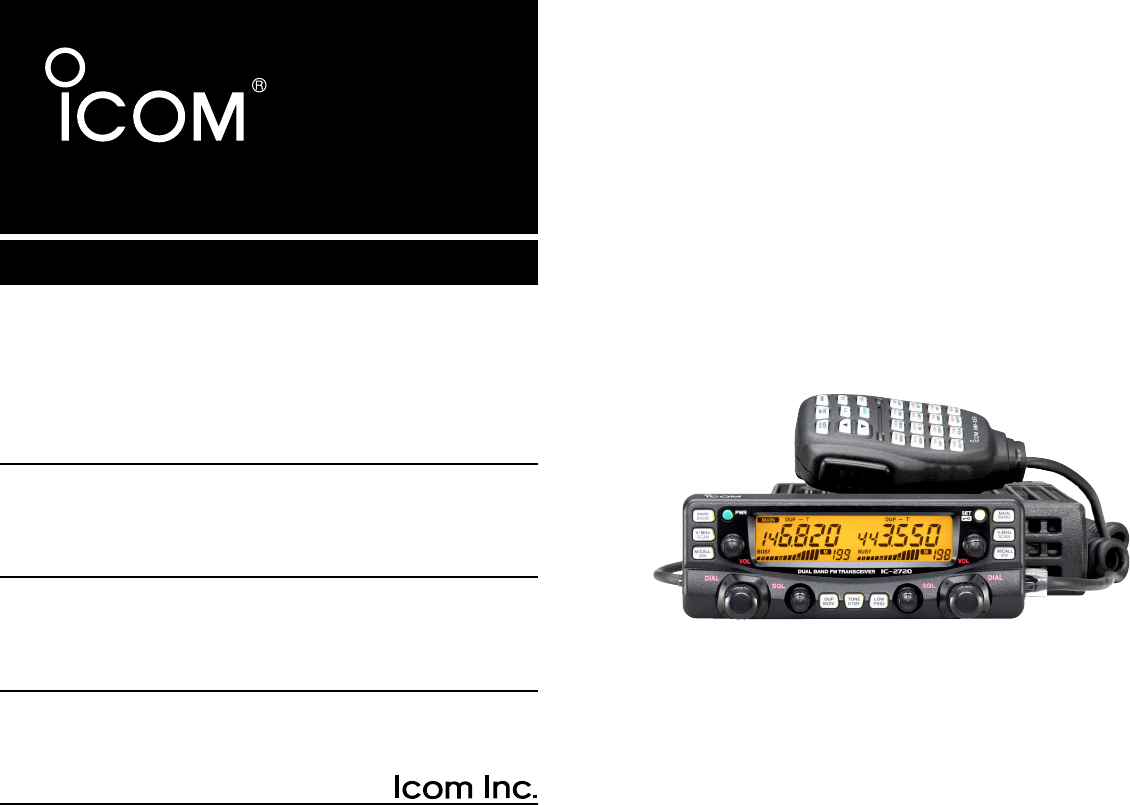
INSTRUCTION MANUAL
i2720H
DUAL BAND FM TRANSCEIVER
This device complies with Part 15 of the FCC rules. Operation is sub-
ject to the following two conditions: (1) This device may not cause
harmful interference, and (2) this device must accept any interference
received, including interference that may cause undesired operation.
New2001
IC-2720H.qxd 02.9.9 8:12 Page 1 (1,1)
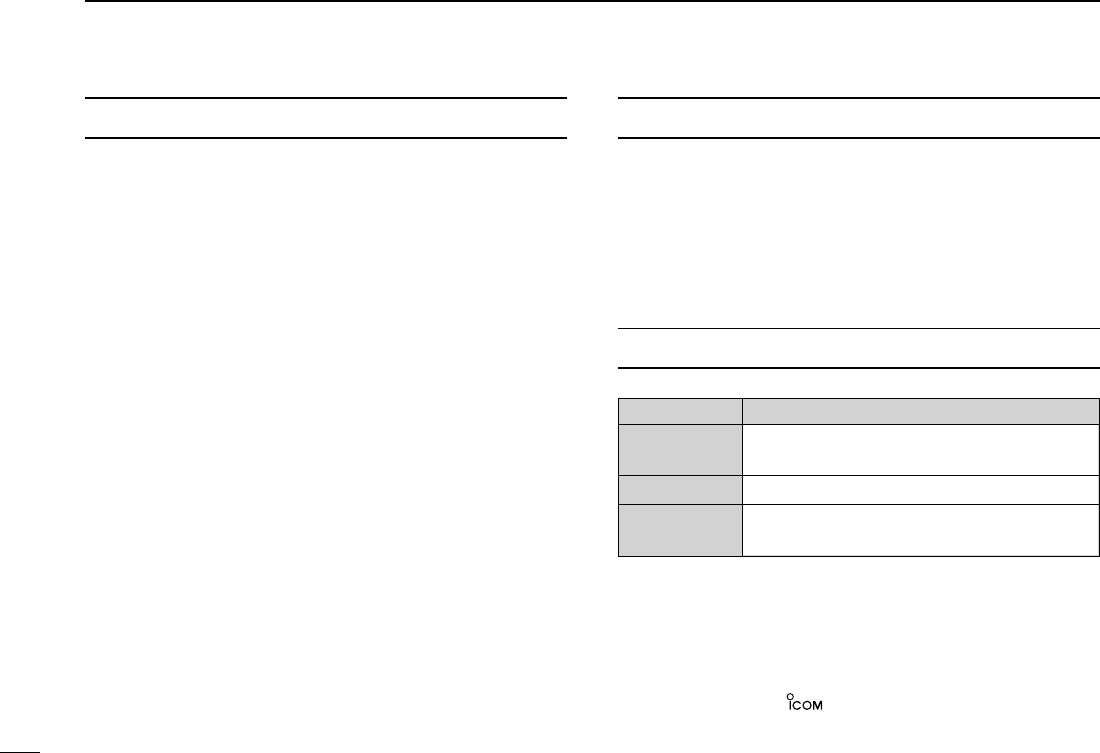
i
New2001
FOREWORD
Thank you for purchasing this Icom product. The IC-2720H
VHF
/
UHF FM TRANSCEIVER
is designed and built with Icom’s su-
perior technology and craftsmanship. With proper care, this
product should provide you with years of trouble-free opera-
tion.
We want to take a couple of moments of your time to thank
you for making your IC-2720H your radio of choice, and hope
you agree with Icom’s philosophy of “technology first.” Many
hours of research and development went into the design of
your IC-2720H.
DD
FEATURES
❍V/V, U/U simultaneous receive capability
❍Independent controls for each left and right
bands
❍Separate controller for flexible installation
❍50 W* of high transmit output power
*VHF band; 35 W for UHF, 25 W for Taiwan version
❍Remote control microphone standard
❍New DMS (Dynamic Memory Scan) system
IMPORTANT
READ ALL INSTRUCTIONS carefully and completely
before using the transceiver.
SAVE THIS INSTRUCTION MANUAL— This in-
struction manual contains important operating instructions for
the IC-2720H.
EXPLICIT DEFINITIONS
WORD DEFINITION
RWARNING!
CAUTION
NOTE
Personal injury, fire hazard or electric shock
may occur.
Equipment damage may occur.
Recommended for optimum use. No risk of
personal injury, fire or electric shock.
Icom, Icom Inc. and the logo are registered trademarks of Icom
Incorporated (Japan) in the United States, the United Kingdom, Ger-
many, France, Spain, Russia and/or other countries.
IC-2720H.qxd 02.9.9 8:12 Page i (1,1)
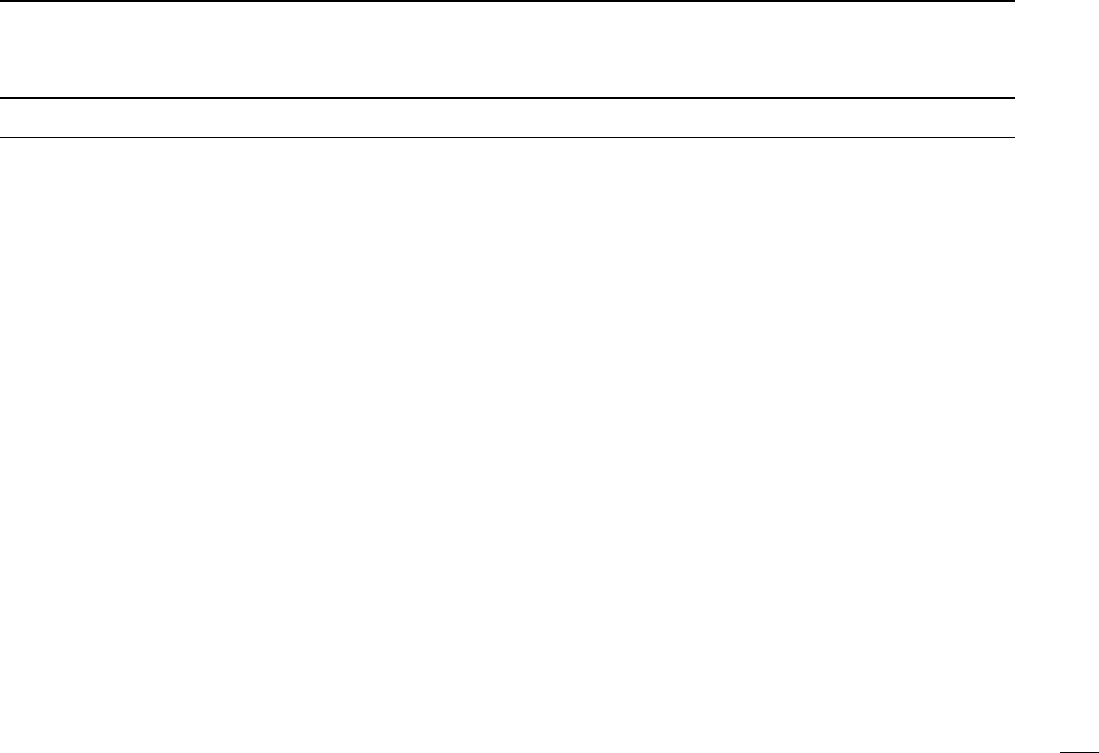
RWARNING RF EXPOSURE!
This device emits
Radio Frequency
(RF)
energy. Extreme caution should be observed
when operating this device. If you have any questions regarding
RF exposure and safety standards please refer to the Federal
Communications Commission Office of Engineering and Technol-
ogy’s report on Evaluating Compliance with FCC Guidelines for
Human Radio frequency Electromagnetic Fields
(OET Bulletin 65)
.
RWARNING! NEVER connect the transceiver to an AC
outlet. This may pose a fire hazard or result in an electric shock.
RWARNING! NEVER operate the transceiver while dri-
ving a vehicle. Safe driving requires your full attention—anything
less may result in an accident.
NEVER connect the transceiver to a power source of more
than 16 V DC. This will damage the transceiver.
NEVER connect the transceiver to a power source using re-
verse polarity. This will damage the transceiver.
NEVER cut the DC power cable between the DC plug and
fuse holder. If an incorrect connection is made after cutting, the
transceiver may be damaged.
NEVER expose the transceiver to rain, snow or any liquids.
The transceiver may be damaged.
NEVER operate or touch the transceiver with wet hands. This
may result in an electric shock or damage the transceiver.
NEVER place the transceiver where normal operation of the
vehicle may be hindered or where it could cause bodily injury.
NEVER let objects impede the operation of the cooling fan on
the rear panel.
DO NOT
push the PTT when not actually desiring to transmit.
DO NOT allow children to play with any radio equipment con-
taining a transmitter.
During mobile operation, DO NOT operate the transceiver
without running the vehicle’s engine. When the transceiver’s
power is ON and your vehicle’s engine is OFF, the vehicle’s bat-
tery will soon become exhausted.
BE CAREFUL! The transceiver will become hot when op-
erating it continuously for long periods.
AVOID using or placing the transceiver in direct sunlight or in
areas with temperatures below –10°C (+14˚F) or above +60°C
(+140˚F).
AVOID the use of chemical agents such as benzine or alcohol
when cleaning, as they can damage the transceiver’s surfaces.
USE Icom microphones only (supplied or optional). Other man-
ufacturer’s microphones have different pin assignments and may
damage the transceiver if attached.
For U.S.A. only
CAUTION: Changes or modifications to this device, not ex-
pressly approved by Icom Inc., could void your authority to
operate this device under FCC regulations.
ii
New2001
PRECAUTION
IC-2720H.qxd 02.9.9 8:12 Page ii (1,1)
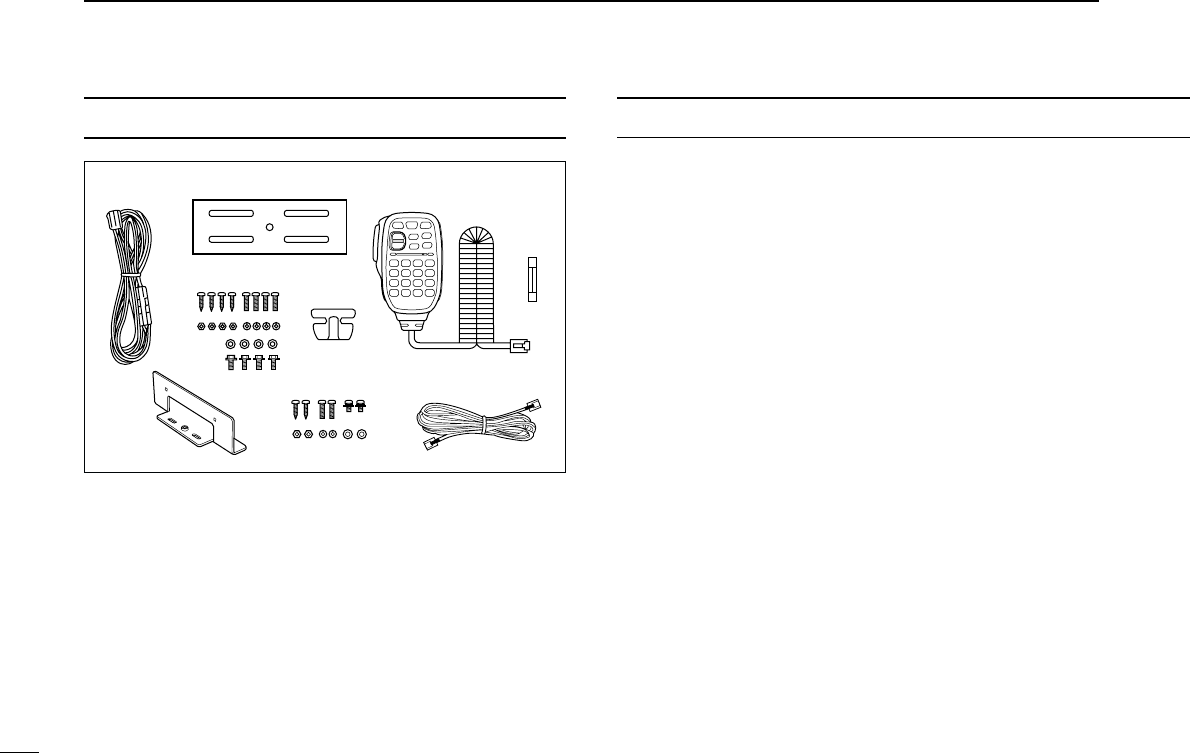
New2001
iii
TABLE OF CONTENTSSUPPLIED ACCESSORIES
qDC power cable (3 m) ………………………………………1
wMobile mounting bracket …………………………………1
eMicrophone (HM-133)* ……………………………………1
rFuse (20 A) …………………………………………………1
tMounting screws, nuts and washers …………………1 set
yMicrophone hanger …………………………………………1
uRemote controller bracket (MB-84) ………………………1
iMounting screws, nuts and washers for MB-84 ……1 set
oSeparation cable†(3.5 m; 11.5 ft) …………………………1
*HM-118N
HAND MICROPHONE
or HM-118TN/TAN
DTMF MICROPHONE
supplied versions are also available.
†A ferrite core is adapted for the USA version.
qw e
r
ty
uio
FOREWORD ........................................................................................... i
IMPORTANT ............................................................................................ i
EXPLICIT DEFINITIONS ......................................................................... i
PRECAUTION ........................................................................................ ii
SUPPLIED ACCESSORIES .................................................................. iii
TABLE OF CONTENTS ......................................................................... iii
QUICK REFERENCE GUIDE ........................................................... I–XII
■Installation ....................................................................................... I
■Your first contact .......................................................................... VII
■Repeater operation ........................................................................ X
■Programming memory channels.................................................... XI
1 PANEL DESCRIPTION ............................................................... 1–10
■Front panel— controller ................................................................. 1
■Function display ............................................................................. 3
■Main unit ........................................................................................ 5
■Microphone (HM-133) .................................................................... 7
■Microphone keypad ........................................................................ 8
■Optional microphones (HM-118N/TN/TAN)................................... 10
2 SETTING A FREQUENCY ........................................................ 11–15
■Preparation ................................................................................... 11
■Using the tuning dial .................................................................... 13
■Using the [Y]/[Z] keys ................................................................. 13
■Using the keypad ......................................................................... 13
■Tuning step selection ................................................................... 14
■Lock functions .............................................................................. 15
3 BASIC OPERATION ................................................................. 16–21
■Receiving ..................................................................................... 16
■Monitor function ........................................................................... 16
■Squelch attenuator ....................................................................... 17
■V/V, U/U simultaneous receive (Para-watch) ............................... 18
■Sub band mute/sub band busy beep ........................................... 19
■Transmitting ................................................................................. 20
IC-2720H.qxd 02.9.9 8:12 Page iii (1,1)
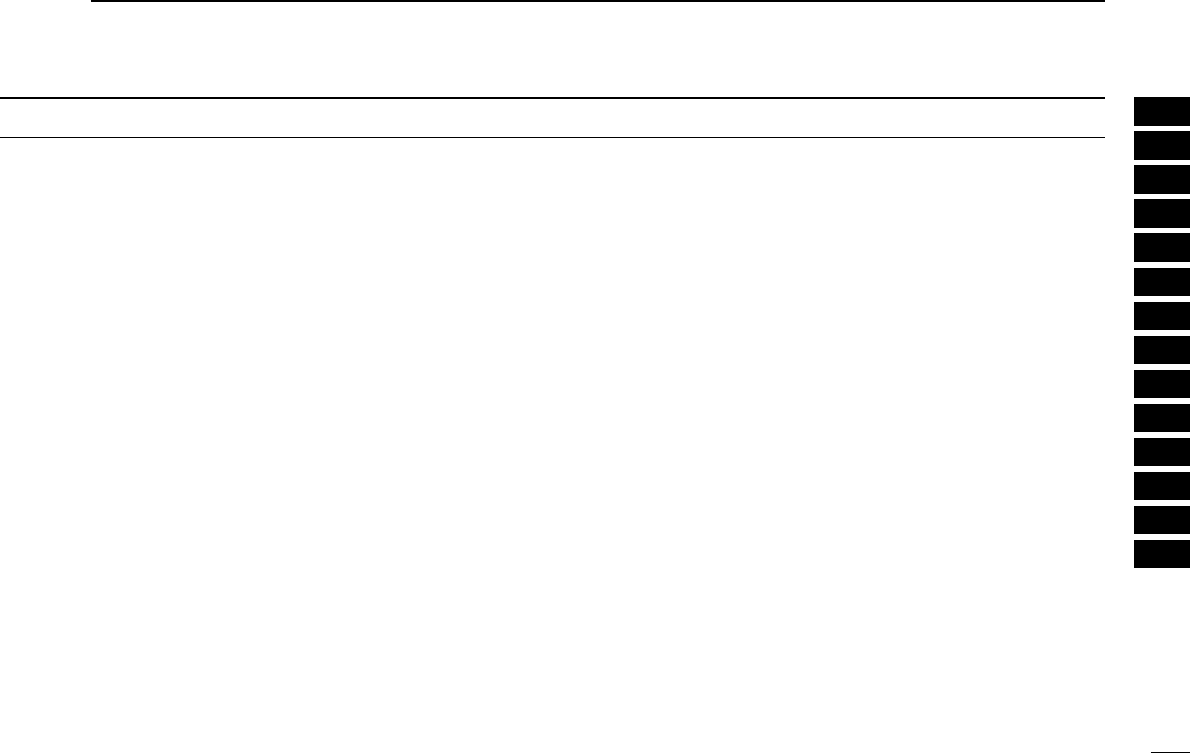
New2001
iv
1
2
3
4
5
6
7
8
9
10
11
12
13
14
■Selecting output power ................................................................ 20
■One-touch PTT function ............................................................... 21
■Audio mute function ..................................................................... 21
4 REPEATER OPERATION ......................................................... 22–28
■General ........................................................................................ 22
■Accessing a repeater ................................................................... 23
■Subaudible tones ......................................................................... 25
■Offset frequency .......................................................................... 27
■Auto repeater (USA version only) ................................................ 28
5 MEMORY OPERATION ............................................................ 29–37
■General description ...................................................................... 29
■Memory channel selection ........................................................... 29
■Programming a memory channel ................................................. 30
■Transferring memory contents ..................................................... 32
■Memory clearing .......................................................................... 34
■Memory bank selection ................................................................ 35
■Memory bank setting .................................................................... 36
■Transferring bank contents .......................................................... 37
6 CALL CHANNEL OPERATION ................................................ 38–39
■Call channel selection .................................................................. 38
■Call channel transferring .............................................................. 38
■Programming a call channel ........................................................ 39
7 SCAN OPERATION .................................................................. 40–45
■Scan types ................................................................................... 40
■Scan start/stop ............................................................................. 41
■Scan edges programming ............................................................ 42
■Skip channel setting ..................................................................... 44
■Scan resume condition ................................................................ 45
8 PRIORITY WATCH .................................................................... 46–47
■Priority watch types ...................................................................... 46
■Priority watch operation ............................................................... 47
9 DTMF MEMORY ENCODER ..................................................... 48–51
■Programming a DTMF code ......................................................... 48
■Transmitting a DTMF code .......................................................... 50
■DTMF speed ................................................................................ 51
10 POCKET BEEP AND TONE SQUELCH ................................... 52–55
■Pocket beep operation ................................................................. 52
■Tone/DTCS squelch operation ..................................................... 54
■Tone scan ..................................................................................... 55
11 OTHER FUNCTIONS ................................................................ 56–72
■Set mode ...................................................................................... 56
■Initial set mode ............................................................................. 60
■AM/FM narrow mode ................................................................... 64
■Weather channel operation (USA version only) ........................... 65
■Microphone keys .......................................................................... 66
■Partial reset .................................................................................. 67
■All reset ........................................................................................ 67
■Data cloning ................................................................................. 68
■Packet operation .......................................................................... 69
12 MAINTENANCE ........................................................................ 73–74
■Troubleshooting ........................................................................... 73
■Fuse replacement ........................................................................ 74
13 SPECIFICATIONS AND OPTIONS ........................................... 75–76
■Specifications ............................................................................... 75
■Options ......................................................................................... 76
14 MODE ARRANGEMENT ........................................................... 77–78
IC-2720H.qxd 02.9.9 8:12 Page iv (1,1)
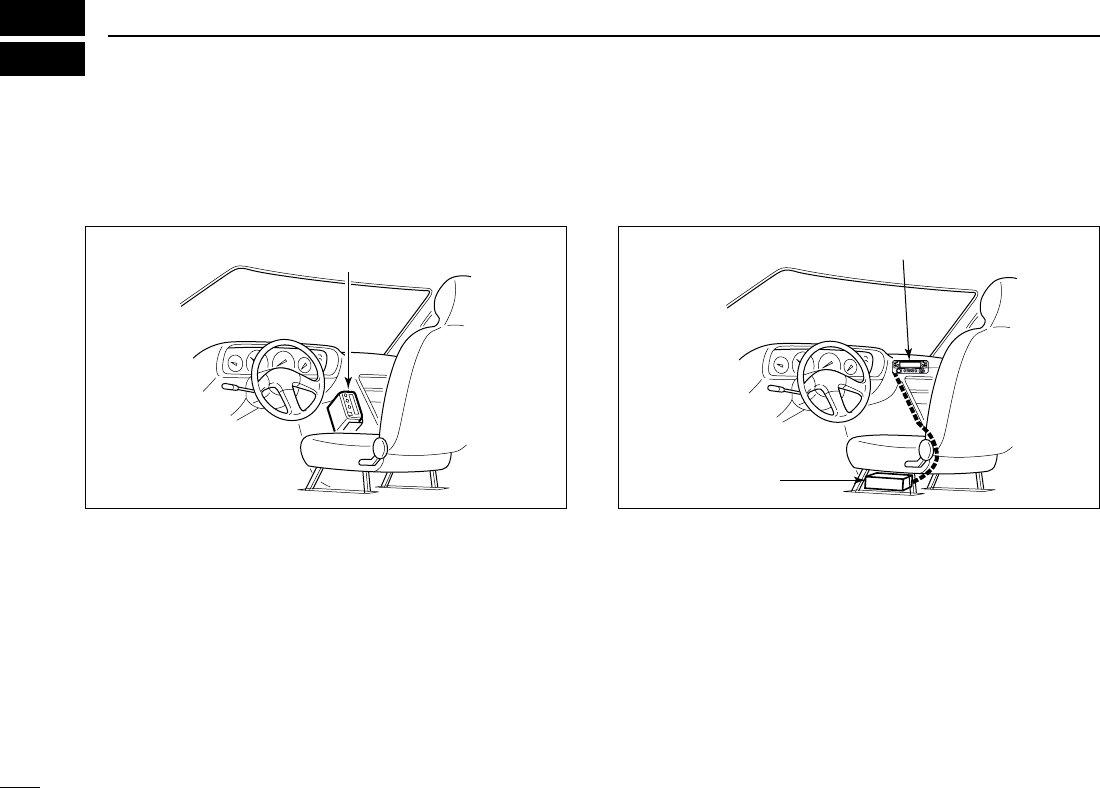
I
QUICK REFERENCE GUIDE
New2001
■Installation
DInstallation methods
• Single body installation
• Optional MB-85
COMBINATION BRACKET
is necessary to
mount the controller to the main unit. (20 cm; 77⁄8″separa-
tion cable is supplied with the bracket.)
• The supplied mounting bracket (or optional MB-17A) can be
used for the main unit installation.
• Remote installation
• The supplied MB-84
REMOTE CONTROLLER BRACKET
and
OPC-1155
SEPARATION CABLE
can be used for installation.
• Optional OPC-1156
SEPARATION CABLE
(3.5 m; 11.5 ft) is
available for extend the separation cable.
• Optional MB-65
MOUNTING BASE
is available for increasing
front panel mounting possibilities.
• Optional OPC-440
MICROPHONE CABLE
(5.0 m; 16.4 ft) and
OPC-647 (2.5 m; 8.2 ft) are available to extend the micro-
phone cable.
• Optional OPC-441
SPEAKER CABLE
(5.0 m; 16.4 ft) is avail-
able to extend the speaker cable.
Main body
Front panel
Transceiver
IC-2720H.qxd 02.9.9 8:12 Page I (1,1)
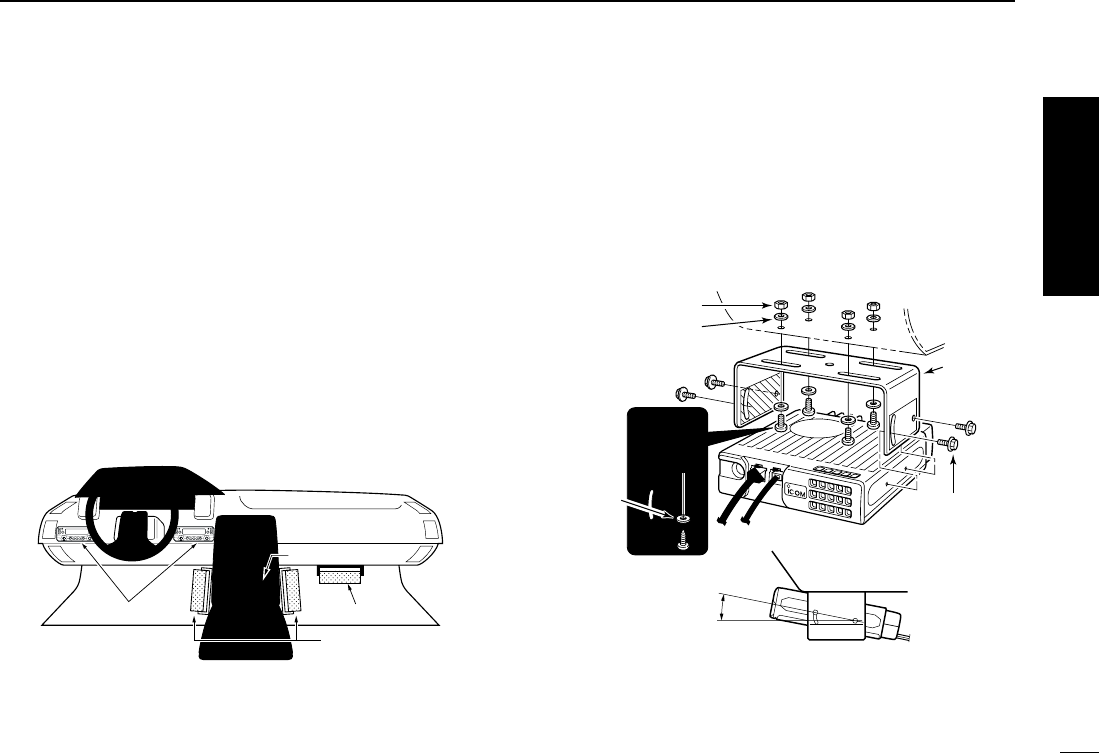
II
QUICK REFERENCE GUIDE
New2001
DLocation
Select a location which can support the weight of the trans-
ceiver and does not interfere with driving. We recommend the
locations shown in the diagram below.
NEVER place the transceiver or remote controller where nor-
mal operation of the vehicle may be hindered or where it
could cause bodily injury.
NEVER place the transceiver or remote controller where air
bag deployment may be obstructed.
DO NOT place the transceiver or remote controller where hot
or cold air blows directly onto it.
AVOID placing the transceiver or remote controller in direct
sunlight.
DUsing the mounting bracket
qDrill 4 holes where the mounting bracket is to be installed.
•Approx. 5.5–6 mm (1⁄4″) when using nuts; approx. 2–3 mm (1⁄8″)
when using self-tapping screws.
wInsert the supplied screws, nuts and washers through the
mounting bracket and tighten.
eAdjust the angle for your suitable position.
25˚
Nut
Spring washer
When using
self-tapping
screws
Flat washer Mounting nut
Mounting
bracket
Controller
Main unit
Main unit
Main unit
Quick reference guide
IC-2720H.qxd 02.9.9 8:12 Page II (1,1)
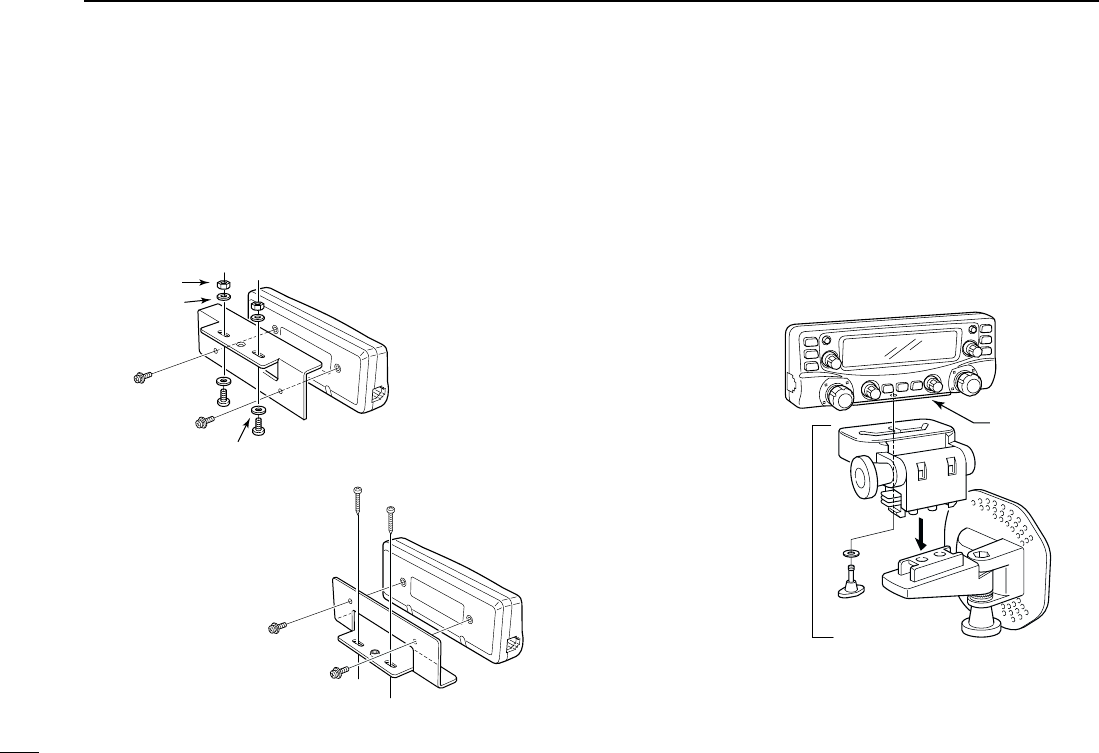
III
QUICK REFERENCE GUIDE
New2001
DMB-84 installation
The supplied MB-84
REMOTE CONTROLLER BRACKET
is used
for separate installation.
qDrill 2 holes where the bracket is to be installed.
•Approx. 4 mm (1⁄8″) when using nuts; approx. 1–2mm (
1⁄16″)
when using self-tapping screws.
wAttach the remote controller to the MB-84 and tighten the
controller using with the supplied screws.
eTighten the controller with bracket.
• Using the optional MB-65
MB-84
(supplied)
Optional
MB-65
Adjust the view-
ing angle for
maximum visibili-
ty of the function
display.
MB-84
MB-84
• Over-head mounting
• Standard mounting
Remote
controller
Supplied
screws
Supplied
screws
Self-tapping
screws
Remote
controller
Nut
Spring
washer
Flat
washer
IC-2720H.qxd 02.9.9 8:12 Page III (1,1)
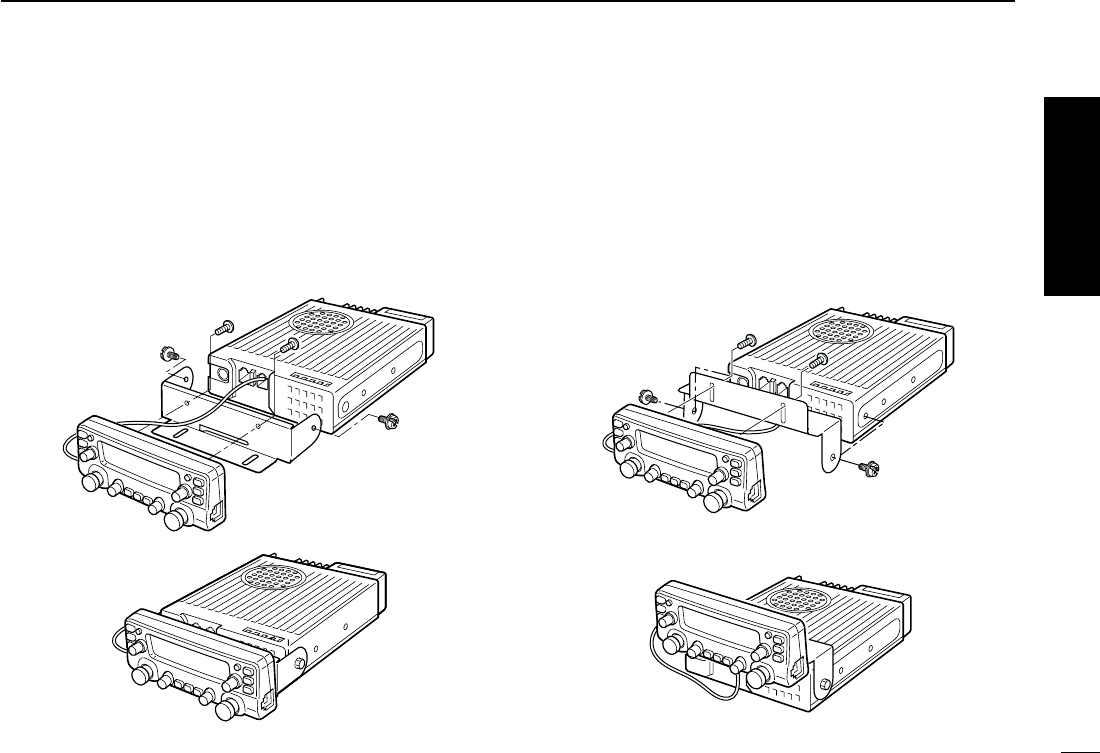
IV
QUICK REFERENCE GUIDE
New2001
DOptional MB-85 installation
When using the optional MB-85 (
COMBINATION BRACKET
), you
can install the control head of the IC-2720H in one of 2 meth-
ods. A 20 cm (77⁄8″) remote control cable is supplied for con-
nection, and connect the cable before attaching the bracket to
the main unit is recommended.
•Example 1 •Example 2
Quick reference guide
IC-2720H.qxd 02.9.9 8:12 Page IV (1,1)
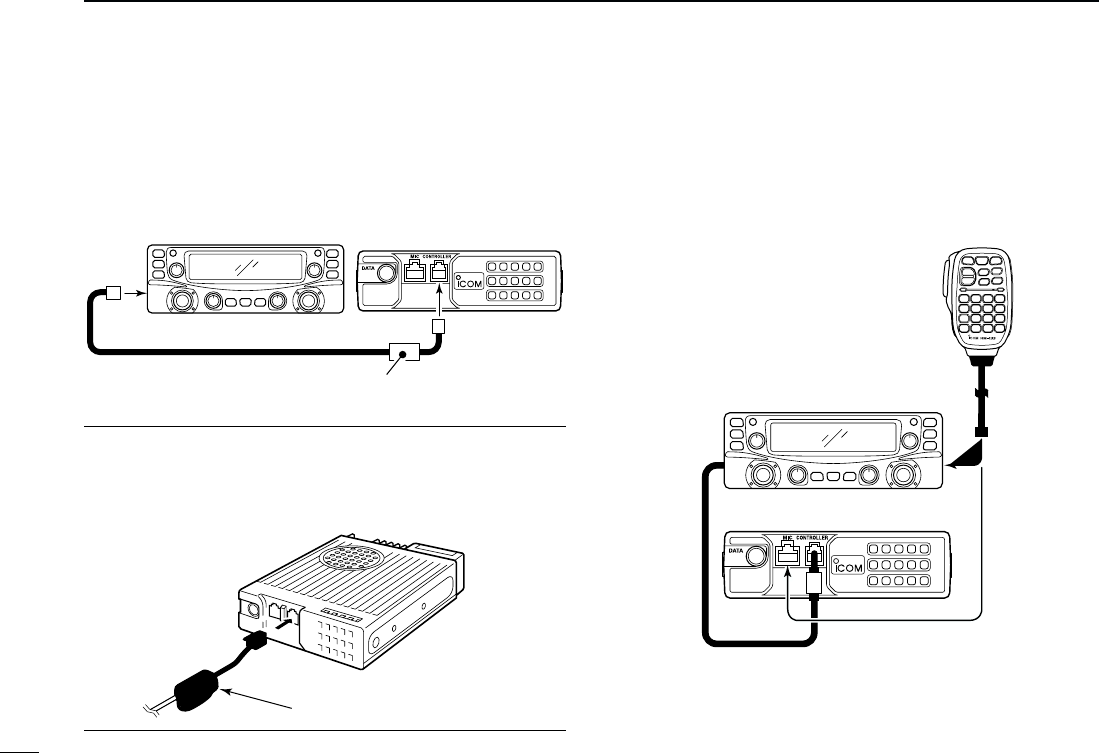
V
New2001
DSeparation cable connection
A separation cable (3.5 m; 11.5 ft) is supplied with the IC-
2720H.
Connect the controller and the main unit using with the sepa-
ration cable as follows.
IMPORTANT!— For the USA version
A ferrite core is supplied within the separation cable. Connect
the cable connector with the ferrite core into the main unit
[CONTROLLER] socket as below.
DMicrophone connection
Two microphone connectors are available for the IC-2720H—
one is on the controller side panel, and another is on the main
unit front panel.
Connect the supplied microphone to either the desired con-
nector as illustrated below.
Controller
Main unit
Ferrite core
Controller Main unit
See “
IMPORTANT!”
below.
QUICK REFERENCE GUIDE
IC-2720H.qxd 02.9.9 8:12 Page V (1,1)
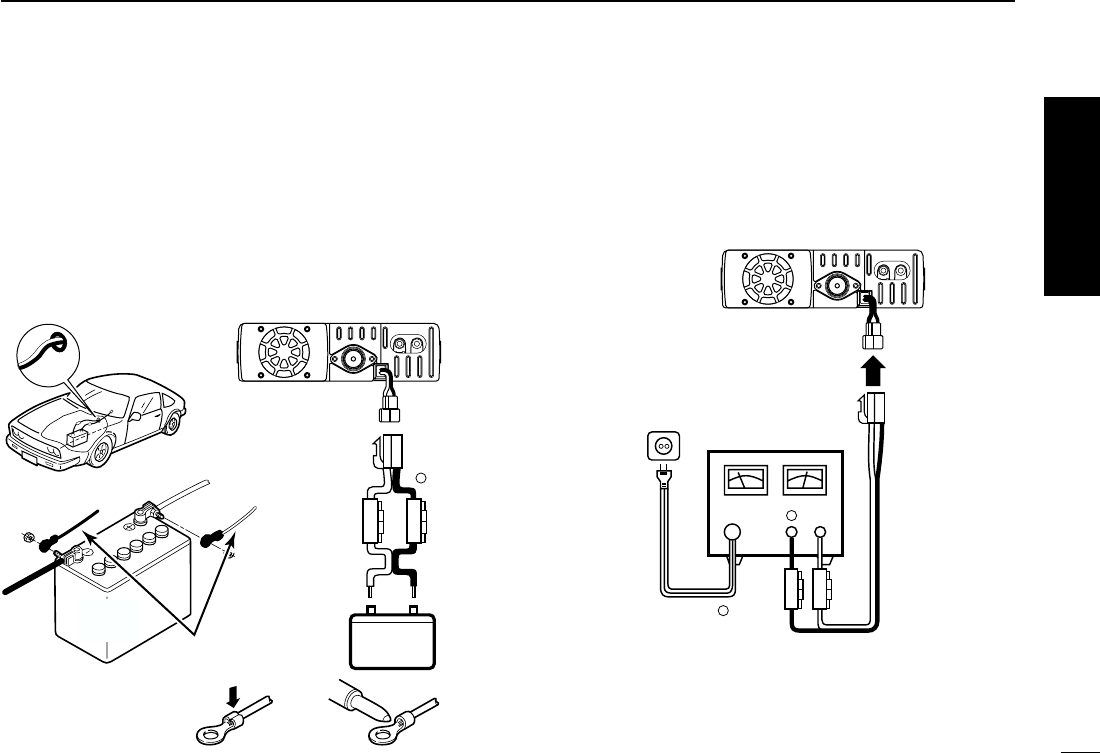
VI
QUICK REFERENCE GUIDE
New2001
DBattery connection
☞RWARNING NEVER remove the fuse holders from the
DC power cable.
☞NEVER connect the transceiver directly to a 24 V battery.
☞DO NOT use the cigarette lighter socket for power con-
nections. (See p. 6 for details)
Attach a rubber grommet when passing the DC power cable
through a metal plate to prevent a short circuit.
•CONNECTING TO A DC POWER SOURCE
DDC power supply connection
Use a 13.8 V DC power supply with at least 15 A capacity.
Make sure the ground terminal of the DC power supply is
grounded.
•CONNECTING TO A DC POWER SUPPLY
See p. 74 for fuse replacement.
DC power
supply 13.8 V
to an
AC
outlet
Fuses
20 A
black
red⊕
−
⊕
−
IC-2720H
IC-2720H
Fuses
20 A
black
red⊕−
12 V
Grommet
NOTE:
Use terminals for the
cable connections.
WARNING!
NEVER
remove the
fuse holders.
Crimp Solder
12 V
battery Supplied
DC power cable
+ red
_ black
Quick reference guide
IC-2720H.qxd 02.9.9 8:12 Page VI (1,1)
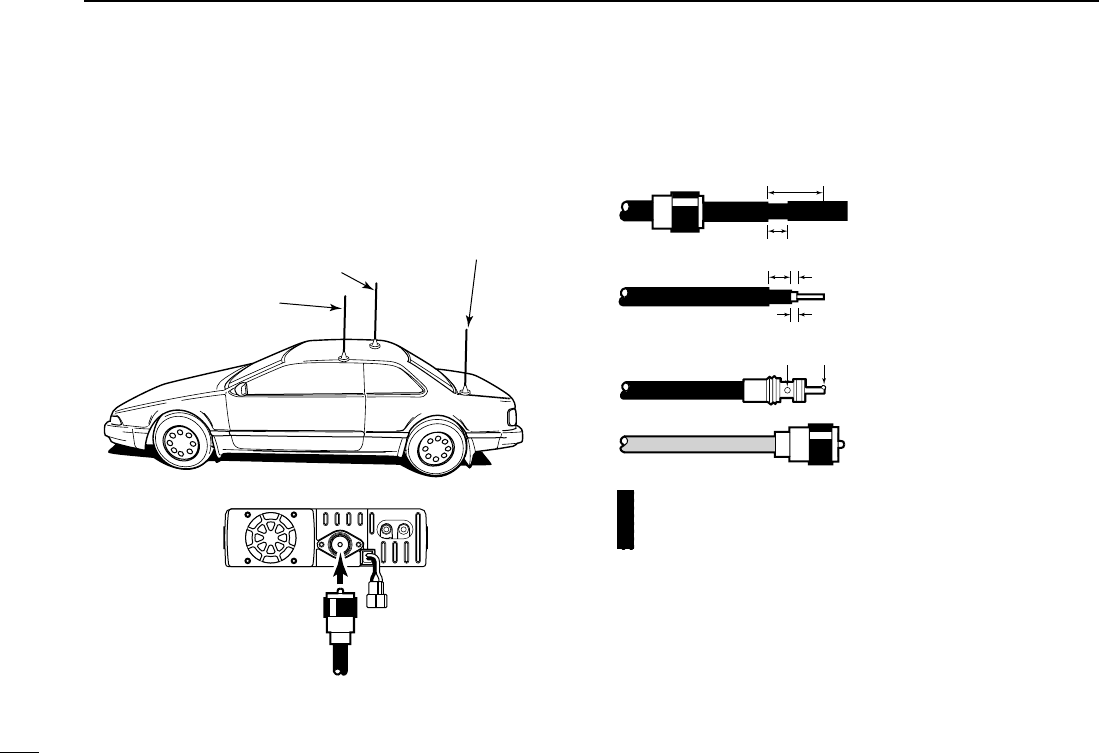
VII
QUICK REFERENCE GUIDE
New2001
DAntenna installation
•Antenna location
To obtain maximum performance from the transceiver, select
a high-quality antenna and mount it in a good location. A non-
radial antenna should be used when using a magnetic mount.
•Antenna connector
The antenna uses a PL-259 connector.
•PL-259 CONNECTOR
qSlide the coupling ring
down. Strip the cable
jacket and soft solder.
wStrip the cable as shown
at left. Soft solder the cen-
ter conductor.
eSlide the connector body
on and solder it.
rScrew the coupling ring
onto the connector body.
(10 mm ≈3⁄8 in)
NOTE: There are many publications covering proper an-
tennas and their installation. Check with your local dealer
for more information and recommendations.
30 mm
10 mm (soft solder)
10 mm
1–2 mm
solder solder
Soft
solder
Coupling ring
To antenna
Roof-mount antenna
(Drill a hole or use a magnetic mount.)
Gutter-mount antenna
Trunk-mount
antenna
IC-2720H.qxd 02.9.9 8:12 Page VII (1,1)
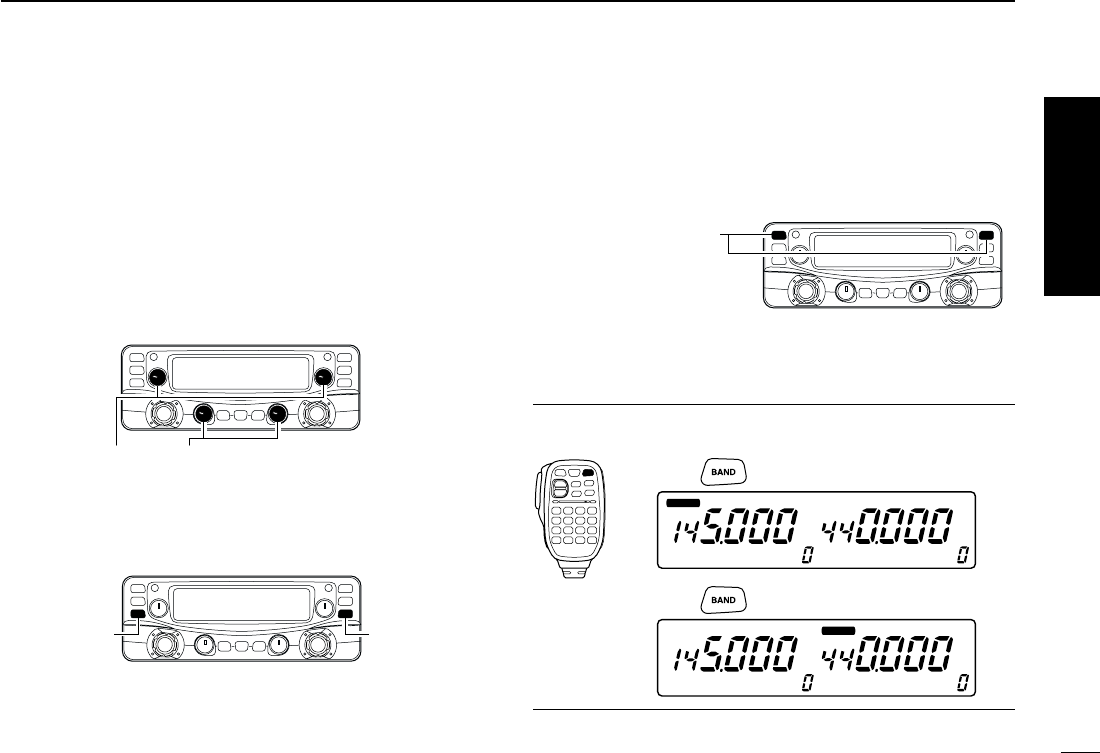
VIII
QUICK REFERENCE GUIDE
New2001
■Your first contact
Now that you have your IC-2720H installed in your car or
shack, you are probably excited to get on the air. We would
like to take you through a few basic operation steps to make
your first “On The Air” an enjoyable experience.
1. Turning ON the transceiver
Before powering up your IC-2720H, you may want to make
sure the audio volume and squelch level controls are set in
9–10 o’clock positions.
Although you have purchased a brand new transceiver, some
settings may be changed from the factory defaults because
of the QC process. Resetting the CPU is necessary to start
from factory default.
➥While pushing both band’s [M/CALL•MW], push [PWR] for
1 sec. to reset the CPU.
2. Selecting the main band
The IC-2720H displays 2 frequencies on left and right bands
simultaneously. However, transmission, some switches and
microphone keys operation are accepted for the main band
only.
➥Push the desired band’s (left or right) [MAIN•BAND] to se-
lect the main band.
•“Q” appears for the main band.
Using the HM-133
You can select the main band from the HM-133.
MAIN
T X
MAIN
T X
MM
MAIN
T X
MAIN
T X
MM
Push
Push again
Push the desired band’s
[MAIN•BAND]
[M/CALL•MW]
While pushing both [M/CALL•MW], turn power ON.
[M/CALL•MW]
Set both [VOL] and [SQL] controls to 9–10 o’clock positions.
Quick reference guide
IC-2720H.qxd 02.9.9 8:12 Page VIII (1,1)
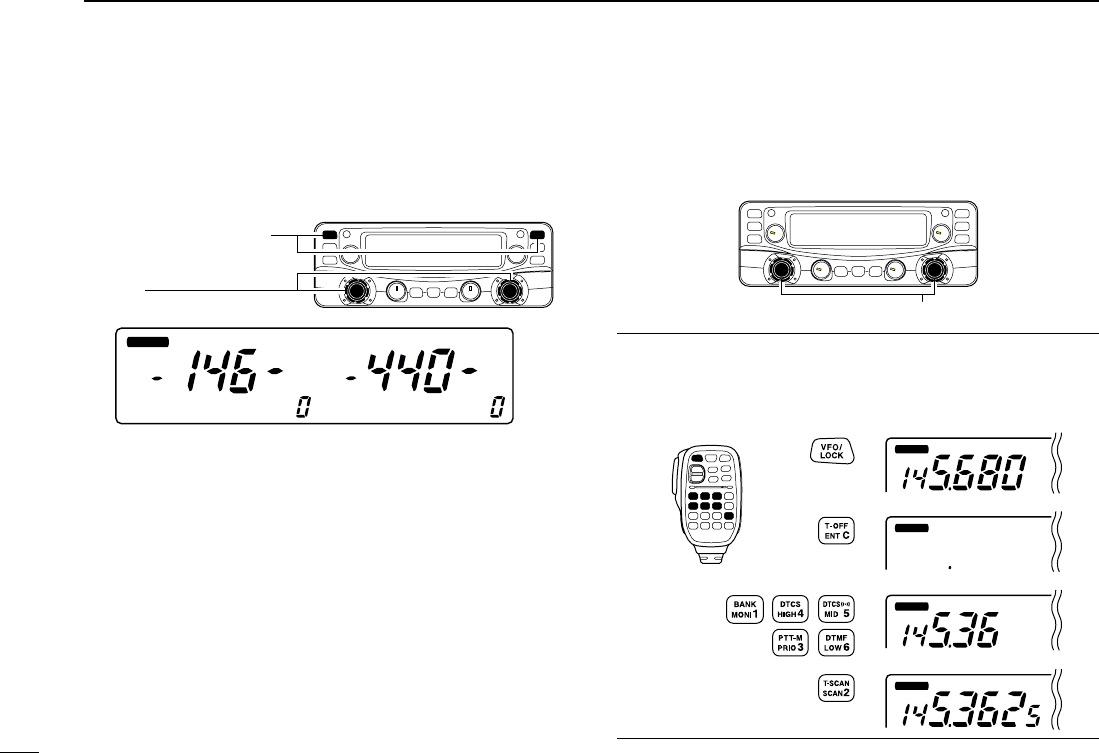
IX
QUICK REFERENCE GUIDE
New2001
3. Selecting the operating frequency band
The IC-2720H has 2 m and 70 cm bands for each left and
right band. The operating band can be exchanged between
them, and the same bands, V/V and U/U settings, also possi-
ble.
➥Push the desired band’s (left or right) [MAIN•BAND] for
1 sec. then rotate the appropriate band’s [DIAL].
•Push the [MAIN•BAND] momentarily to return to frequency indi-
cation.
4. Tune the frequency
The tuning dial will allow you to dial in the frequency you want
to operate. Pages 13 and 14 will instruct you on how to set
the tuning speed.
Using the HM-133
You can directly enter the frequency with the HM-133 keypad
for the main band.
MAIN
T X
MAIN
T X
MAIN
T X
MAIN
T X
[EXAMPLE]: Setting frequency to 145.3625 MHz.
Push
Push
Push
Push
Rotate the desired [DIAL].
MAIN
T X
MAIN
T X
MM
Frequency band initial is displayed.
Push the desired band’s
[MAIN•BAND] for 1 sec.
[DIAL]
IC-2720H.qxd 02.9.9 8:12 Page IX (1,1)
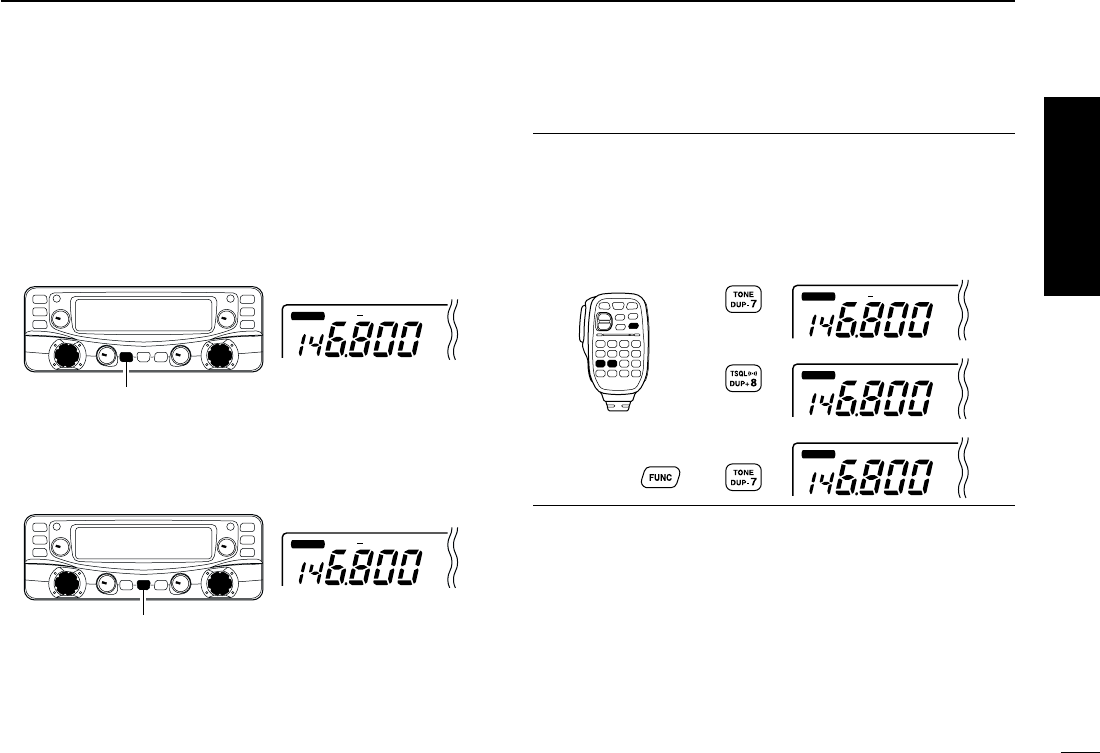
X
QUICK REFERENCE GUIDE
New2001
■Repeater operation
1. Setting duplex
Push desired band’s [MAIN•BAND] to select the main band.
Push [DUP•MONI] once or twice to select minus duplex or
plus duplex.
•The USA version have an auto repeater function, therefore, setting
duplex is not required.
2. Repeater tone
Push [TONE•DTMF] several times until “T” appears, if the re-
peater requires a subaudible tone to be accessed.
Using the HM-133
Plus or minus duplex selection and the repeater tone setting
can be made easily via HM-133.
Push [
DUP
–7(TONE)] for minus duplex; [
DUP
+8(TSQLS)]
for plus duplex selection, push [FUNC] then [
DUP
–7(TONE)]
to turn the repeater tone ON.
MAIN
T X
DUP
MAIN
T X
DUP
MAIN
T X
T
Push
Push , then
Push
MAIN
T X
DUP T
Push [TONE•DTMF].
MAIN
T X
DUP
Push [DUP•MONI].
Quick reference guide
IC-2720H.qxd 02.9.9 8:12 Page X (1,1)
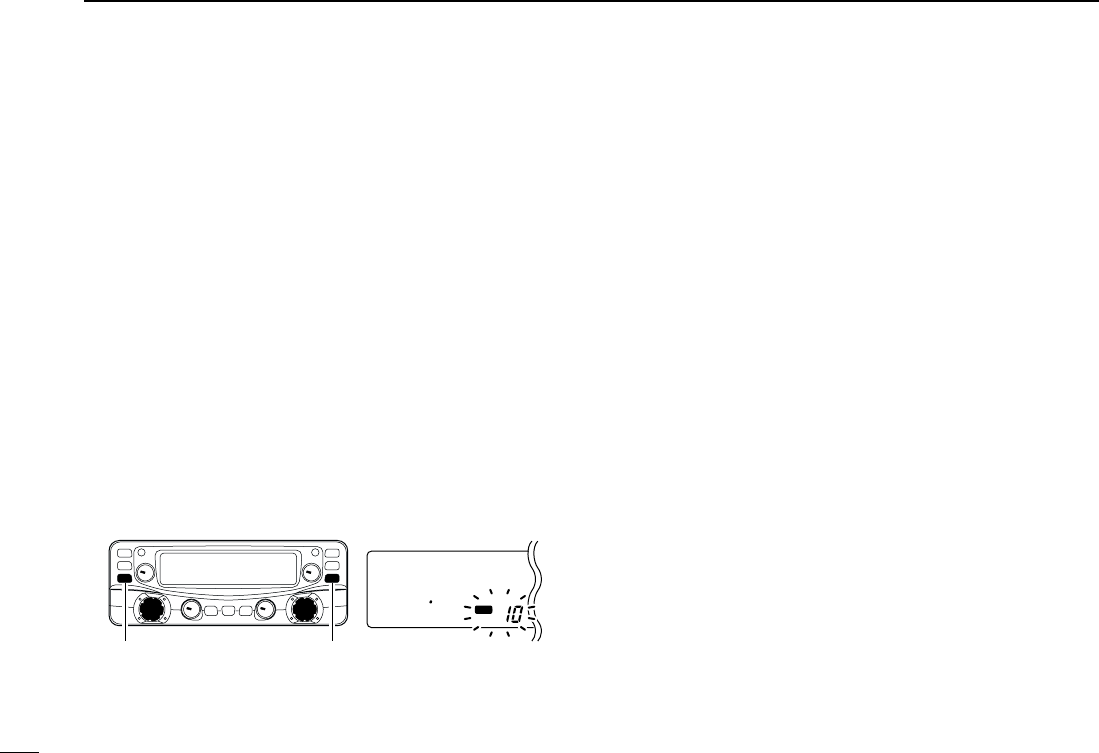
XI
QUICK REFERENCE GUIDE
New2001
■Programming memory channels
The IC-2720H has a total of 212 memory channels (including
10 scan edges and 2 call channels) for storing often used op-
erating frequency, repeater settings, etc.
Any memory channel can be recalled from either left or right
band.
1. Setting a frequency
In VFO mode, set the desired operating frequency with re-
peater, tone and tuning steps, etc.
➥Push the desired band’s [V/MHz•SCAN] to select VFO.
➥
Rotate the same band’s [DIAL] to set the desired frequency.
•Set other data, such as repeater tone, duplex information, tuning
step), if desired.
2. Selecting a memory channel
Push the same band’s [M/CALL•MW] for 1 sec., then rotate
the [DIAL] to select the desired memory channel.
•“M” indicator and memory channel number blink.
3. Writing a memory channel
Push and hold the [M/CALL•MW] for 1 sec. to program.
•3 beeps sound
•Return to VFO mode automatically after the program.
•Memory channel number automatically increases when continuing
to push the [M/CALL•MW] after programming.
MAIN
T X
M
Push [M/CALL•MW] for 1 sec.
IC-2720H.qxd 02.9.9 8:12 Page XI (1,1)
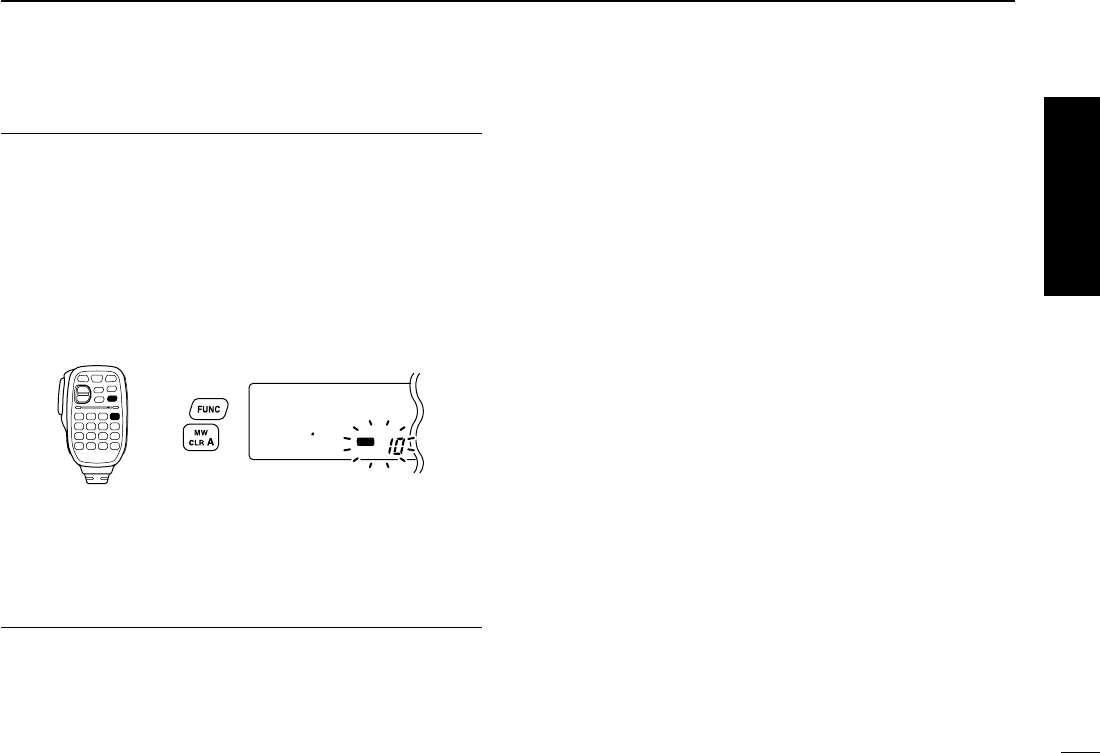
XII
QUICK REFERENCE GUIDE
New2001
Using the HM-133
qIn VFO mode, set the desired operating frequency, includ-
ing offset direction, tone settings, etc.
➥Push [VFO/LOCK] to select VFO.
➥Push [
ENT
C(T-OFF)] first, then enter the desired oper-
ating frequency via the keypad.
•Set other data, such as repeater tone, duplex information,
tuning step, if necessary.
wPush [FUNC] then [
CLR
A(MW)].
•“M” indicator and memory channel number blink.
ePush [Y]/[Z] to select the desired memory channel.
rPush [FUNC] then push [
CLR
A(MW)] for 1 sec. to pro-
gram.
•3 beeps sound
•Memory channel number automatically increases when continu-
ing to push [
CLR
A(MW)] after programming.
MAIN
T X
M
Push ,
then
Quick reference guide
IC-2720H.qxd 02.9.9 8:12 Page XII (1,1)
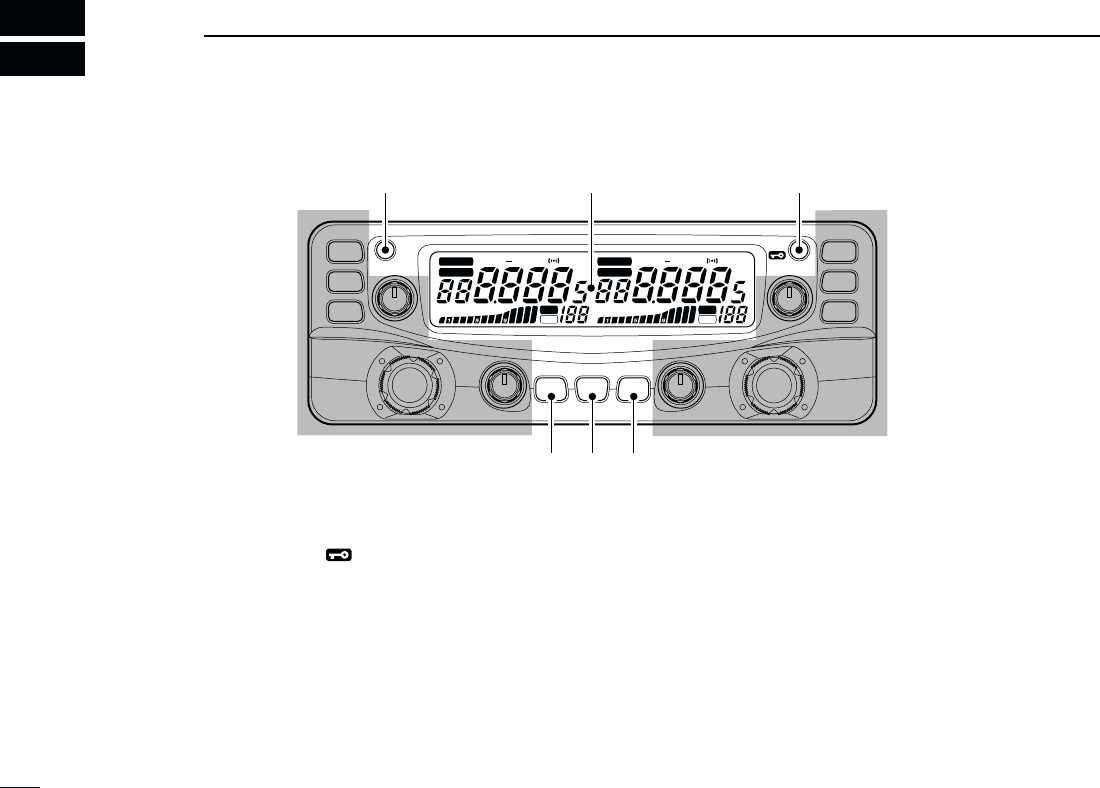
■Front panel— controller
qPOWER SWITCH [PWR]
Turns power ON and OFF when pushed for 1 sec.
wSET•LOCK SWITCH [SET•]
➥Enters set mode when pushed. (p. 56)
➥Switches the lock function ON and OFF when pushed
for 1 sec. (p. 15)
eOUTPUT POWER•PRIORITY SWITCH [LOW•PRIO]
➥Each push changes the output power selection. (p. 20)
➥Starts priority watch when pushed for 1 sec. (p. 47)
rTONE•DTMF SWITCH [TONE•DTMF]
➥Each push selects a tone function. (pgs. 23, 52)
•Subaudible tone encoder, pocket beep (CTCSS), tone
squelch, pocket beep (DTCS), DTCS squelch or tone func-
tion OFF can be selected.
➥Turns DTMF memory encoder ON and OFF when
pushed for 1 sec. (p. 48)
tDUPLEX•MONITOR SWITCH [DUP•MONI]
➥Push to select DUP–, DUP+ and simplex operation.
(p. 23)
➥Push for 1 sec. to switch the monitor function ON and
OFF. (p. 16)
MAIN
BAND
SCAN
MW
V/MHz
M/CALL
MAIN
BAND
SCAN
V/MHz
MW
M/CALL
VOLVOL
DIALDIAL
SQLSQL
DUP
MONI
TONE
DTMF
LOW
PRIO
DUAL BAND
FM TRANSCEIVER
i2720
PWR SET
BUSY
LOWMID
BUSY
LOWMID
MAIN
T X
DUP T SQL
DTCS
AM
MAIN
T X
DUP TSQL
DTCS
AM
M
SKIP
M
SKIP
qFunction display (pgs. 3, 4) w
ert
1
PANEL DESCRIPTION
New2001
1
*The switches wto tare
for the MAIN band only.
IC-2720H.qxd 02.9.9 8:12 Page 1 (1,1)
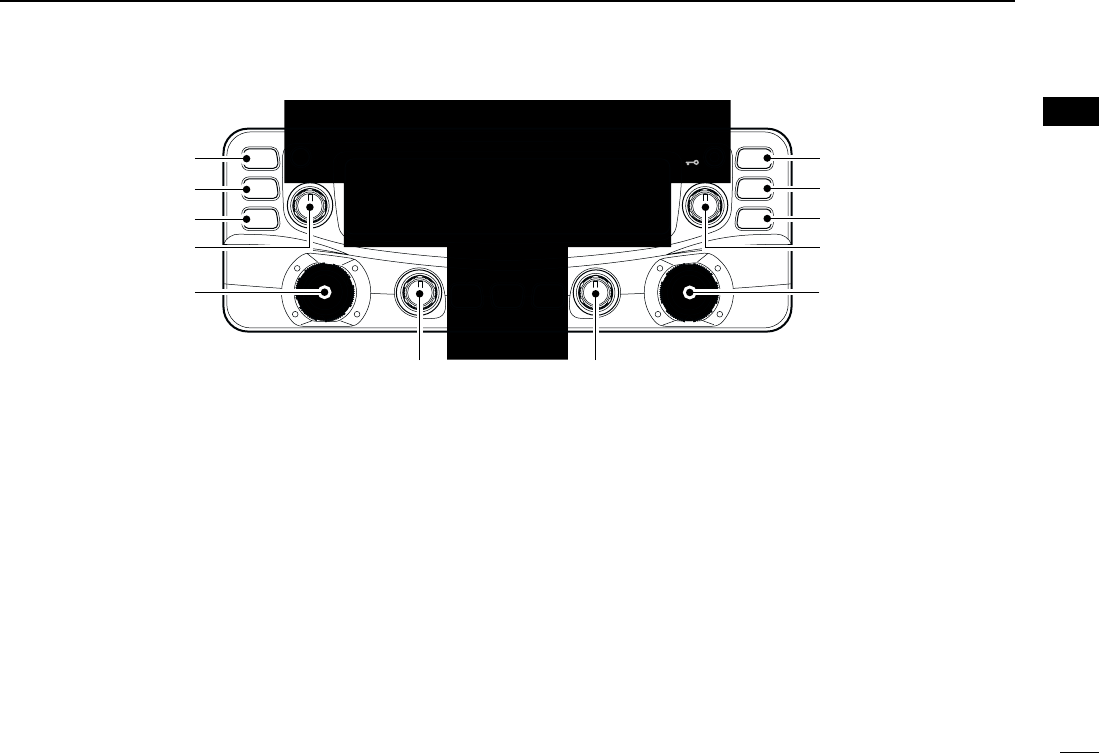
2
1
PANEL DESCRIPTION
New2001
1
yMAIN•BAND SWITCH [MAIN•BAND]
➥Push to select the main band. (p. 11)
➥Enters operating band select condition when pushed for
1 sec. (p. 11)
uVFO/MHz TUNING•SCAN SWITCH [V/MHz•SCAN]
➥Selects and toggles VFO mode and 1 MHz (or 10 MHz
for some versions) tuning when pushed. (p. 12)
➥Starts scan when pushed for 1 sec. (p. 41)
•Cancels a scan when pushed during scan.
i
MEMORY/CALL•MEMORY WRITE SWITCH [M/CALL•MW]
➥Push to select and toggle memory, call and weather
channel* modes. (pgs. 12, 29, 38, 65)
*Weather channels available for USA versions only.
➥Selects a memory channel for programming when
pushed for 1 sec. (pgs. 30, 39, 42)
oVOLUME CONTROL [VOL] (p. 16)
Adjusts the audio level for relative band.
!0TUNING DIAL [DIAL]
Selects the operating frequency (p. 13), memory channel
(p. 29), the setting of the set mode item and the scanning
direction (p. 41) for the relative band.
!1SQUELCH CONTROL [SQL]
Varies the squelch level for relative band. (p. 16)
•The RF attenuator activates and increases the attenuation when
rotated clockwise to the center position and further. (p. 17)
MAIN
BAND
SCAN
MW
V/MHz
M/CALL
MAIN
BAND
SCAN
V/MHz
MW
M/CALL
VOLVOL
DIALDIAL
SQLSQL
DUP
MONI
TONE
DTMF
LOW
PRIO
DUAL BAND
FM TRANSCIEVER
i2720
PWR SET
oo
Left band Right band
y
u
i
!0
y
u
i
!0
!1!1
*The same controls for both the left and
right bands are arranged in symmetry.
IC-2720H.qxd 02.9.9 8:12 Page 2 (1,1)
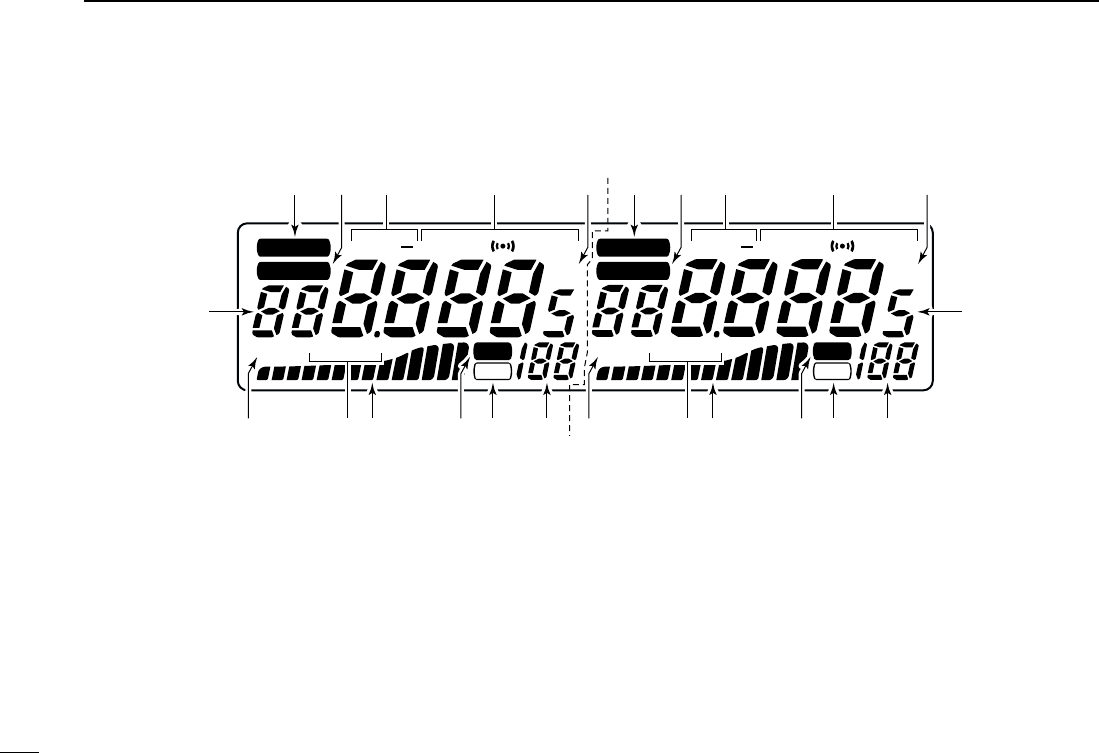
3
1PANEL DESCRIPTION
New2001
■Function display
qMAIN INDICATOR (p. 11)
Indicate the main band for transmit and function control.
wTRANSMIT INDICATOR
➥Appears while transmitting. (p. 20)
➥Blinks while transmitting with the one-touch PTT func-
tion. (p. 21)
eDUPLEX INDICATORS (p. 23)
“DUP” appears when plus duplex, “DUP –” appears when
minus semi-duplex (repeater) operation is selected.
rTONE INDICATORS
➥“T” appears while the subaudible tone encoder is in use.
(p. 23)
➥“T SQL” appears while the tone squelch function is in
use. (p. 52)
➥“DTCS” appears while the DTCS squelch function is in
use. (p. 52)
➥“S” appears with the “T SQL” or “DTCS” indicator
while the pocket beep function (with CTCSS or DTCS) is in
use. (p. 52)
BUSY
LOWMID
BUSY
LOWMID
MAIN
T X
DUP T SQL
DTCS
AM
MAIN
T X
DUP TSQL
DTCS
AM
M
SKIP
M
SKIP
qwe r t
y
uio!0!1!2
y
qwe r t
uio!0!1!2
Left band Right band
*The same indications for both the left and right bands are arranged.
IC-2720H.qxd 02.9.9 8:12 Page 3 (1,1)

4
1
PANEL DESCRIPTION
New2001
1
tAM INDICATOR (p. 64)
Appears when AM mode is selected.
yFREQUENCY READOUT
Shows the operating frequency, set mode contents, etc.
•Frequency decimal point blinks while scanning. (p. 41)
•“d” appears in place of the 1st digit while the DTMF memory
function is in use. (p. 48)
uMEMORY CHANNEL NUMBER INDICATORS
➥Shows the selected memory channel number. (p. 29)
➥Shows the selected bank initial. (p. 35)
➥“C” appears when the call channel is selected. (p. 38)
➥“L” appears when the lock function is activated. (p. 15)
iSKIP INDICATOR (p. 44)
Appears when the displayed memory channel is specified
as a skip channel.
oMEMORY INDICATOR (pgs. 12, 29)
Appears when memory mode is selected.
!0S/RF INDICATORS
➥Shows the relative signal strength while receiving sig-
nals. (p. 16)
➥Shows the output power level while transmitting. (p. 20)
!1OUTPUT POWER INDICATORS
“LOW” appears when low output power; “MID” appears
when middle output power is selected.
No indicator appears when high output power is selected.
!2BUSY INDICATOR
➥Appears when a signal is being received or the squelch
is open. (p. 16)
➥Blinks while the monitor function is activated. (p. 16)
IC-2720H.qxd 02.9.9 8:12 Page 4 (1,1)
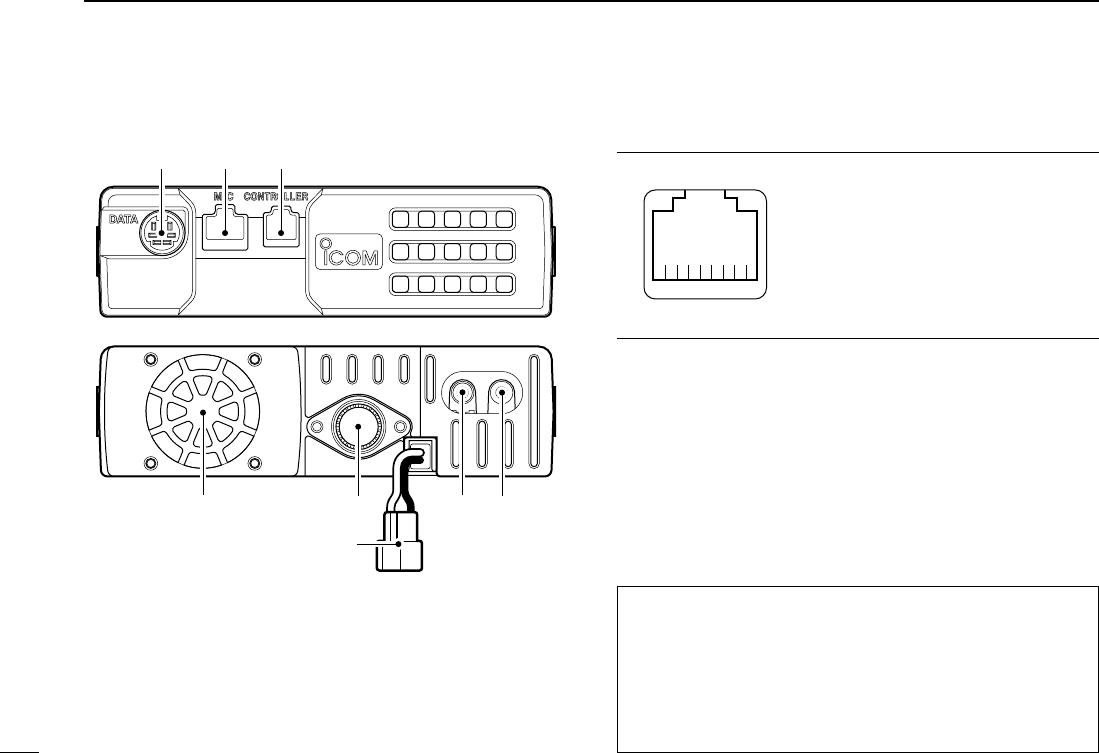
5
1PANEL DESCRIPTION
New2001
■Main unit
qDATA SOCKET [DATA]
Connects a TNC (Terminal Node Controller), etc. for data
communications.
•See p. 6 for connection information.
wMICROPHONE CONNECTOR [MIC]
Connects the supplied or an optional microphone.
q+8 V DC output (Max. 10 mA)
wChannel up/down
e8 V control IN
rPTT
tGND (microphone ground)
yMIC (microphone input)
uGND
iData IN
eCONTROLLER CONNECTOR [CONTROLLER] (p. V)
Connects the controller unit with the supplied cable.
rCOOLING FAN
Rotates while transmitting.
Also rotates while receiving depending on the setting in ini-
tial set mode. (p. 62)
tANTENNA CONNECTOR [ANT]
Connects a 50 Ωantenna with a PL-259 connector and a
50 Ωcoaxial cable.
ANTENNA INFORMATION
For radio communications, the antenna is of critical impor-
tance, to maximize your output power and receiver sensi-
tivity. The transceiver accepts a 50 Ωantenna and less
than 1:1.5 of Voltage Standing Wave Ratio (VSWR). High
SWR values not only may damage the transceiver but also
lead to TVI or BCI problems.
q
i
qwe
rtyu
i
IC-2720H.qxd 02.9.9 8:12 Page 5 (1,1)
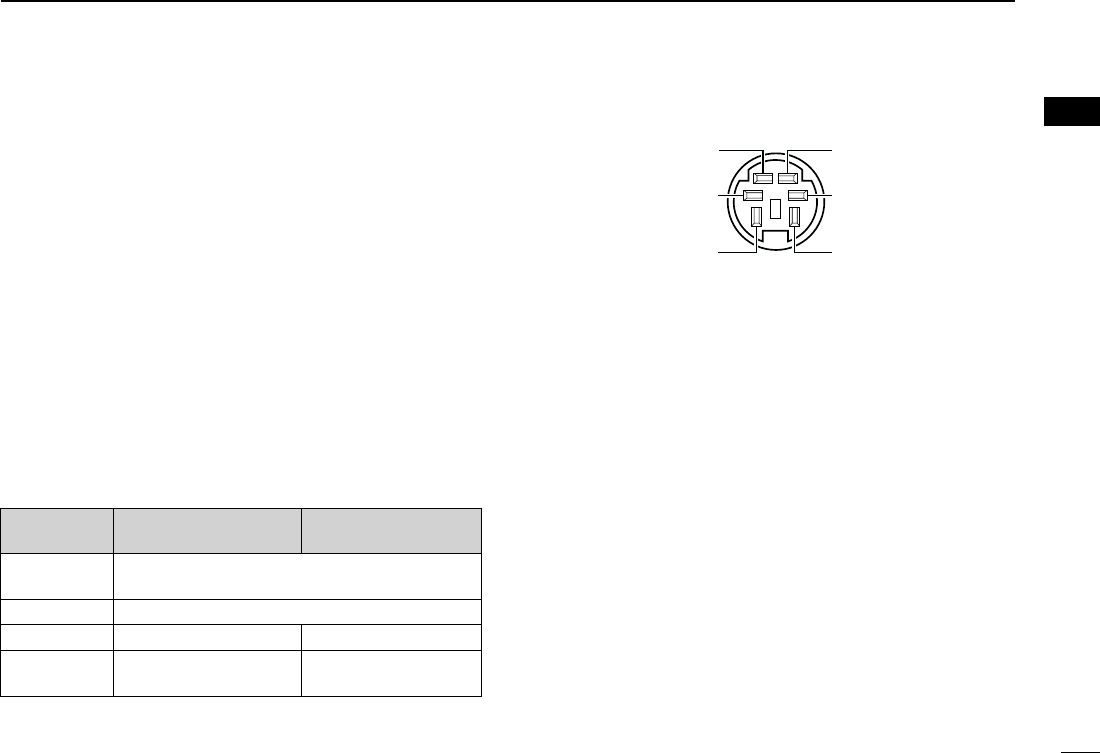
6
1
PANEL DESCRIPTION
New2001
1
yEXTERNAL SPEAKER JACK 1 [SP-1]
Connects an 8 Ωspeaker. Outputs both left and right
bands audio when no external speaker is connected to
[SP-2]. See the table below for details.
•Audio output power is more than 2.4 W.
uEXTERNAL SPEAKER JACK 2 [SP-2]
Connects an 8 Ωspeaker. Outputs right band’s audio only.
•Audio output power is more than 2.4 W.
iPOWER RECEPTACLE [DC13.8V]
Accepts 13.8 V DC ±15% with the supplied DC power
cable.
☞NOTE: DO NOT use a cigarette lighter socket as a
power source when operating in a vehicle. The plug
may cause voltage drops and ignition noise may be su-
perimposed onto transmit or receive audio.
DDSpeaker information
DDATA JACK PIN ASSIGNMENT
qDATA IN
Input terminal for data transmit. See p. 62 for details on
how to toggle data speed between 1200 (AFSK) and
9600 bps (G3RUH, GMSK).
wGND
Common ground for DATA IN, DATA OUT and AF OUT.
ePTT P
PTT terminal for packet operation only. Connect ground to
transmit data.
rDATA OUT
Data out terminal for 9600 bps operation only.
tAF OUT
Data out terminal for 1200 bps operation only.
yP SQL
Becomes high (+5 V) when the transceiver receives a sig-
nal which opens the squelch.
•To avoid unnecessary TNC transmission, connect squelch to the
TNC to inhibit transmission when receiving signals.
•Keep audio output at a normal level, otherwise a “P SQL” signal
will not be output.
Front panel view
w
y
r
q
e
t
Connected Left band audio Right band audio
speaker
No external Internal speaker (mixed audio)
speakers
[SP-1] only External speaker (mixed audio)
[SP-2] only Internal speaker External speaker
2 external External speaker via External speaker via
speakers [SP-1] [SP-2]
IC-2720H.qxd 02.9.9 8:12 Page 6 (1,1)
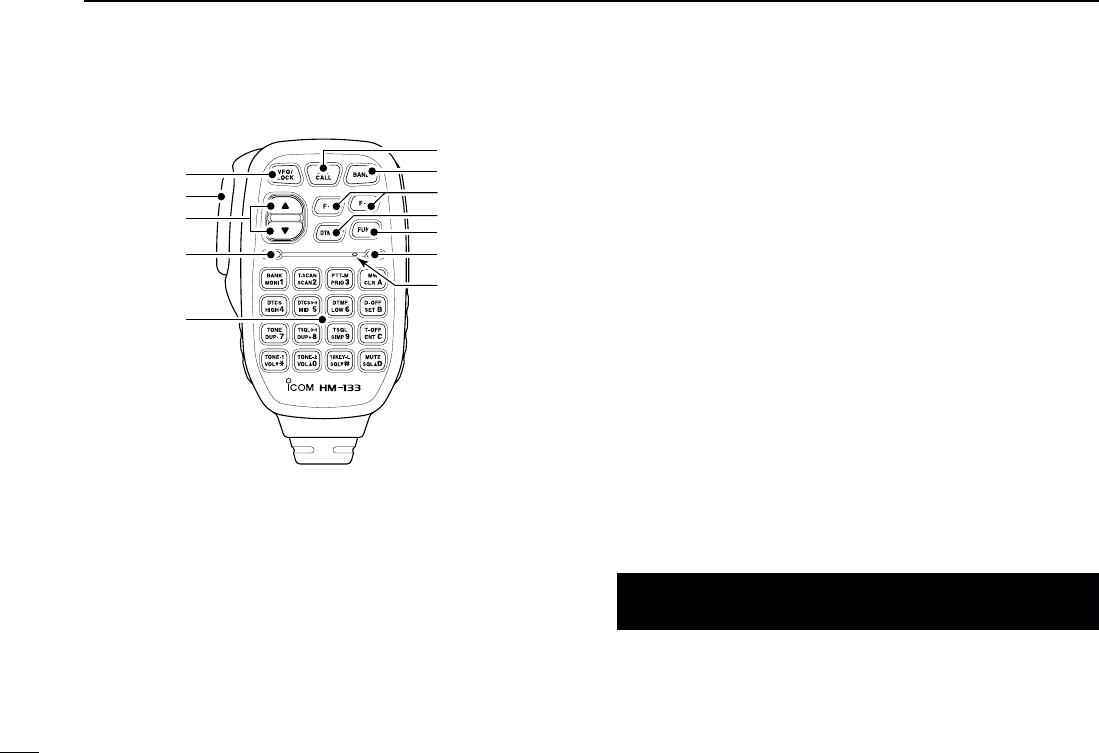
7
1PANEL DESCRIPTION
New2001
■Microphone (HM-133*)
qVFO/LOCK SWITCH [VFO/LOCK]
➥Push to select VFO mode. (p. 12)
➥Push for 1 sec. to switch the lock function ON and OFF.
(p. 15)
wPTT SWITCH
➥Push and hold to transmit; release to receive.
➥Switches between transmitting and receiving while the
one-touch PTT function is in use. (p. 21)
eUP/DOWN SWITCHES [Y]/[Z]
➥Push either switch to change operating frequency,
memory channel, set mode setting, etc.
(pgs. 13, 29, 56)
➥Push either switch for 1 sec. to start scanning. (p. 41)
rACTIVITY INDICATOR
➥Lights red while any key, except [FUNC] and [DTMF-S],
is pushed, or while transmitting.
➥Lights green while the one-touch PTT function is in use.
tKEYPAD (pgs. 8, 9)
yFUNCTION INDICATOR
➥Lights orange while [FUNC] is activated—indicates the
secondary function of switches can be accessed.
➥Lights green when [DTMF-S] is activated—DTMF sig-
nals can be transmitted with the keypad.
u2nd FUNCTION SWITCH [FUNC]
iDTMF SELECT SWITCH [DTMF-S] (p. 50)
oFUNCTION SWITCHES [F-1]/[F-2] (p. 66)
Program and recall your desired transceiver conditions.
!0BAND SWITCH [BAND] (p. 11)
Push to switches main band between left and right bands.
!1MEMORY/CALL SWITCH [MR/CALL]
➥Push to select memory mode. (p. 12)
➥Push for 1 sec. to select call channel. (p. 38)
✔
Important!
All keys on the microphone function for the main band only.
Mic element
q
e
r
t
w
y
u
i
o
!0
!1
*
A different microphone
may be supplied de-
pending on version.
IC-2720H.qxd 02.9.9 8:12 Page 7 (1,1)
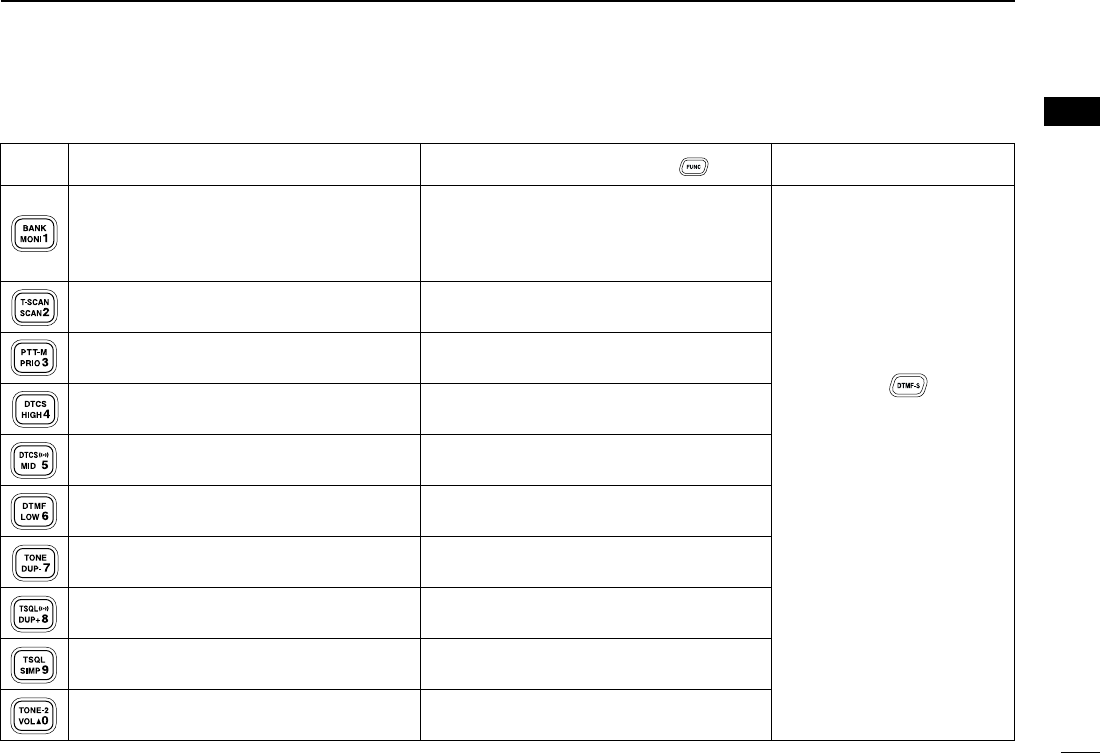
8
1
PANEL DESCRIPTION
New2001
1
■Microphone keypad
KEY FUNCTION SECONDARY FUNCTION ( +key) OTHER FUNCTIONS
Switches between opening and closing the
squelch. (p. 16)
Starts and stops scanning. (p. 41)
Starts and stops priority watch. (p. 47)
Selects high output power. (p. 20)
Selects mid. output power. (p. 20)
Selects low output power (p. 20)
Selects minus duplex operation. (p. 24)
Selects plus duplex operation. (p. 24)
Selects simplex operation. (p. 24)
Increases audio output level. (p. 16)
In VFO mode enters operating band select-
ing condition. (p. 12)
In memory mode enters bank selecting
condition. (p. 35)
Starts and stops tone scanning. (p. 55)
Turns the one-touch PTT function ON and
OFF. (p. 21)
Turns the DTCS squelch ON. (p. 53)
Turns the DTCS pocket beep function ON.
(p. 53)
Turns the DTMF memory encoder function
ON. (p. 49)
Turns the subaudible tone encoder ON.
(p. 24)
Turns the CTCSS pocket beep function
ON. (p. 53)
Turns the tone squelch function ON.
(p. 53)
Sends a 1750 Hz tone signal while pushing
and holding. (p. 26)
After pushing :
Transmits the appropriate
DTMF code. (pgs. 26, 50)
When the DTMF memory en-
coder is activated, push [0] to
[9] to transmit the appropriate
DTMF memory contents .
(p. 50)
IC-2720H.qxd 02.9.9 8:12 Page 8 (1,1)
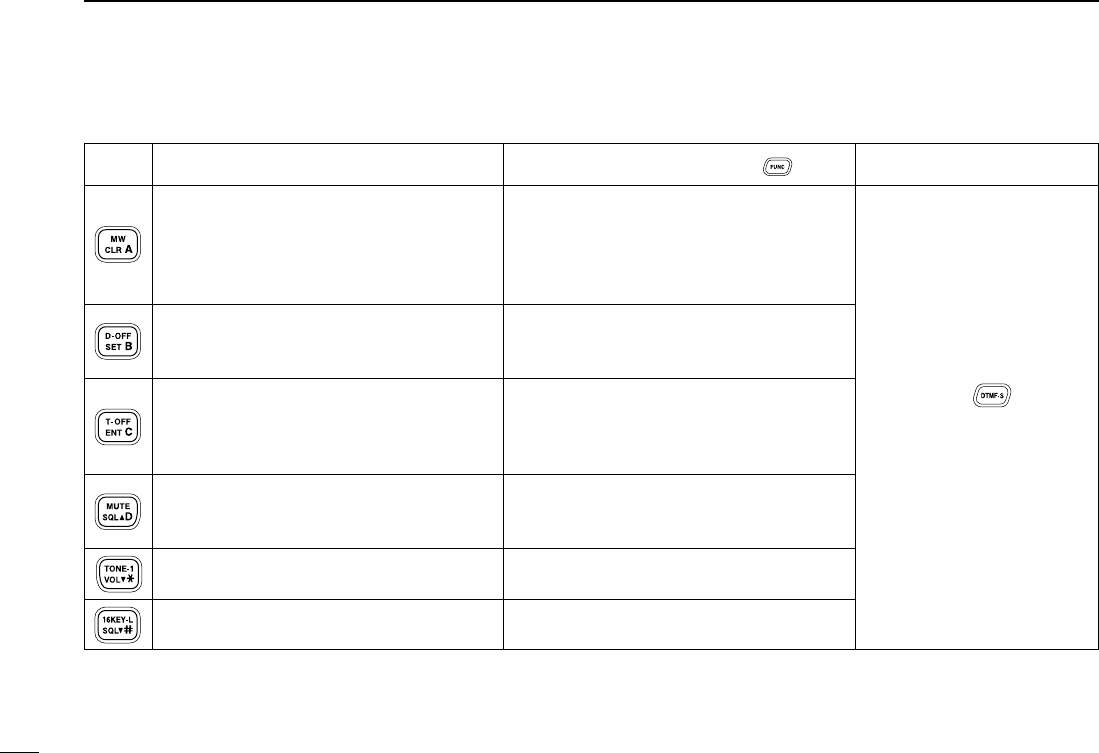
9
1PANEL DESCRIPTION
New2001
➥Cancels frequency entry. (p. 13)
➥Cancels the scan or priority watch.
(pgs. 41, 47)
➥Exit set mode. (p. 56)
➥Enters set mode (p. 56)
➥Advances the set mode selection order
after entering set mode. (p. 56)
➥Sets the keypad for numeral input.
(p. 13)
➥Reverses the set mode selection order
after entering set mode. (p. 56)
Adjusts the squelch level increments.
(p. 16)
Decreases audio output level. (p. 16)
Adjusts the squelch level decrement.
(p. 16)
➥Selects a memory channel for program-
ming. (p. 31)
➥Advances the memory channel number
when continuously pushed after pro-
gramming is completed. (p. 31)
DTMF memory encoder function OFF.
(p. 50)
Turns the subaudible tone encoder, pocket
beep or CTCSS/DTCS tone squelch OFF.
(pgs. 24, 53)
Mutes the audio. (p. 21)
•Mute function is released when any oper-
ation is performed.
Sends a 1750 Hz tone signal for 0.5 sec.
(p. 26)
Locks the digit keys on the keypad (includ-
ing the A to D, # and Mkeys. (p. 15)
After pushing :
Transmits the appropriate
DTMF code. (pgs. 26, 50)
KEY FUNCTION SECONDARY FUNCTION ( +key) OTHER FUNCTIONS
IC-2720H.qxd 02.9.9 8:12 Page 9 (1,1)
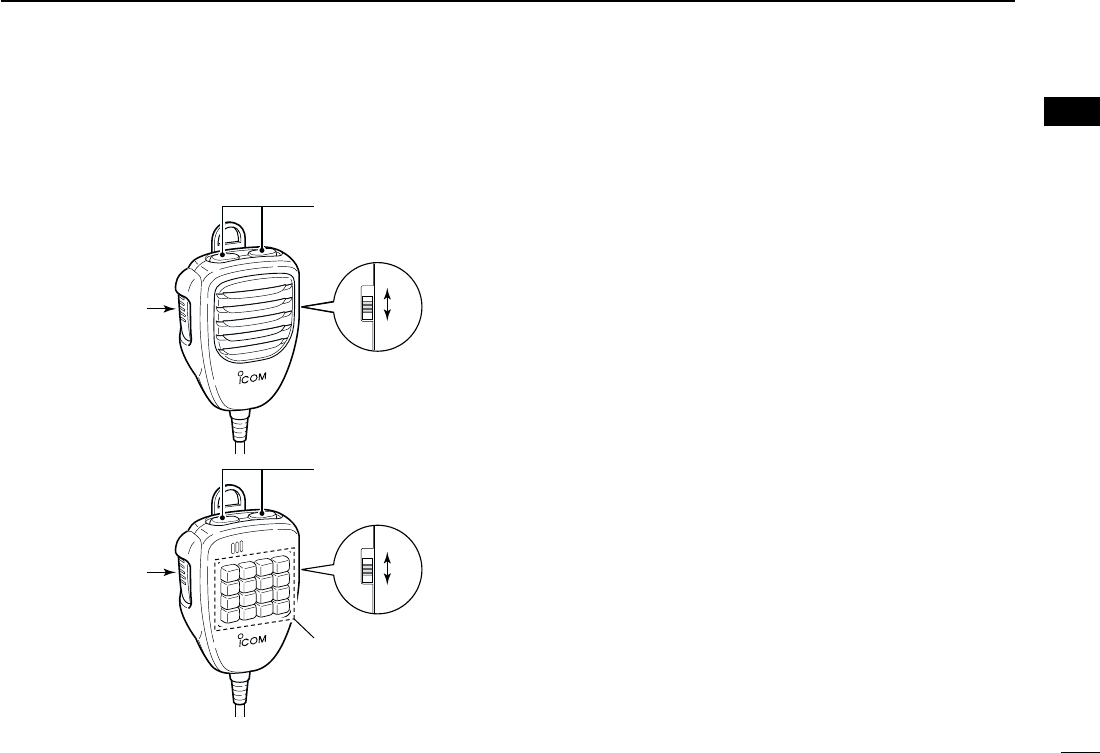
10
1
PANEL DESCRIPTION
New2001
1
■Optional Microphones
(HM-118N/TN/TAN)
qPTT SWITCH
➥Push and hold to transmit; release to receive.
wUP/DOWN SWITCHES [UP]/[DN]
➥Push either switch to change operating frequency,
memory channel, set mode setting, etc.
(pgs. 13, 29, 56)
➥Push either switch for 1 sec. to start scanning. (p. 41)
eUP/DN LOCK SWITCH
Slide to toggle [UP]/[DN] switches function ON and OFF.
rKEYPAD (HM-118TN/TAN only)
While pushing [PTT], push the desired key to send the
DTMF code.
w
q
ON
OFF
e
w
r
q
ON
OFF
e
• HM-118N
• HM-118TN/TAN
(DTMF)
IC-2720H.qxd 02.9.9 8:12 Page 10 (1,1)
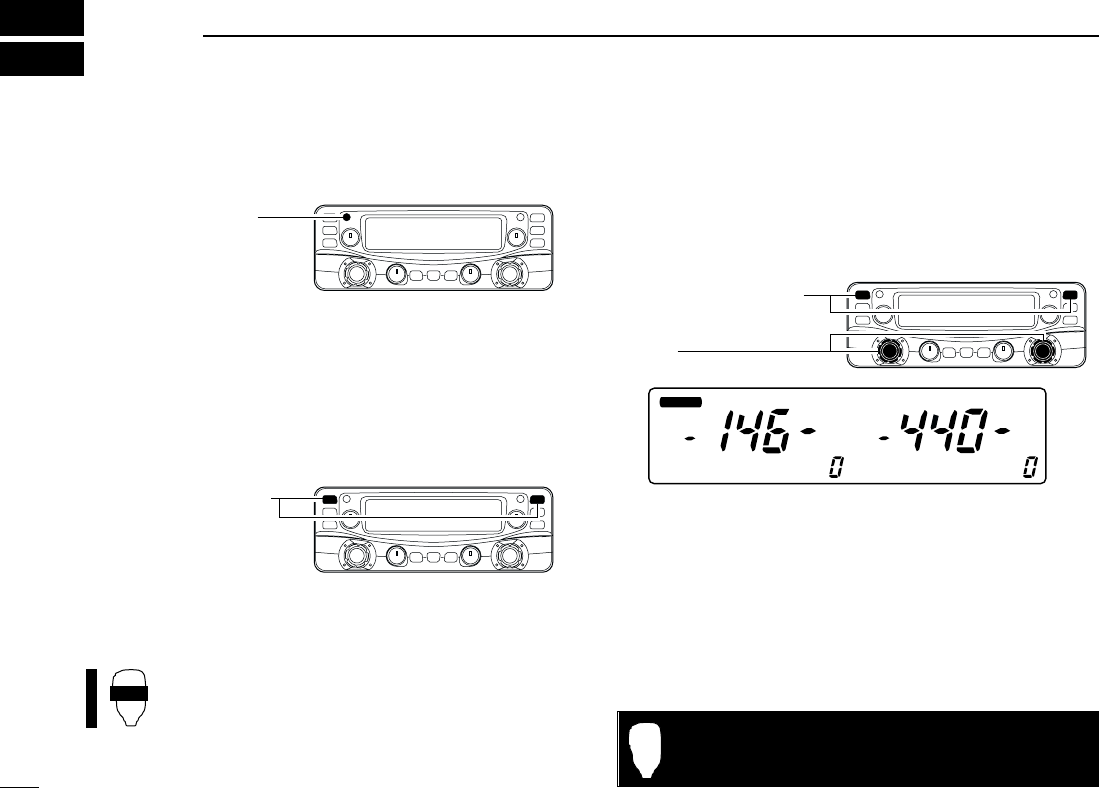
11
SETTING A FREQUENCY
New2001
2
■Preparation
DTurning power ON/OFF
➥Push [PWR] for 1 sec. to turn power ON and OFF.
DMAIN band
The IC-2720H can receive 144 MHz and 430(440) MHz band
signals simultaneously. To activate all functions access or to
change frequency via the microphone, you must designate
one band as the main band. The transceiver transmits a sig-
nal on the main band only.
➥Push the desired band’s [MAIN•BAND] to select the main
band.
•“Q” indicates the main band.
➥Push [BAND] to toggle the main band between
left and right bands.
DOperating frequency band selection
In the default condition, or after resetting the CPU, 2 m band
is assigned in the left band, 70 cm band is assigned in the
right band. However, the 2 m band can also be assigned into
the right, and 70 cm band can also be assigned into the left
band.
qPush the desired band’s [MAIN•BAND] for 1 sec.
•Frequency band initial appears.
wRotate the same band’s [DIAL] to select the desired fre-
quency band.
•Pushing [Y]/[Z] on the microphone also selects the band.
ePush the [MAIN•BAND] to return to frequency indication in
the selected frequency band.
MAIN
T X
MAIN
T X
MM
Frequency band initial is displayed.
Push the desired band’s
[MAIN•BAND] for 1 sec.
[DIAL]
BAND
Push the desired band’s
[MAIN•BAND]
Push [PWR] for 1 sec.
Note that in this manual, sections beginning with a micro-
phone icon (as at left), designate operation via the HM-133
microphone.
IC-2720H.qxd 02.9.9 8:12 Page 11 (1,1)
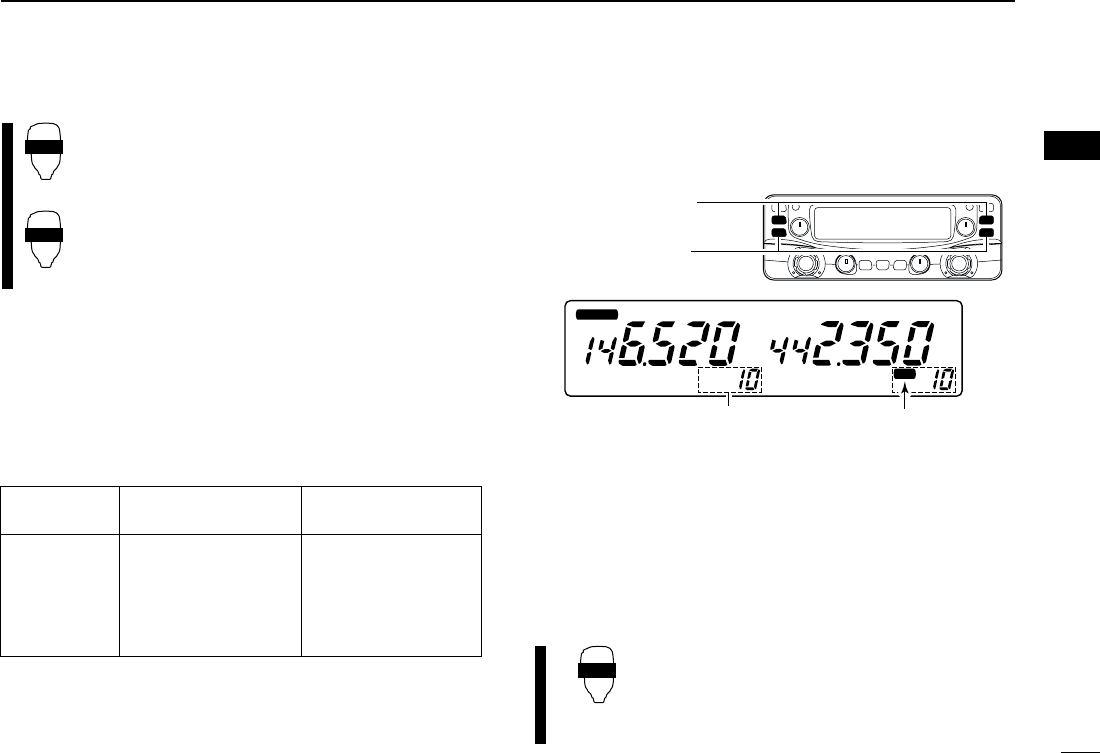
12
2
SETTING A FREQUENCY
New2001
2
zPush [BAND] to select main band.
xPush [FUNC], the push [
BANK
1(MONI)] to se-
lect frequency band selecting condition.
•The frequency band initial is displayed.
cPush [Y]/[Z] to select the desired frequency
band.
vPush [
CLR
A(MW)] to exit the condition, and re-
turn to frequency indication.
✔
About extra frequency bands
— USA and General versions only
In addition to the 2 m and 70 cm ham bands, the IC-2720H
USA and General versions have extra frequency bands for
each left and right bands as follow.
See the specifications for the available frequency bands for
details.
*The frequency band initials are default indication only. Once the op-
erating frequency is set in the band, the initial indication will be
changed. ✔: Available, —: Not available
DVFO and memory modes
The transceiver has 2 basic operating modes: VFO mode and
memory mode. Select VFO mode first to set an operating fre-
quency.
➥Push the desired band’s [V/MHz•SCAN] to select VFO
mode.
•When VFO mode is already selected, the digit below 10 MHz
(the digit below 1 MHz or 100 kHz disappear depending on ver-
sions) disappear. In this case, push [V/MHz•SCAN] again (or
twice or 3 times depending on version).
➥Push [M/CALL•MW] to select memory mode.
•“!” indicator appears when memory mode is selected.
➥Push [VFO/LOCK] to select VFO mode.
➥Push [MR/CALL] to select memory mode.
•The microphone controls the main band only. Push
[BAND] to toggle the main band, then push
[VFO/LOCK] or [MR/CALL], if necessary.
VFO/LOCK
MAIN
T X
MAIN
T X
MM
Push [M/CALL•MW]
to select memory mode
VFO mode is selected “!” indicator appears when
memory mode is selected
Push [V/MHz•SCAN]
to select VFO mode
BANK
[Y]/[Z]
Frequency Left band Right band
band initial*
127 ✔✔
222 ✔—
375 ✔✔
500 ✔✔
900 —✔
IC-2720H.qxd 02.9.9 8:12 Page 12 (1,1)
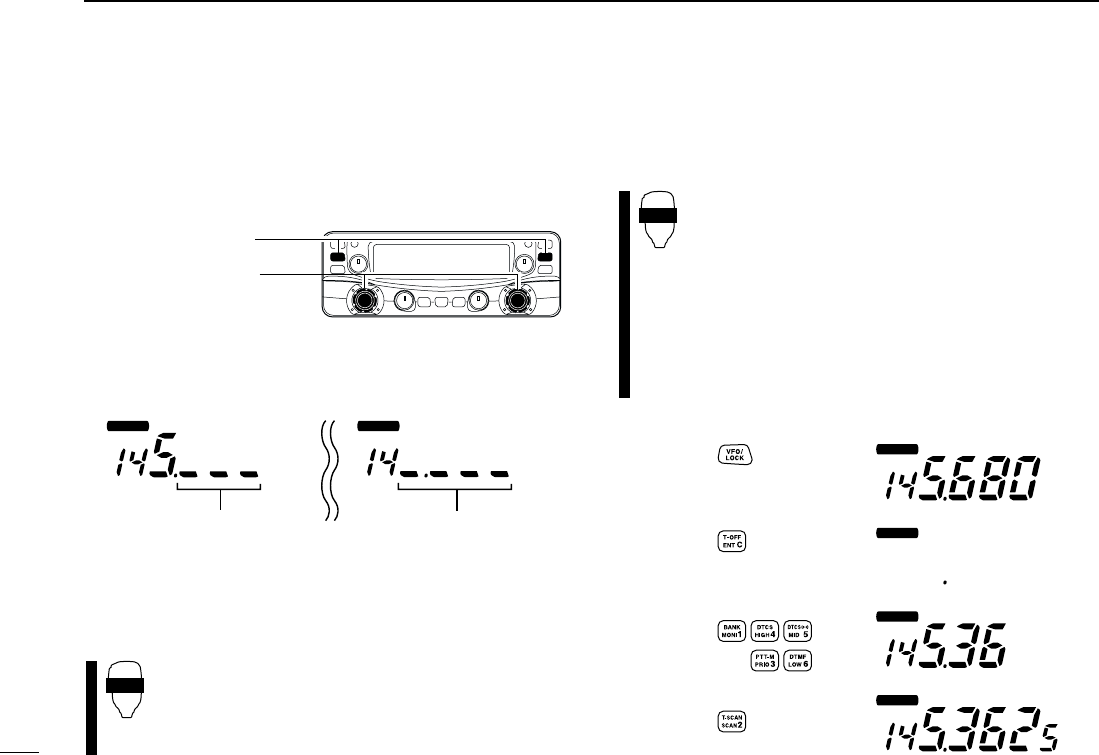
13
2SETTING A FREQUENCY
New2001
■Using the tuning dial
qRotate the desired band’s [DIAL] to set the frequency.
•If VFO mode is not selected, push the same band’s
[V/MHz•SCAN] to select VFO mode.
•The frequency changes in the selected tuning steps. (p. 14)
w
To change the frequency in 1 MHz (10 MHz for some versions)
steps, push [V/MHz•SCAN], then rotate [DIAL].
•Pushing [V/MHz•SCAN] for 1 sec. starts scan function. If scan
starts, push [V/MHz•SCAN] again to cancel it.
■Using the [Y]/[Z] keys
➥Push [Y] or [Z] to select the desired frequency.
•Push [BAND] to select the desired band (left or right)
as the main band in advance.
•Pushing [Y]/[Z] for 1 sec. activates a scan. If scan
starts, push [Y]/[Z] or [
CLR
A(MW)] to cancel it.
■Using the keypad
The frequency can be directly set via numeral keys on the mi-
crophone.
zPush [BAND] to select the desired band (left or
right) as the main band.
•Push [VFO/LOCK] to select VFO mode, if necessary.
xPush [
ENT
C(T-OFF)] to activate the keypad for
digit input.
cPush 6 keys to input a frequency.
•When a digit is mistakenly input, push [
ENT
C(T-OFF)]
to clear the input, then repeat input from the 1st digit.
•Pushing [
CLR
A(MW)] clears input digits and retrieves
the frequency.
MAIN
T X
MAIN
MAIN
T X
MAIN
T X
Push
Push
Push
Push
[EXAMPLE]: Setting frequency to 145.3625 MHz.
ENT
C
YZ
MAIN
T X
MAIN
T X
MM
While 1 MHz tuning step is
selected, the digit below
100 kHz disappear.
While 10 MHz tuning step
is selected, the digit below
1 MHz disappear.
Push [V/MHz•SCAN]
Rotate the tuning dial
IC-2720H.qxd 02.9.9 8:12 Page 13 (1,1)
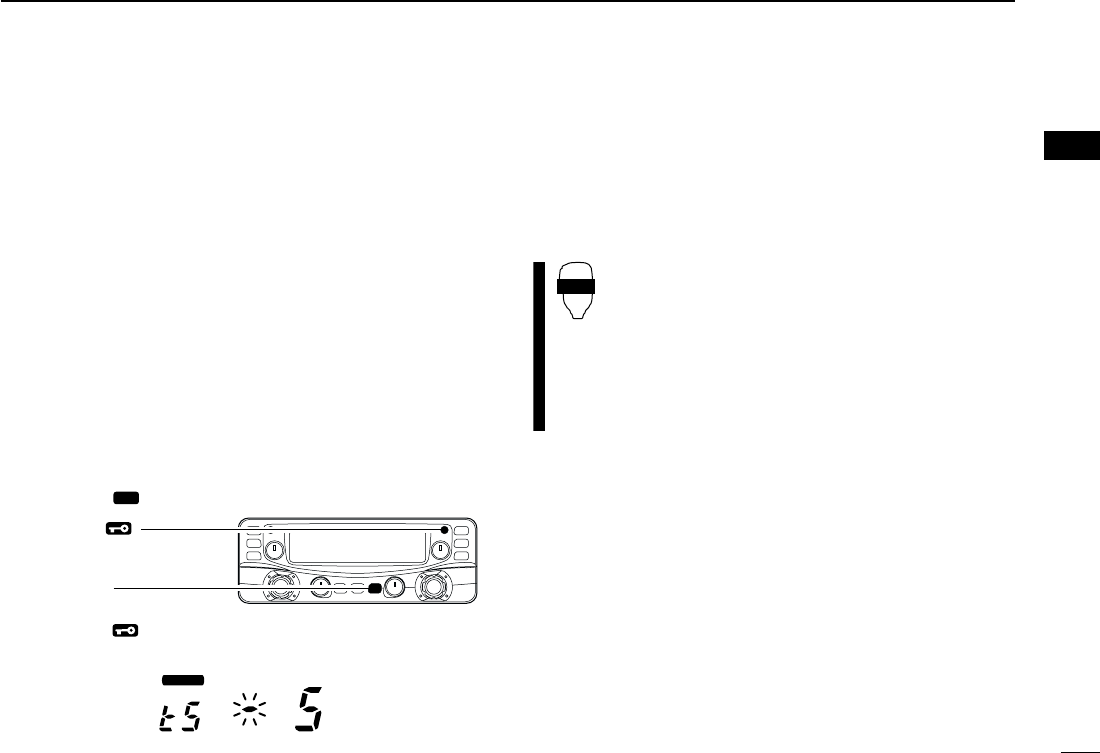
14
2
SETTING A FREQUENCY
New2001
2
■Tuning step selection
[
Tuning steps are the minimum frequency change increments
when you rotate [DIAL] or push [Y]/[Z] on the microphone.
Independent tuning step for the left and right, as well as each
frequency bands can be set for individual tuning convenience.
The following tuning steps are available.
•5 kHz •10 kHz •12.5 kHz •15 kHz
•20 kHz •25 kHz •30 kHz •50 kHz
☞NOTE: For convenience, select a tuning step that matches
the frequency intervals of repeaters in your area.
qPush the desired band’s [MAIN•BAND] to select the main
band.
•Push the same band’s [V/MHz•SCAN] to select VFO mode, if
necessary.
wPush [SET•] to enter set mode.
ePush [SET•] or [LOW•PRIO] several times until “tS” ap-
pears as shown below.
rRotate the same band’s [DIAL] to select the desired tuning
step.
tPush [TONE•DTMF] to exit set mode.
zPush [BAND] to select the desired band (left or
right) as the main band.
•Push [VFO/LOCK] to VFO mode, if necessary.
xPush [
SET
B(D-OFF)] to enter set mode.
cPush [
SET
B(D-OFF)] or [
ENT
C(T-OFF)] several
times until “tS” appears.
vPush [Y] or [Z] to select the desired tuning step.
bPush [
CLR
A(MW)] to exit set mode.
SET
B
MAIN
T X
M
Push [SET• ]
[LOW•PRIO]
IC-2720H.qxd 02.9.9 8:12 Page 14 (1,1)
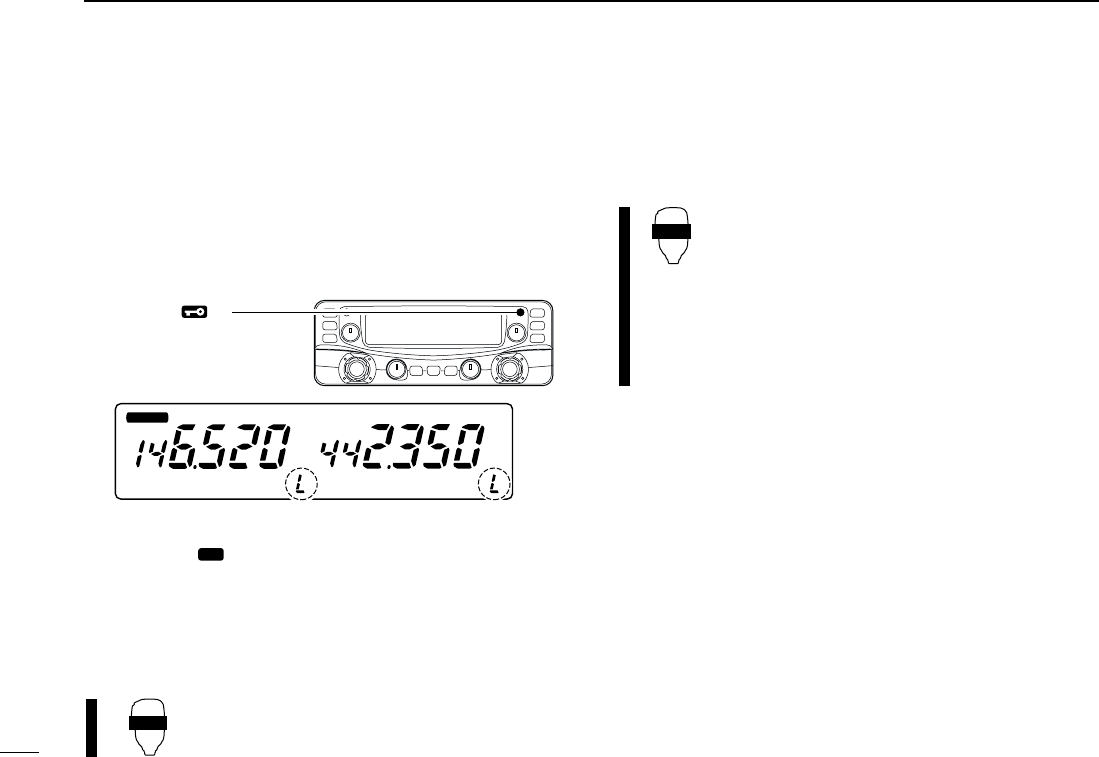
15
2SETTING A FREQUENCY
New2001
■Lock functions
To prevent accidental frequency changes and unnecessary
function access, use the lock function. The transceiver has 2
different lock functions.
DFrequency lock
This function locks [DIAL] and switches electronically and can
be used together with the microphone lock function.
➥Push [SET•] for 1 sec. to turn the lock function ON and
OFF.
•[PTT], [DUP•MONI] (monitor function only), [VOL], [SQL] and
[MAIN•BAND] (main band selection only) can be used while the
channel lock function is in use. Also, TONE-1, TONE-2, DTMF
tones or DTMF memory contents can be transmitted from the mi-
crophone.
➥Push [VFO/LOCK] for 1 sec. to switch the
lock function ON and OFF.
DMicrophone keypad lock
This function locks the microphone keypad.
➥Push [FUNC] then [
SQL
ZD(16KEY-L)] to
switch the microphone keypad lock function
ON and OFF.
•[PTT], [VFO/LOCK], [MR/CALL], [BAND], [Y], [Z],
[F-1], [F-2], [DTMF-S] and [FUNC] on the micro-
phone can be used.
•All switches on the transceiver can be used.
•The keypad lock function is released when the
power is turned OFF then ON again.
16KEY-L
VFO/LOCK
MAIN
T X
MAIN
T X
MM
Push [SET• ]
for 1 sec.
2 “L”s appear while the lock function is activated.
IC-2720H.qxd 02.9.9 8:12 Page 15 (1,1)
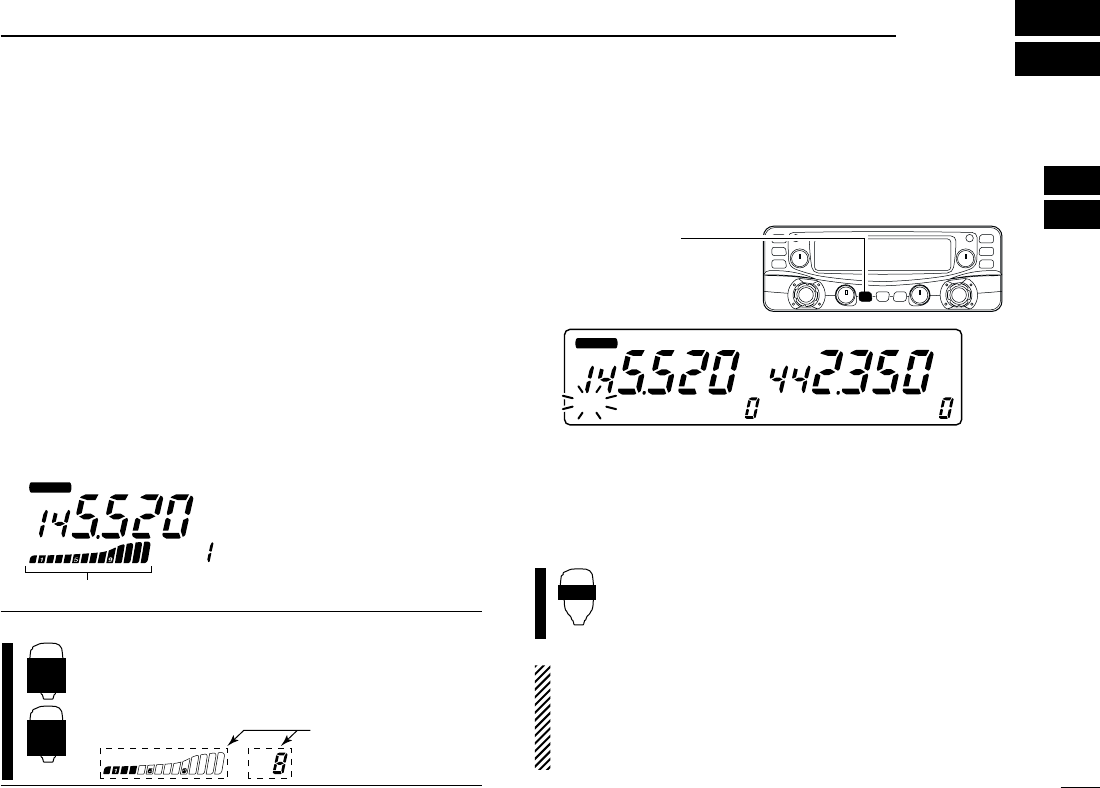
16
3
BASIC OPERATION
2
3
■Receiving
qSet the audio level for the main band.
➥Push the desired band’s [MAIN•BAND].
➥Push [DUP•MONI] for 1 sec. to open the squelch.
➥Rotate the main band’s [VOL] to adjust the audio level.
➥Push the [DUP•MONI] for 1 sec. to close the squelch.
wSet the squelch level.
➥Rotate the main band’s [SQL] fully counterclockwise in
advance, then rotate the [SQL] clockwise until the noise
just disappears.
•When interference is received, rotate the [SQL] clockwise
again for attenuator operation. (p. 17)
eSet the operating frequency in main band. (pgs. 11–13)
rWhen receiving a signal on the set frequency, squelch
opens and the transceiver emits audio.
•“BUSY” appears and the S/RF
indicator shows the relative
signal strength for the re-
ceived signal.
✔
CONVENIENT!
The main band’s audio and squelch level can also
be adjusted with [
VOL
Y(TONE-1)]/[
VOL
Z0(TONE-2)]
and [
SQL
YD(MUTE)]/[
SQL
Z#(16KEY-L)], respectively.
•“VOL” for audio or “SqL” for squelch appears during set.
■Monitor function
This function is used to listen to weak signals without disturb-
ing the squelch setting.
➥Push [DUP•MONI] for 1 sec. to open the squelch.
•Push [MIN•BAND] to select the desired band (left or right) as the
main band in advance.
•“BUSY” blinks.
•Push [DUP•MONI] for 1 sec. again to cancel the function.
➥Push [
MONI
1(BANK)] to open the squelch.
•Push [BAND] to select the desired band (left or right)
as the main band in advance.
•Push [
MONI
1(BANK)] again to cancel the function.
NOTE: When [SQL] is set to too far clockwise position, 12
to 17 hours. The squelch attenuator may be functioning,
even while monitoring. To monitor weak signals on the op-
erating frequency, deactivate the squelch attenuator func-
tion. See p. 17 for details.
MONI
1
BUSY
MAIN
T X
MAIN
T X
MM
Push [DUP•MONI]
for 1 sec.
M
Show set level.
SQLY/Z
D/#
VOLY/Z
M/0
BUSY
MAIN
T X
M
Appears when receiving a signal.
IC-2720H.qxd 02.9.9 8:12 Page 16 (1,1)
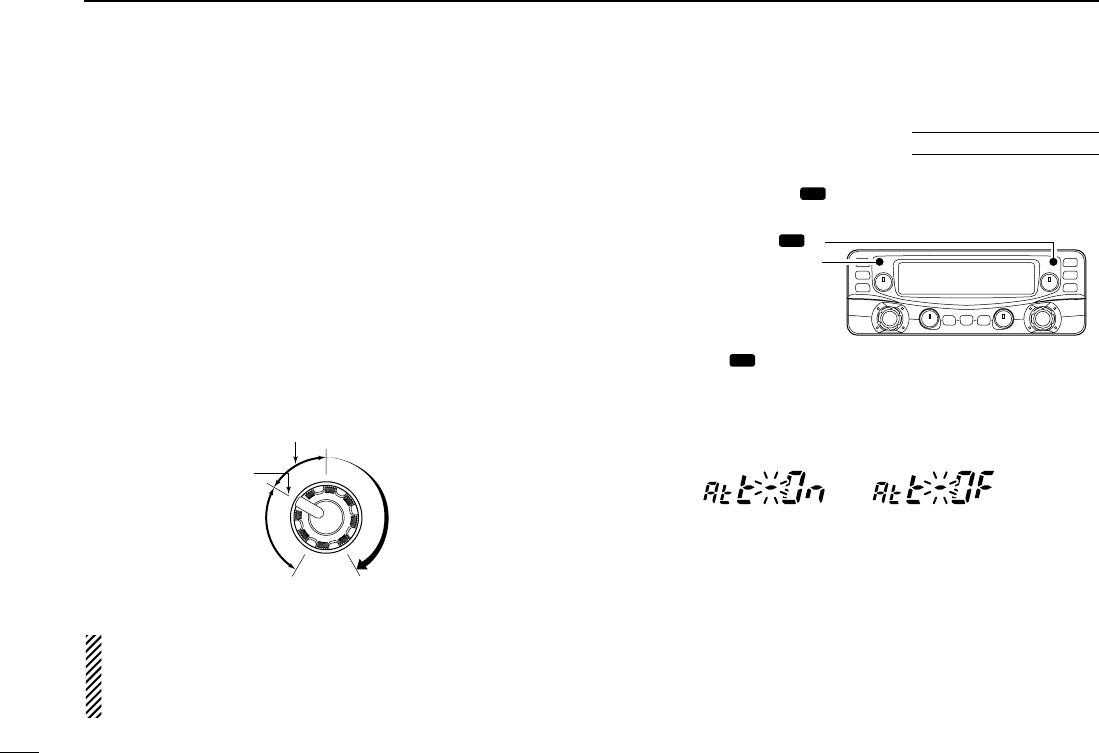
17
3BASIC OPERATION
New2001
■Squelch attenuator
The transceiver has an RF attenuator related to the squelch
level setting. Approx. 10 dB attenuation is obtained at maxi-
mum setting.
The squelch attenuator allows you to set a minimum signal
level needed to open the squelch. The attenuator function can
be deactivated in initial set mode.
➥Rotate [SQL] clockwise past the 12 o’clock position to ac-
tivate the squelch attenuator.
•Attenuation level can be adjusted up to 10 dB (approx.) between
12 o’clock and fully clockwise position.
•When setting the squelch from the microphone, a level greater
than ‘19’activates the squelch attenuator.
NOTE: The squelch attenuator functions even when the
monitor function is in use. Thus set the [SQL] control within
10 to 12 o’clock position is recommended when using the
monitor function.
DSquelch attenuator setting
qTurn the transceiver power OFF.
wWhile pushing
[SET•],
turn the power ON to enter initial
set mode.
ePush
[SET•] or [LOW•PRIO] to select “Att-On” (squelch
attenuator) item.
rRotate the left band’s [DIAL] to toggle the function ON and
OFF.
•Select “OF” to deactivate the squelch attenuator function.
tPush [PWR] to exit initial set mode.
MAIN
T X
M
MAIN
T X
M
While pushing [SET• ]
push [PWR] to enter initial
set mode
USING
INITIAL SET MODE
Squelch is
open.
Squelch
attenuator
Squelch
threshold
Shallow Deep
Noise squelch
IC-2720H.qxd 02.9.9 8:12 Page 17 (1,1)
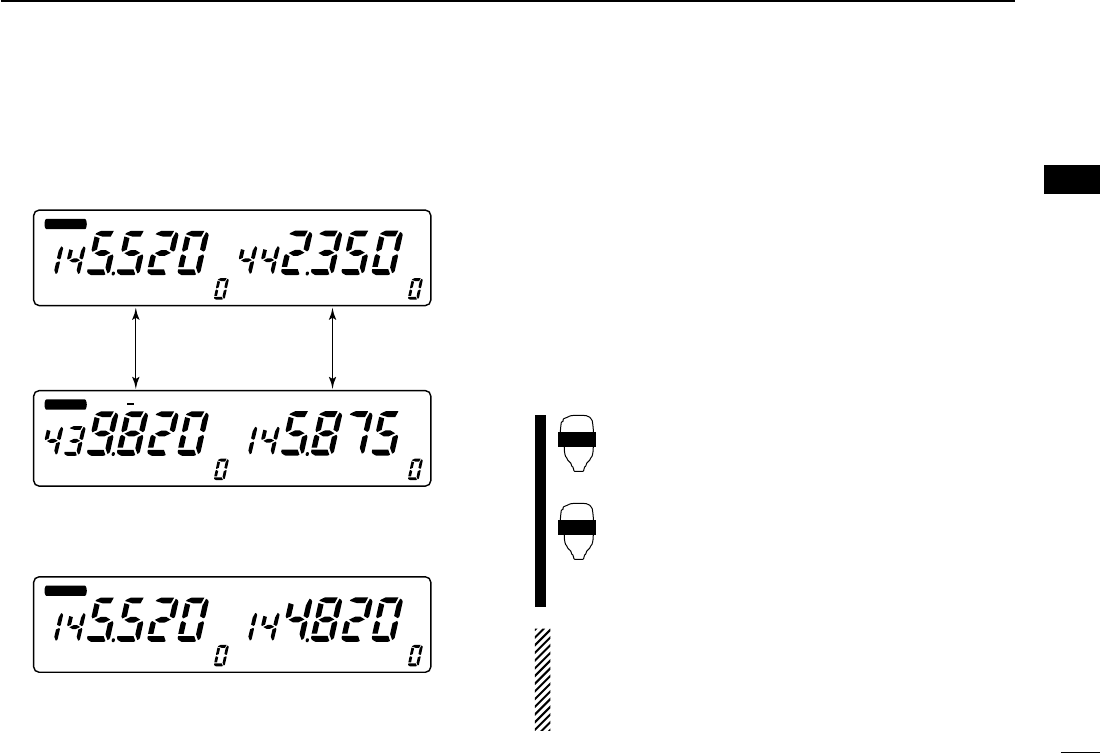
■V/V, U/U simultaneous receive (Para-watch)
18
3
BASIC OPERATION
New2001
3
The IC-2720H can simultaneously receive two signals on the
same band, such as 144 MHz band, using the para-watch
function.
qPush either the left or right band’s [MAIN•BAND] for 1 sec.
to select the frequency band selecting condition.
wRotate the same band’s [DIAL] to select the desired fre-
quency band.
ePush the [MAIN•BAND] to return to frequency indication.
rSet the desired frequency.
tRepeat the steps qto rfor the other band (left or right).
To activate the para-watch function from the HM-133, enter
the desired frequencies for each the left and right bands using
the direct frequency input capability via the keypad; or per-
form the following operation.
zPush [FUNC], the push [
BANK
1(MONI)] to se-
lect frequency band selecting condition.
•The frequency band initial appears on the main band.
xPush [Y]/[Z] to select the desired frequency
band band.
cPush [
CLR
A(MW)] to exit the condition, and re-
turn to frequency indication.
vPush [VFO/LOCK] to change main band, then
repeat the steps zto cfor the other band.
NOTE:
•Memory channels are common for the left and right band.
•Transmitting during the para-watch operation is possible.
However, the sub band’s reception is deactivated during
transmit.
BANK
[Y]/[Z]
MAIN
T X
MAIN
T X
MM
MAIN
T X
DUP
MAIN
T X
MM
MAIN
T X
MAIN
T X
MM
Can be switched
between VHF and
UHF.
[Example]
IC-2720H.qxd 02.9.9 8:12 Page 18 (1,1)
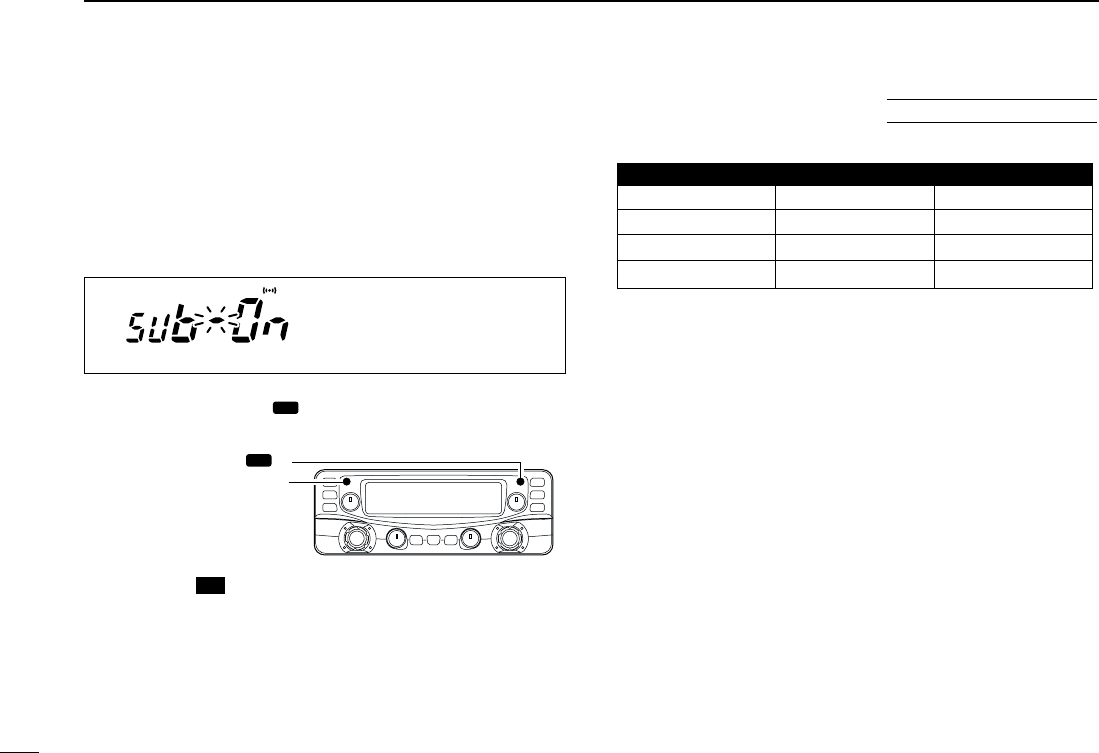
The sub band mute function automatically cuts out sub band
audio signals when both main and sub band signals are re-
ceived simultaneously.
While operating on the main band, a beep sounds to inform
you that a signal was received on the sub band.
qWhile pushing [SET•], push [PWR] for 1 sec. to enter
initial set mode.
wPush [SET•] or [LOW•PRIO] until “SUb” appears in the
display as shown above.
eRotate the left band’s [DIAL] to select the condition.
rPush [PWR] momentarily, to exit initial set mode and return
to the previous indications.
While pushing [SET• ]
push [PWR] to enter initial
set mode
MAIN
T X
M
The display shows that
the sub band mute is
turned ON and sub band
busy beep is turned ON.
19
3BASIC OPERATION
New2001
■Sub band mute/sub band busy beep
USING
INITIAL SET MODE
DISPLAY SUB BAND MUTE BUSY BEEP
SUb-OF OFF OFF
SUb-OF SOFF ON
SUb-On ON OFF
SUb-On SON ON
IC-2720H.qxd 02.9.9 8:12 Page 19 (1,1)
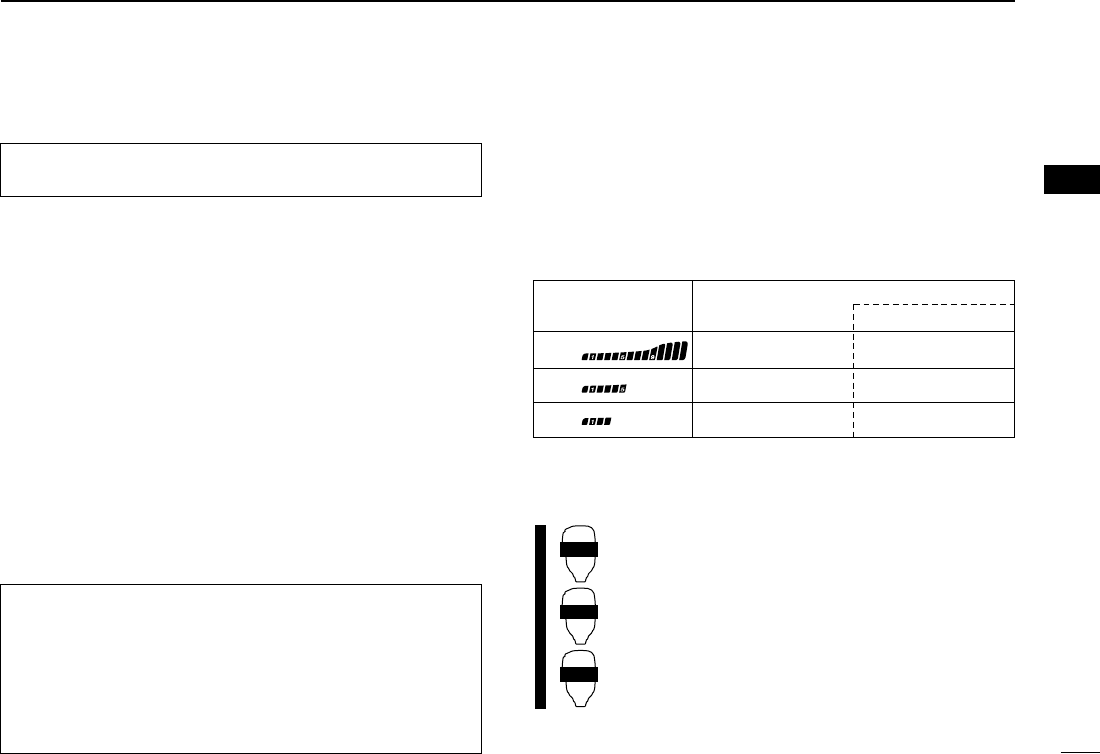
20
3
BASIC OPERATION
New2001
3
■Transmitting
☞NOTE: To prevent interference, listen on the channel be-
fore transmitting by pushing [DUP•MONI] for 1 sec., or
[
MONI
1(BANK)] on the microphone.
qSelect the main band. (p. 11)
wSet the operating frequency. (pgs. 11–13)
•Select output power if desired. See section at right for details.
ePush and hold [PTT] to transmit.
•“$” appears.
•The S/RF indicator shows the output power selection.
•A one-touch PTT function is available. See p. 21 for details.
•“Si” may blinks instead of the sub band’s memory channel num-
ber indication according to the selected frequency band.
rSpeak into the microphone using your normal voice level.
•DO NOT hold the microphone too close to your mouth or speak
too loudly. This may distort the signal.
tRelease [PTT] to return to receive.
■Selecting output power
The transceiver has 3 output power levels to suit your oper-
ating requirements. Low output powers during short-distance
communications may reduce the possibility of interference to
other stations and will reduce current consumption.
➥Push [LOW•PRIO] once or twice to select the output
power.
*approx.
•The output power can be changed while transmitting.
The microphone can also be used to select output power.
➥Push [
HIGH
4(DTCS)] for high output power;
[
MID
5(DTCSS)] for middle output power; and
[
LOW
6(DTMF)] for low output power.
•The output power can be changed via the microphone
during receive only.
HIGH
4
MID
5
LOW
6
IMPORTANT! (for 50/35 W transmission):
The IC-2720H is equipped with protection circuit to protect
the power amplifier circuit from high SWR (Standing Wave
Ratio) and temperature. When a high SWR antenna or no
antenna is connected, or when the transceiver temperature
becomes extremely high, the transceiver reduces transmit
output power to 15 W (approx.) automatically.
CAUTION: Transmitting without an antenna will damage
the transceiver.
S/RF INDICATOR POWER OUTPUT
VHF/UHF Taiwan
50 W/35 W 25 W
15 W*/15 W* 15 W*
5 W*/5 W* 5 W*
High:
Mid:
Low:
IC-2720H.qxd 02.9.9 8:12 Page 20 (1,1)
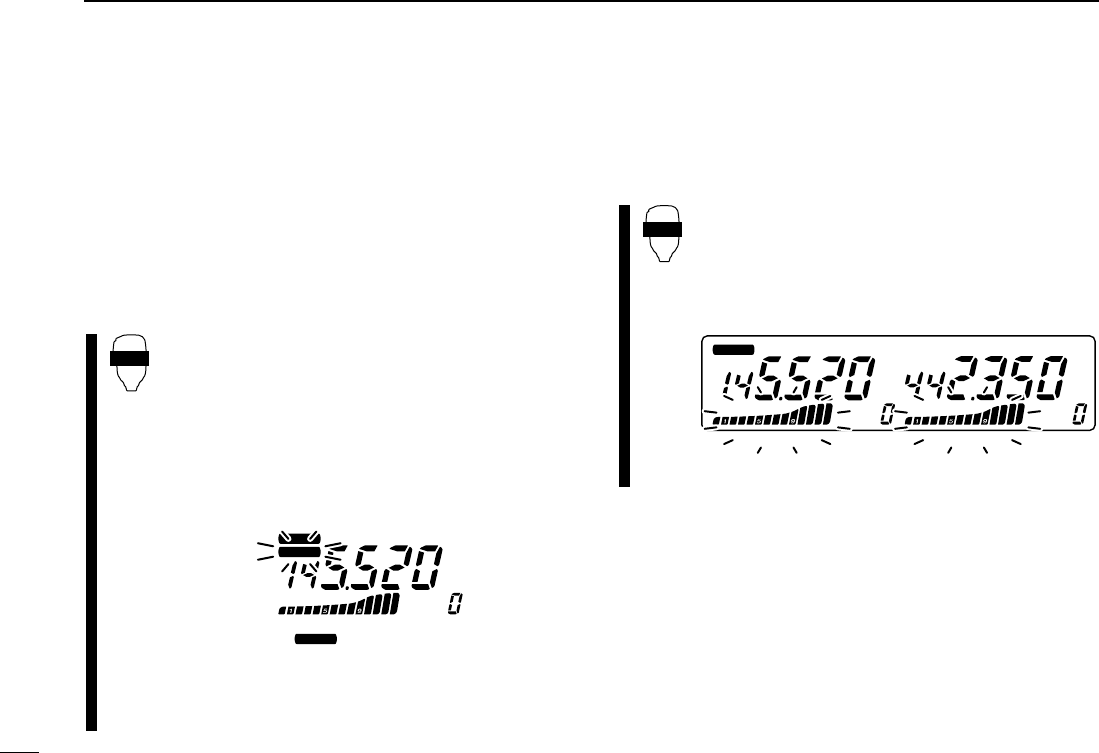
21
3BASIC OPERATION
New2001
■One-touch PTT function
The PTT switch can be operated as a one-touch PTT switch
(each push toggles between transmit/receive). Using this
function you can transmit without pushing and holding the
PTT switch.
To prevent accidental, continuous transmissions with this
function, the transceiver has a time-out timer. See p. 61 for
details.
zPush [FUNC] then [
PRIO
3(PTT-M)] to turn the
one-touch PTT function ON.
•The activity indicator lights green.
xPush [PTT] to transmit and push again to re-
ceive.
•A beep sounds when transmission is started and a
long beep sounds when returning to receive.
•“$” blinks when transmitting with the one-touch
PTT function.
cPush [FUNC] then [
PRIO
3(PTT-M)] to turn the
one-touch PTT function OFF.
•The activity indicator goes out.
■Audio mute function
This function temporarily mutes the audio without disturbing
the volume setting.
➥Push [FUNC] then [
SQL
YD(MUTE)] to mute
audio signals.
•Both the left and right bands S/RF meter blink in full-
scale condition.
•Push [
CLR
A(MW)] (or any other key) to cancel the
function.
BUSY
MAIN
T X
MAIN
T X
MM
S/RF meter blinks (full-scale).
MUTE
MAIN
T X
T X
M
indicator blinks
PTT-M
IC-2720H.qxd 02.9.9 8:12 Page 21 (1,1)
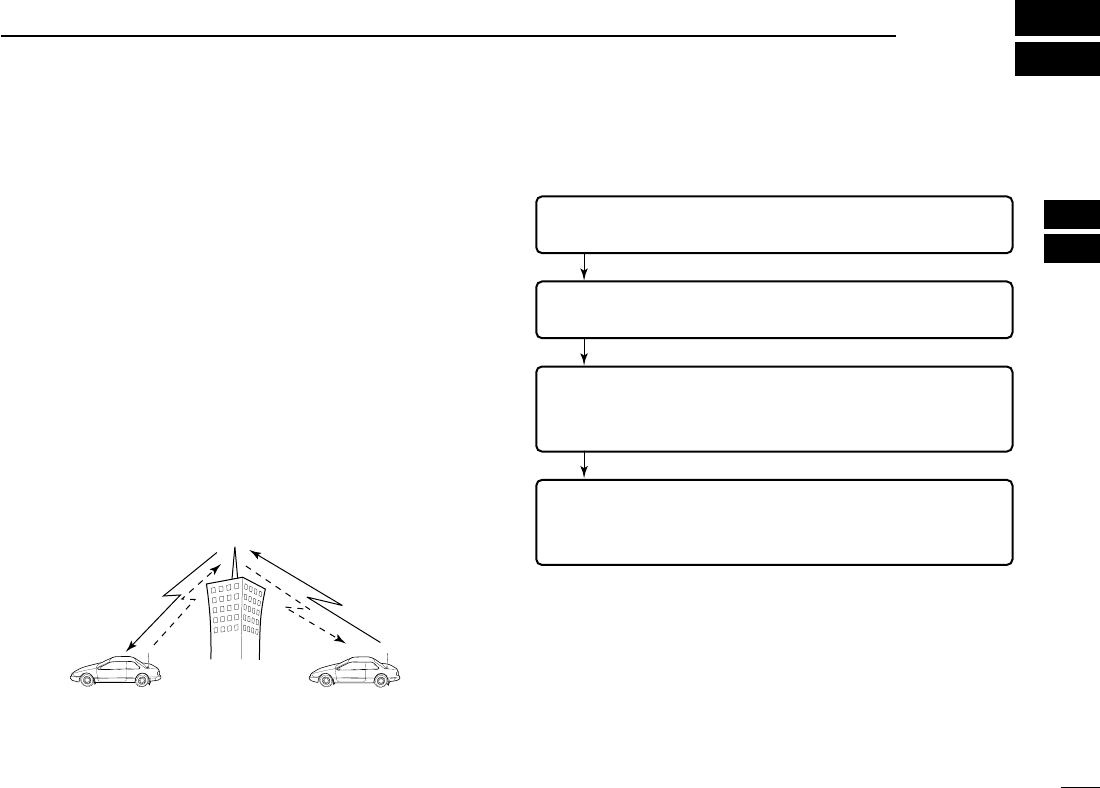
22
4
REPEATER OPERATION
3
4
■General
Repeaters allow you to extend the operatable range, and also
settle blind zone. Because a repeater has much higher output
power than the typical transceiver, and installed into a broad
view.
Normally, a repeater has independent frequency for each re-
ceive and transmit, and a subaudible tone may be required
to accessing a repeater.
Refer amateur radio handbook, ham magazine for details of
local repeater, such as repeater input/output frequencies and
location.
•Repeater operation flow chart
•The IC-2720H USA version has the auto repeater function. Thus the
steps 3 and 4 may not be necessary, depending on the setting.
•Repeater settings can be stored into a memory channel.
Setp 3:
Set the duplex (shifting) direction (– duplex or +duplex).
- Set the offset frequency (shifting value), if required.
Setp 4:
Set the subaudible tone (repeater tone) encoder function ON.
- Set the subaudible tone frequency, if required.
Setp 1:
Set the desired band to operate the repeater.
Setp 2:
Set the desired receive frequency (repeater output frequency).
Repeater example;
Receives the 444.540 MHz signal
and the detected audio signals are
transmitted on 449.540 MHz simul-
taneously.
Station A:
Tx: 444.540 MHz
Rx: 449.540 MHz
Station B:
Tx: 444.540 MHz
Rx: 449.540 MHz
IC-2720H.qxd 02.9.9 8:12 Page 22 (1,1)
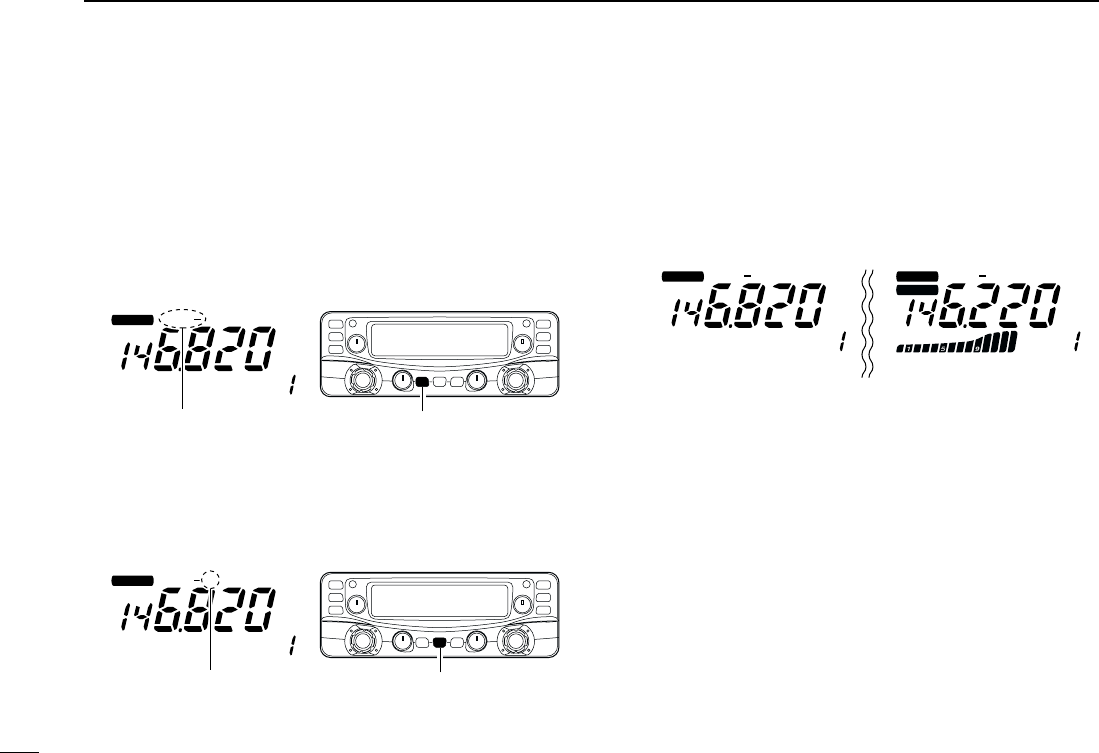
■Accessing a repeater
qSet the receive frequency (repeater output frequency) on
the main band. (pgs. 11–13)
wPush [DUP•MONI] one or two times, to select minus du-
plex or plus duplex.
•“DUP–” or “DUP” appears to indicate the transmit frequency for
minus shift or plus shift, respectively.
•When the auto repeater function is turned ON (available for the
USA version only), steps wand eare not necessary. (p. 28)
ePush [TONE•DTMF] several times to turn ON the subaudi-
ble tone encoder, according to repeater requirements.
•
“T” appears
•88.5 Hz is set as the default; refer to p. 25 for tone frequency set-
tings.
•When the repeater requires a different tone system, see p. 26.
rPush and hold [PTT] to transmit.
•The displayed frequency automatically changes to the transmit
frequency (repeater input frequency).
•If
“OFF” appears, confirm that the offset frequency (p. 27) is set
correctly.
tRelease [PTT] to receive.
yPush [DUP•MONI] to check whether the other station’s
transmit signal can be received directly.
uTo return to simplex operation, push [DUP•MONI] once or
twice, to clear the “DUP–” or “DUP” indicator.
iTo turn OFF the subaudible tone encoder, push
[TONE•DTMF] several times until no tone indicators ap-
pear.
MAIN
T X
DUP T
M
MAIN
T X
DUP T
M
While receiving While transmitting
MAIN
T X
DUP T
M
Push [TONE•DTMF] once or twice
“T” appears
MAIN
T X
DUP
M
Push [DUP•MONI] once or twice
“DUP–” or “DUP” appear
23
4REPEATER OPERATION
New2001
IC-2720H.qxd 02.9.9 8:12 Page 23 (1,1)
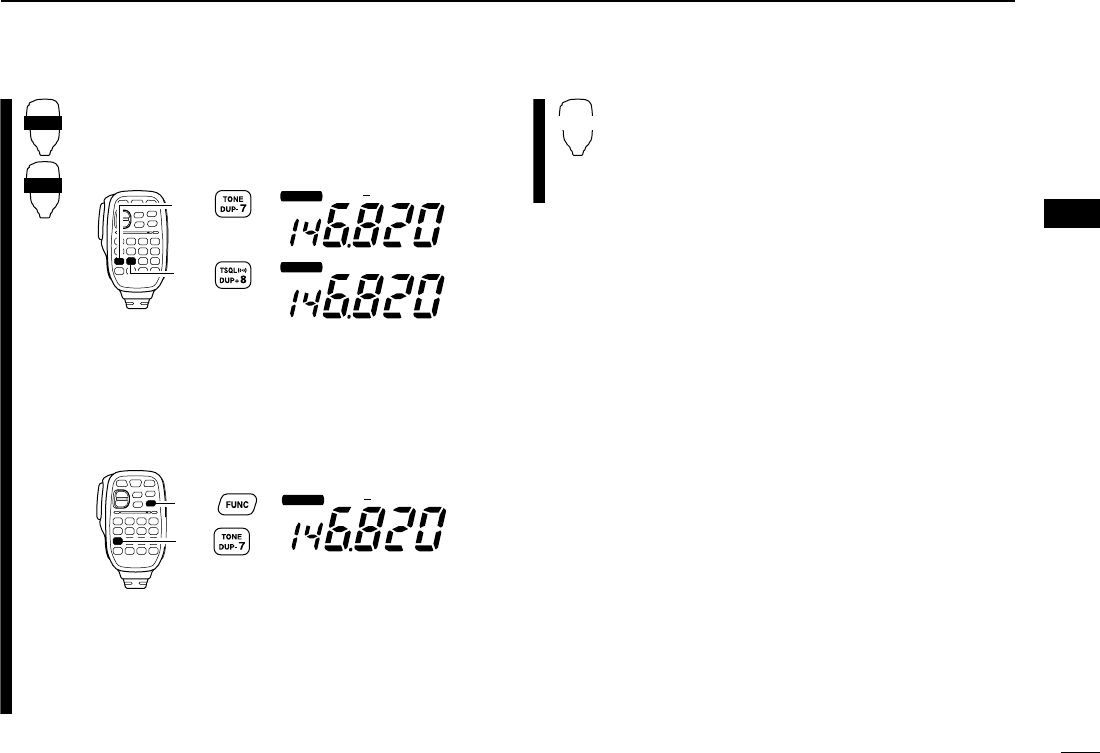
24
4
REPEATER OPERATION
New2001
4
zSet the receive frequency (repeater output fre-
quency) on the main band. (pgs. 11–13)
xPush [
DUP
–7(TONE)] to select minus duplex;
push [
DUP
+ 8(TSQLS)] to select plus duplex.
cPush [FUNC] then [
DUP
–7(TONE)] to turn ON
the subaudible tone encoder according to re-
peater requirements.
•Refer to p. 25 for the tone frequency setting.
•When the repeater requires a different tone system,
see p. 26.
vPush and hold [PTT] to transmit.
bRelease [PTT] to receive.
nPush [
MONI
1(BANK)] to check whether the
other station’s transmit signal can be received
directly.
mPush [
SIMP
9(TSQL)] to return to simplex opera-
tion.
•“DUP” or “DUP–” indicator disappears.
,To turn OFF the subaudible tone encoder, push
[FUNC] then [
ENT
C(T-OFF)].
SIMP
9
MAIN
T X
DUP T
Push ,
then .
MAIN
T X
DUP
MAIN
T X
DUP
Push
Push
DUP–
7
DUP+
8
IC-2720H.qxd 02.9.9 8:12 Page 24 (1,1)
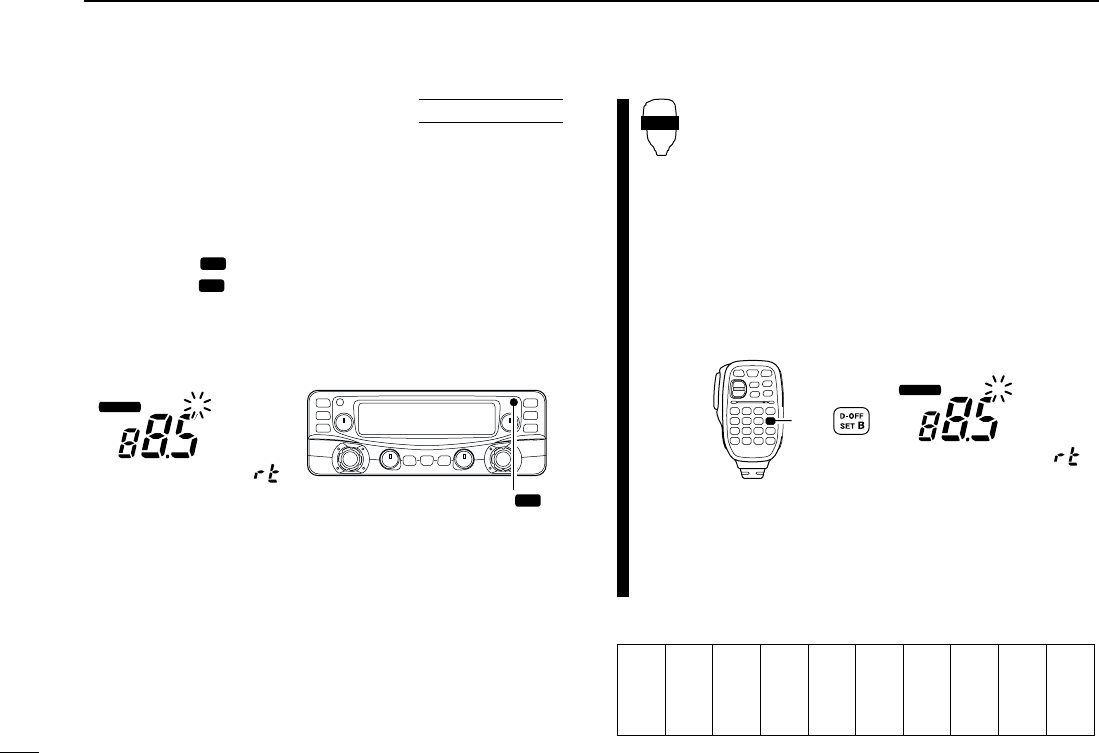
■Subaudible tones
(Encoder function)
DSubaudible tones
qSelect the main band, mode/channel you wish to set the
subaudible tones to, such as VFO mode or memory/call
channel.
wPush [SET•] to enter set mode.
e
Push [SET•] or [DUP•MONI] several times until “T”
and
“rt” appear; or until “T SQL” and “Ct” appear for tone
squelch or pocket beep use.
•When “d” is displayed in place of the 100 MHz digit, cancel the
DTMF memory encoder in advance. (p. 50)
rRotate the main band’s [DIAL] to select and set the desired
subaudible frequency.
tPush [TONE•DTMF] to exit set mode.
☞NOTE: The subaudible tone encoder frequency can be set
in a memory/call channel temporarily. However, the set fre-
quency is cleared once another memory channel or VFO
mode is selected. To store the tone frequency permanently,
overwrite the channel information.
zSet the main band, mode/channel you wish to
set the subaudible tones to, such as VFO mode
or memory/call channel.
•The subaudible tone frequency is independently pro-
grammed into each mode or channel.
xPush [
SET
B(D-OFF)] to enter set mode.
c
Push [
SET
B(D-OFF)] or [
ENT
C(T-OFF)] several
times until “T”
and “rt” appears; or until “T SQL”
and “Ct” appears for tone squelch or pocket
beep use.
•
When “d” is displayed in place of the 100 MHz digit,
cancel the DTMF memory encoder in advance. (p. 50)
vPush [Y] or [Z] to select and set the desired
subaudible tone frequency.
•Push and hold [Y]/[Z] to change the above tones
continuously.
bPush [
CLR
A(MW)] to exit set mode.
•Subaudible tone frequency list (unit: Hz)
67.0
69.3
71.9
74.4
77.0
79.7
82.5
85.4
88.5
91.5
94.8
97.4
100.0
103.5
107.2
110.9
114.8
118.8
123.0
127.3
131.8
136.5
141.3
146.2
151.4
156.7
159.8
162.2
165.5
167.9
171.3
173.8
177.3
179.9
183.5
186.2
189.9
192.8
196.6
199.5
203.5
206.5
210.7
218.1
225.7
229.1
233.6
241.8
250.3
254.1
MAIN
T X
T
M
Push
SET
B
MAIN
T X
T
M
[SET• ]
“T” and “rt” appear
USING
SET MODE
25
4REPEATER OPERATION
New2001
IC-2720H.qxd 02.9.9 8:12 Page 25 (1,1)
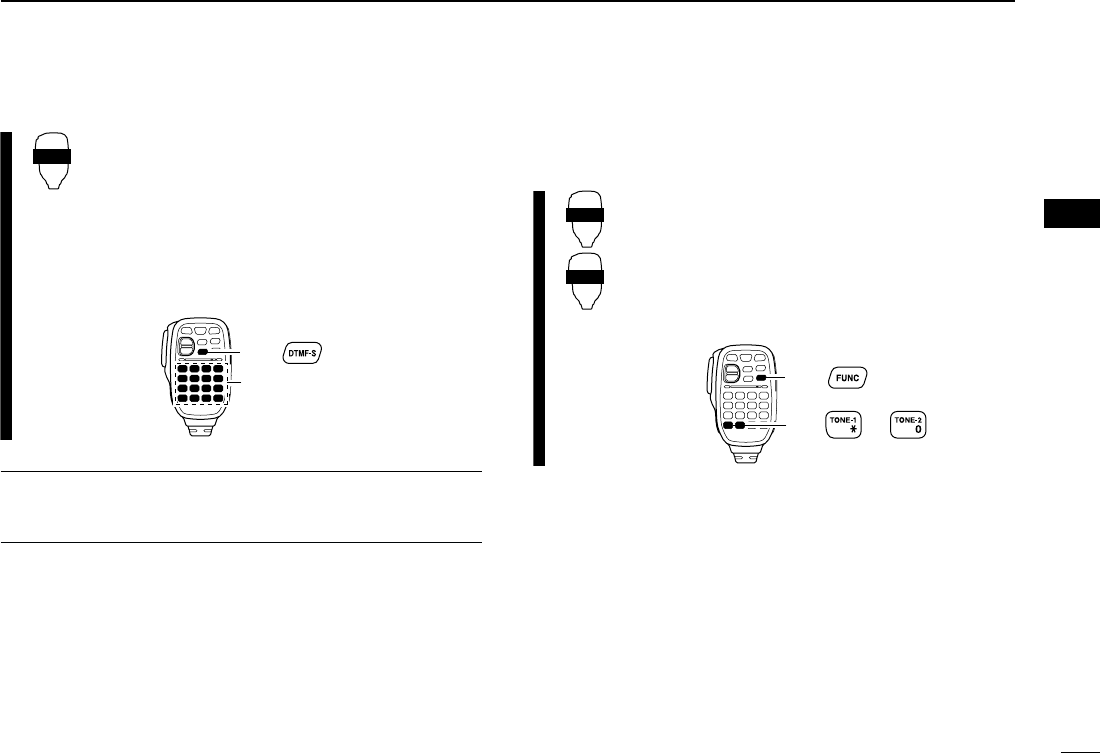
26
4
REPEATER OPERATION
New2001
4
DDTMF tones
➥Push [DTMF-S], then push the keys of the de-
sired DTMF digits.
•The function indicator lights green.
•0–9, A–D, M(E) and #(F) are available.
•When “d” is displayed in place of the 100 MHz digit,
cancel the DTMF memory encoder in advance.
(p. 50)
•Push [DTMF-S] again to return the keypad to nor-
mal function control.
✔
For your convenient!
The transceiver has 14 DTMF memory channels for au-
topatch operation. See p. 48 for details.
D1750 Hz tone
The microphone has 1750 Hz tone capability, used for ring
tone when calling, etc.
zPush [FUNC].
•The function indicator lights orange.
xPush [MM(TONE-1)] to transmit a 1750 Hz tone
call signal for 0.5 sec.; push and hold
[0(TONE-2)] to transmit a 1750 Hz tone call
signal for an arbitrary period.
•The function indicator goes out automatically.
Push ,
then or .
TONE-1
TONE-2
then push desired keys.
Push ,
DTMF-S
IC-2720H.qxd 02.9.9 8:12 Page 26 (1,1)
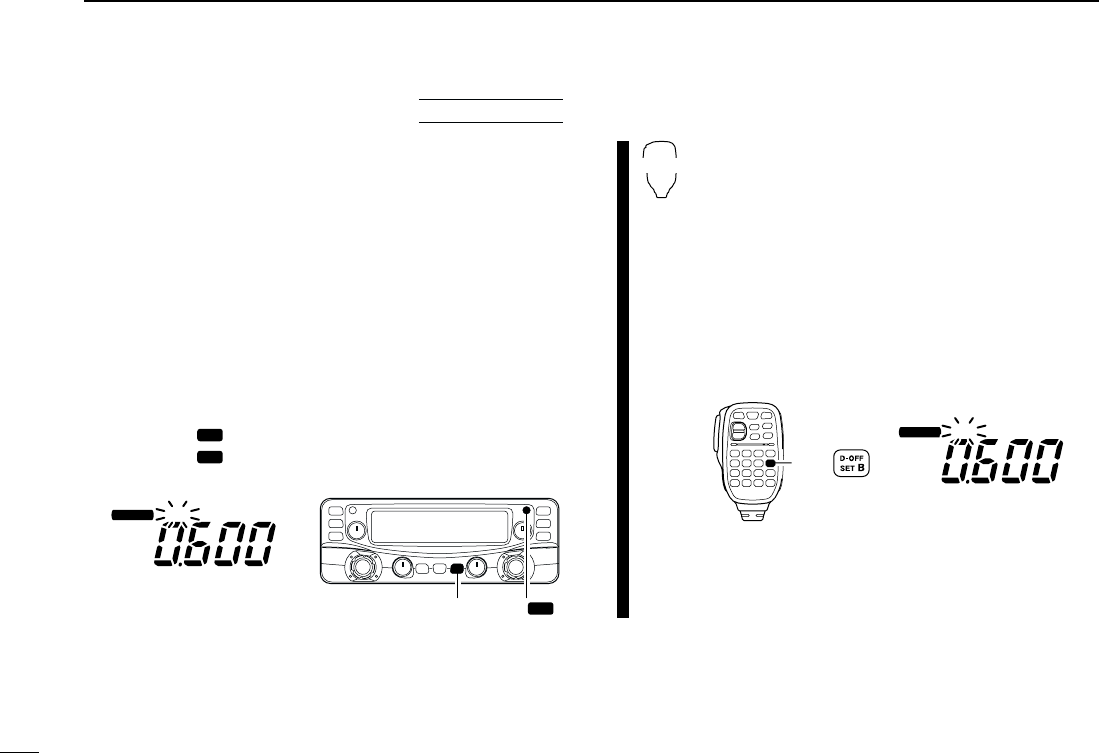
27
4REPEATER OPERATION
New2001
■Offset frequency
When communicating through a repeater, the transmit fre-
quency is shifted from the receive frequency by an amount
determined by the offset frequency.
Independent offset frequency can be set for each operating
frequency.
qPush [MAIN•BAND] to select the desired band (left or right)
as the main band.
•Push [MAIN•BAND] for 1 sec. then rotate the [DIAL] to select the
desired frequency band if necessary.
wSelect the desired mode/channel you wish to set the offset
frequency to, such as VFO mode or memory/call channel.
•The offset frequency can be independently programmed into
each mode or channel.
ePush [SET•] to enter set mode.
rPush [SET•] or [LOW•PRIO] until “DUP” and offset fre-
quency appear.
t
Rotate the main band’s [DIAL] to set the desired offset fre-
quency.
yPush [TONE•DTMF] to exit set mode.
zPush [BAND] to select the desired band (left or
right) as the main band.
•Enter the desired frequency via the keypad if neces-
sary.
xSelect the desired mode/channel you wish to
set the offset frequency to, such as VFO mode
or memory/call channel.
•The offset frequency can be independently pro-
grammed into each mode or channel.
c
Push [
SET
B(D-OFF)] to enter set mode.
v
Push [
SET
B(D-OFF)] or [
ENT
C(T-OFF)] until
“DUP” and offset frequency appear.
bPush [Y] or [Z] to set the desired
offset.
•Direct frequency entry from the keypad is not possi-
ble.
nPush [
CLR
A(MW)] to exit set mode.
☞NOTE: The offset frequency can be set in a memory/call
channel temporarily. However, the set frequency is cleared
once another memory channel or VFO mode is selected.
To store the offset frequency permanently, overwrite the
channel information.
MAIN
T X
DUP
M
Push
SET
B
MAIN
T X
DUP
M
[SET• ] [LOW•PRIO]
“DUP” and offset frequency appear
USING
SET MODE
IC-2720H.qxd 02.9.9 8:12 Page 27 (1,1)
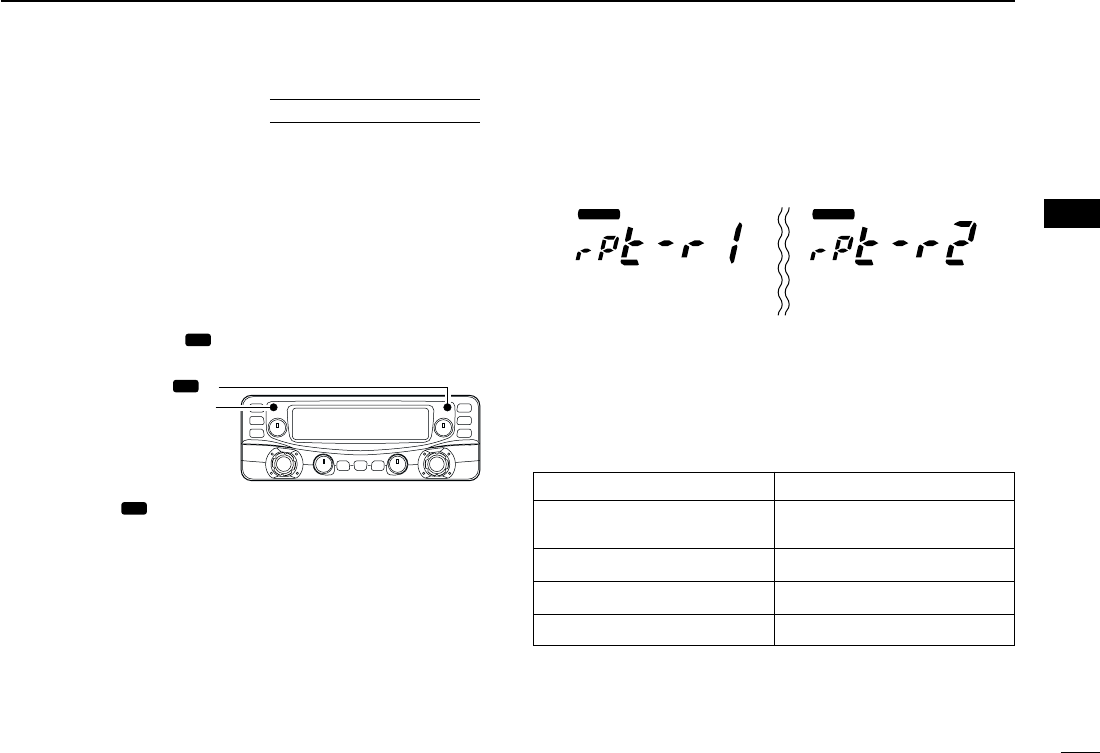
28
4
REPEATER OPERATION
New2001
4
■Auto repeater
(U.S.A. version only)
The USA version automatically activate the repeater settings
(DUP– or DUP+ and tone encoder ON/OFF) when the operating
frequency falls within the general repeater output frequency
range and deactivate them when outside of the range.
DSetting the auto repeater function ON/OFF
qPush [PWR] to turn power OFF.
w
While pushing [SET•], turn power ON to enter initial set
mode.
ePush [SET•] or [LOW•PRIO] several times until the
“rPt” display appears as shown above right.
rRotate left band’s [DIAL] to select the auto repeater func-
tion from “r1,” “r2” or OFF.
•“r1”: auto repeater is ON, tone encoder is OFF.
•“r2”: auto repeater is ON, tone encoder is ON.
tPush [PWR] to exit initial set mode.
DFrequency range and offset direction
MAIN
T X
DUP
M
MAIN
T X
DUP T
M
Auto DUP set: ON
Auto tone set: OFF
Auto DUP set: ON
Auto tone set: ON
While pushing [SET• ]
push [PWR] to enter initial
set mode
USING
INITIAL SET MODE
Frequency range Duplex direction
145.200–145.495 MHz “DUP–” appears
146.610–146.995 MHz
147.000–147.395 MHz “DUP” appears
442.000–444.995 MHz “DUP” appears
447.000–449.995 MHz “DUP–” appears
IC-2720H.qxd 02.9.9 8:12 Page 28 (1,1)
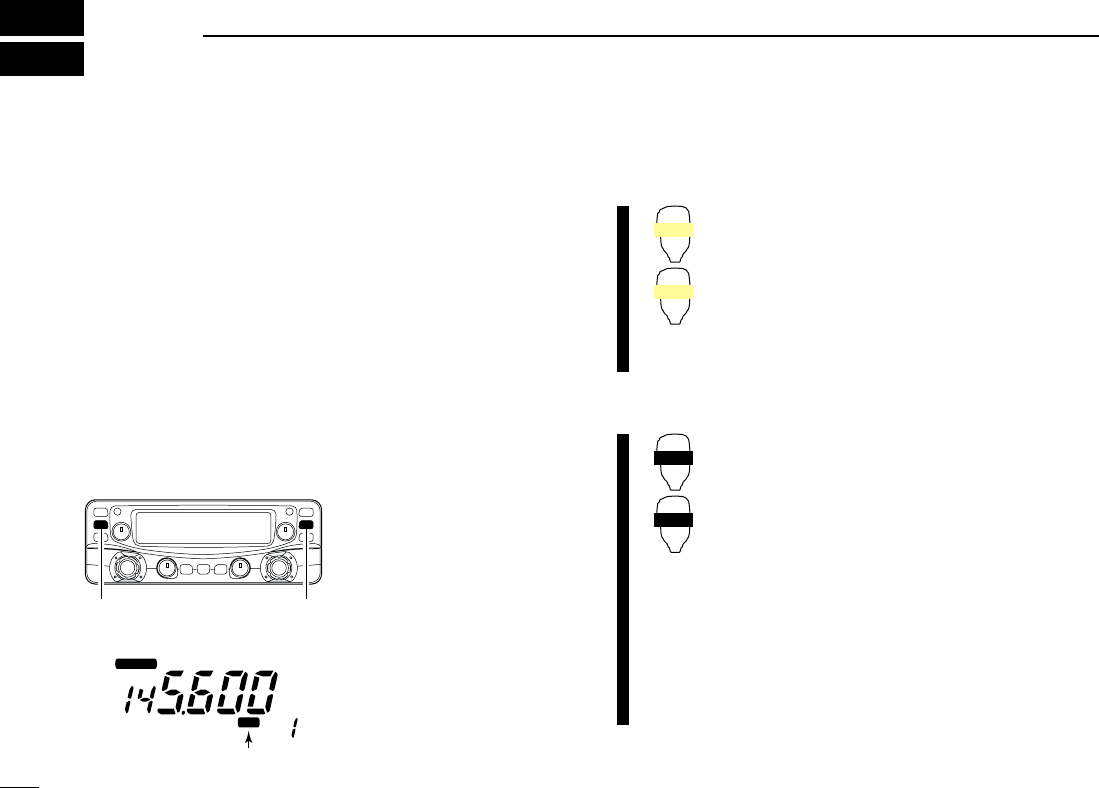
29
MEMORY OPERATION
New2001
5
■General description
The transceiver has 212 memory channels including 10 scan
edge memory channels (5 pairs), and 2 call channels. Each of
these channels can be individually programmed with operating
frequency (pgs. 11–13), duplex direction (p. 23) and offset
(p. 27), subaudible tone encoder or tone squelch and its tone
frequency (pgs. 23, 25, 52, 53) and skip information* (p. 44).
In addition, a total of 10 memory banks, A to J, are available
for usage by group, etc.
*except for scan edge memory channels.
■Memory channel selection
DUsing the tuning dial
qPush the desired band’s
[M/CALL(MW)] several
times to select memory
mode.
•“M” indicator appears
w
Rotate the same band’s
[DIAL] to select the de-
sired memory channel.
•Programmed memory
channels only can be se-
lected.
DUsing the [Y]/[Z] keys
zPush [BAND] to select the desired band as
the main band.
xPush [MR/CALL] to select memory mode.
cPush [Y] or [Z] to select and set the desired
memory channel.
•Pushing [Y]/[Z] for 1 sec. activates a scan.
•
If scan is activated, push [Y]/[Z] again or push
[
CLR
A(MW)] to stop it.
DUsing the keypad
zPush [BAND] to select the desired band as
the main band.
xPush [MR/CALL] to select memory mode.
cPush [
ENT
C(T-OFF)] to activate the keypad
for numeral input.
vPush 3 appropriate digit keys to input a chan-
nel number.
•Blank channel can be selected.
•Push only 1 appropriate digit key, [
MONI
1(BANK)],
[
SCAN
2(T-SCAN)], [
PRIO
3(PTT-M)],
[
HIGH
4(DTCS)] or [
MID
5(DTCSS)] then push
[MM(TONE-1)] or [
SQL
Z#(16KEY-L)] to select scan
edge channels. “MM” and “#” can be used for “A”
and “b” respectively.
MR/CALL
Y/Z
MR/CALL
Y/Z
MAIN
T X
M
Push [M/CALL•MW] to select
memory mode.
“M” appears
IC-2720H.qxd 02.9.9 8:12 Page 29 (1,1)
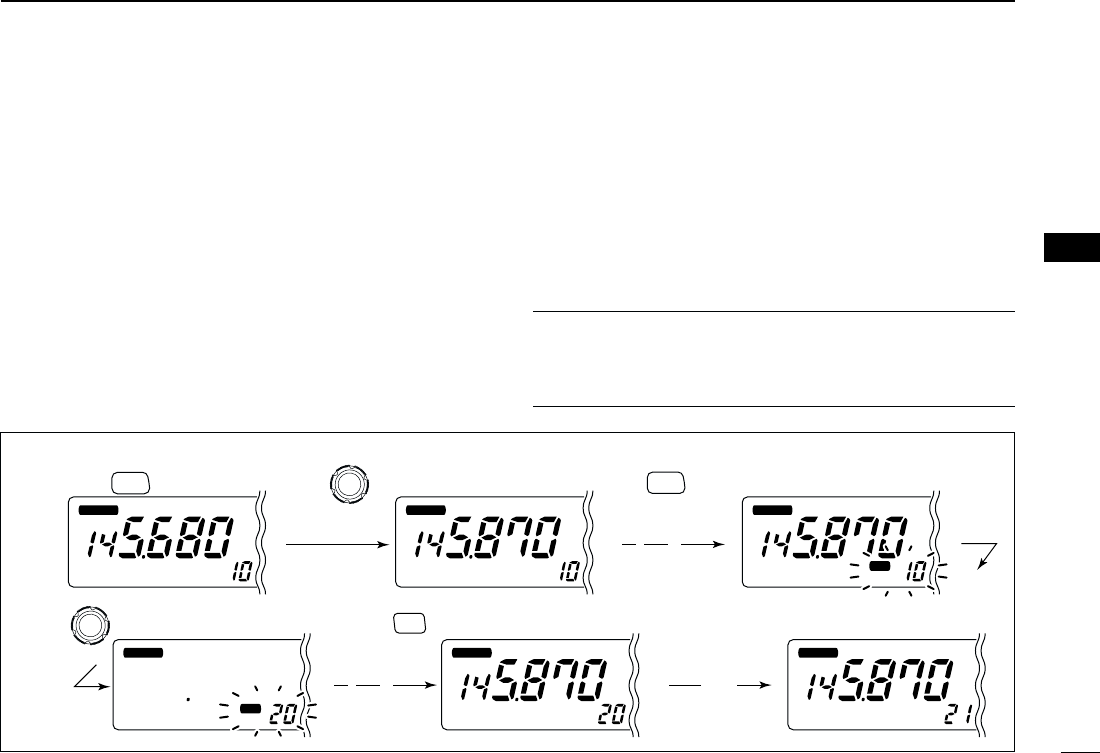
30
5
MEMORY OPERATION
New2001
5
■Programming a memory channel
[EXAMPLE]: Programming 145.870 MHz into memory channel 20 (blank channel) via the controller.
MAIN
T X
M
MAIN
T X
M
MAIN
T X
M
MAIN
T X
M
MAIN
T X
M
MAIN
T X
M
Push Rotate for setting frequency, etc. Push for 1 sec.
Rotate Push for 1 sec. and continue to push
➠
S.MW
MW
Beep
“
Beep
Beep
Beep
“
“
“
“
“
Beep
Beep
Beep
“
“
“
“
“
SCAN
V/MHz
MW
M/CALL
VFO settings, including the set mode contents such as sub-
audible tone frequency, offset, can be programmed into a
memory channel.
qSet the desired frequency in the desired band (left or right).
➥Push the desired band’s [V/MHz•SCAN] to select VFO
mode.
➥Set the frequency using the same band’s [DIAL].
➥Set other data (e.g. tone frequency, duplex information,
etc.) if required.
wPush the same band’s [M/CALL•MW] for 1 sec.
•3 beeps sound
•“M” indicator and the memory channel number blink.
eRotate the [DIAL] to select the memory channel to be pro-
grammed.
•Memory channels not yet programmed are blank.
rPush the [M/CALL•MW] for 1 sec. to program.
•3 beeps sound
•Memory channel number automatically increases when contin-
uing to push [M/CALL•MW] after programming.
✔CONVENIENT
Memory programming can be performed in versatile ways
e.g. memory channel to the same (or different) memory chan-
nel, memory channel to the call channel, etc.
IC-2720H.qxd 02.9.9 8:12 Page 30 (1,1)
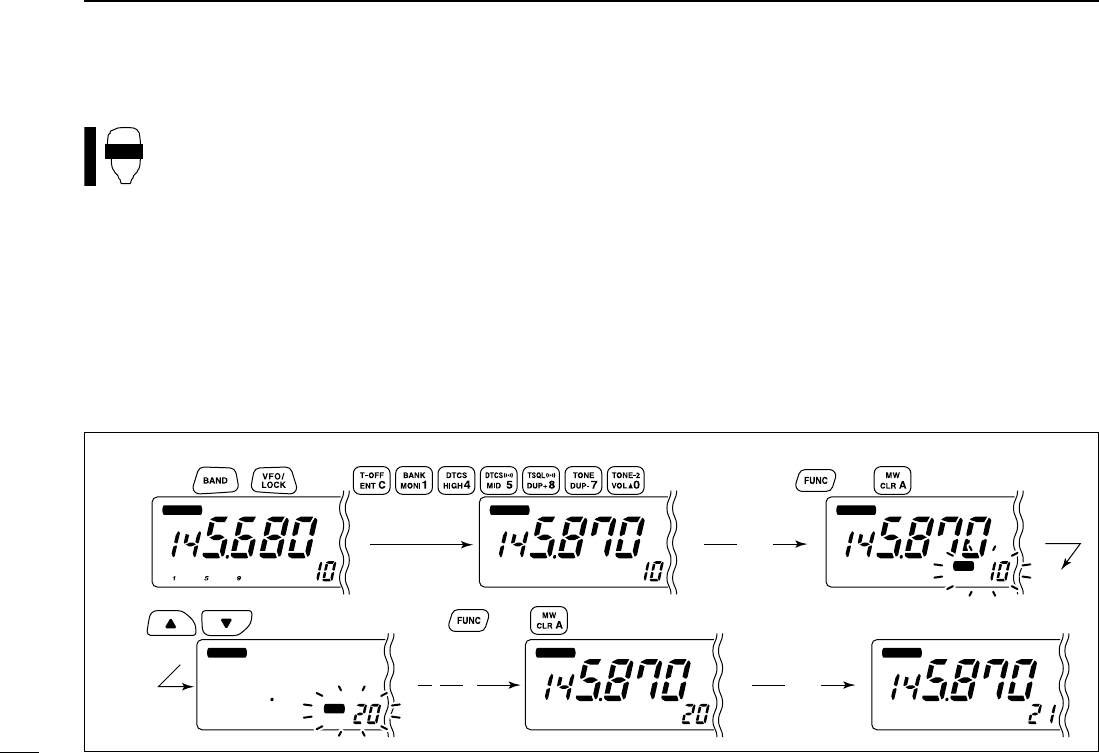
31
5MEMORY OPERATION
New2001
DProgramming a memory channel via the microphone
[EXAMPLE]: Programming 145.870 MHz into memory channel 20 (blank channel) via the microphone.
MAIN
T X
M
MAIN
T X
M
MAIN
T X
M
MAIN
T X
M
MAIN
T X
M
MAIN
T X
M
Push
Beep
“
Beep
“
Beep
Beep
Beep
“
“
“
“
“
Push , Push then
Push then for 1 sec. and continue to push
➠
The microphone can also be used to program mem-
ory channels.
zSet the desired frequency in VFO mode.
➥Push [VFO/LOCK] to select VFO mode.
➥Set the frequency using the keypad.
➥Set other data (e.g. offset frequency, duplex direction, sub-
audible tone encoder ON/OFF and its frequency), if neces-
sary.
xPush [FUNC] then [
CLR
A(MW)] momentarily.
cPush [Y] or [Z] to select the memory channel.
•Direct numeral input cannot be used.
vPush [FUNC] then [
CLR
A(MW)] for 1 sec. to program.
➥3 beeps may sound and the VFO contents (including
the subaudible tone frequency, etc.) are programmed.
➥Memory channel number increases when continuing to
push [
CLR
A(MW)] after programming.
MW
IC-2720H.qxd 02.9.9 8:12 Page 31 (1,1)
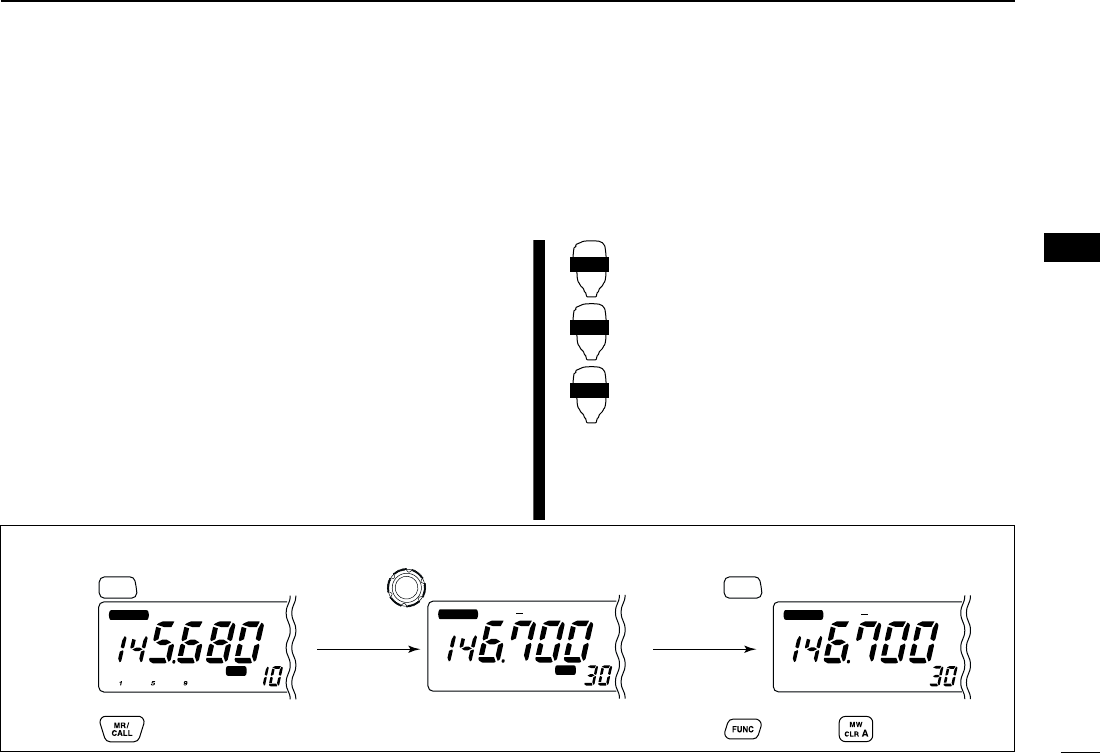
32
5
MEMORY OPERATION
New2001
5
■
Transferring memory contents
This function transfers a memory channel’s contents to VFO
(or another memory/call channel). This is useful when search-
ing for signals around a memory channel frequency and for
recalling the offset frequency, subaudible tone frequency etc.
DMemory/call➪VFO
qSelect the desired band’s (left or right) memory or call
channel.
➥Push the desired band’s [M/CALL•MW] several times to
select memory mode or call channel, then rotate the
same band’s [DIAL] to select the desired memory or call
channel.
wPush [M/CALL•MW] for 1 sec. to transfer the selected
memory/call channel contents to the VFO.
•VFO mode is selected automatically.
zPush [BAND] to select the desired band as
the main band, if necessary.
xSelect the memory/call channel to be
transferred.
➥Push [MR/CALL] to select memory mode,
then select the desired memory channel
via [Y]/[Z] or keypad.
➥Push [MR/CALL] for 1 sec. then push
[Y]/[Z] to select the call channel.
cPush [FUNC], then [
CLR
A(MW)] for 1 sec. to
transfer the selected memory/call channel
contents to the VFO.
•VFO mode is selected automatically.
MR/CALL
MW
[Y]/[Z]
[EXAMPLE]: Transferring memory channel 30 contents to VFO.
MAIN
T X
M
MAIN
T X
DUP T
M
MAIN
T X
DUP T
M
Push to select memory mode.
Front panel operation:
HM-133 operation:
Push to select memory mode.
Rotate for selecting memory channel.
Select memory channel.
Push for 1 sec.
Push then push for 1 sec.
MW
M/CALL
MW
M/CALL
IC-2720H.qxd 02.9.9 8:12 Page 32 (1,1)
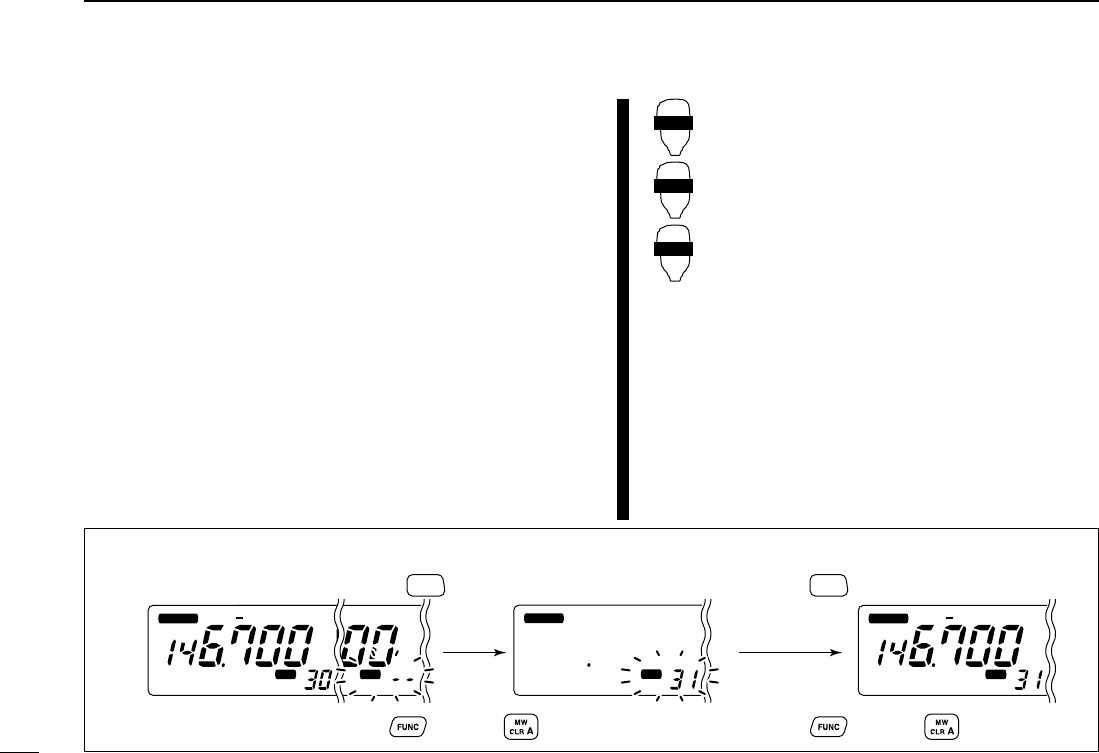
5MEMORY OPERATION
33
New2001
DMemory/call➪call/memory
qSelect the memory/call channel to be transferred.
➥Push the desired band’s [M/CALL•MW] several times to
select memory mode or call channel, then rotate the
same band’s [DIAL] to select the desired memory or call
channel.
wPush the same band’s [M/CALL•MW] for 1 sec.
•“M” indicator and “– –” indication blink, and shows VFO condi-
tions.
eRotate the [DIAL] to select the target memory channel.
•“C1” or “C2” blinks when the call channel is selected.
•Scan edge channels, 1A/1b, 2A/2b, 3A/3b, 4A/4B, 5A/5b can
also be selected.
rPush the [M/CALL•MW] for 1 sec. to transfer the selected
memory/call channel contents to the target memory.
•The targeted memory and transferred contents are indicated.
zSelect the memory/call channel to be trans-
ferred.
➥Push [MR/CALL] to select memory mode,
then select the desired memory channel
via [Y]/[Z] or keypad.
➥Push [MR/CALL] for 1 sec. then push
[Y]/[Z] to select the desired call channel.
xPush [FUNC], then [
CLR
A(MW)] momentarily.
•“M” indicator and “– –” indication blink, and shows
VFO conditions.
cPush [Y]/[Z] to select the target memory
channel.
•
“C1” or “C2” blinks when the call channel is selected.
•Scan edge channels can also be selected.
•The keypad cannot be used for the selection.
vPush [FUNC] then push [
CLR
A(MW)] for
1 sec. to transfer the selected memory/call
channel contents to the target memory.
•The targeted memory and transferred contents
are indicated.
MR/CALL
MW
[Y]/[Z]
[EXAMPLE]: Transferring memory channel 30 contents to channel 31.
MAIN
T X
DUP T
M
MAIN
T X
M
MAIN
T X
DUP T
M
MAIN
T X
DUP T
M
Select the target channel. Push for 1 sec.
Push then push for 1 sec.
Select the memory channel, then push for 1sec.
Select the memory channel, push then push .
Front panel operation:
HM-133 operation:
MW
M/CALL
MW
M/CALL
IC-2720H.qxd 02.9.9 8:12 Page 33 (1,1)
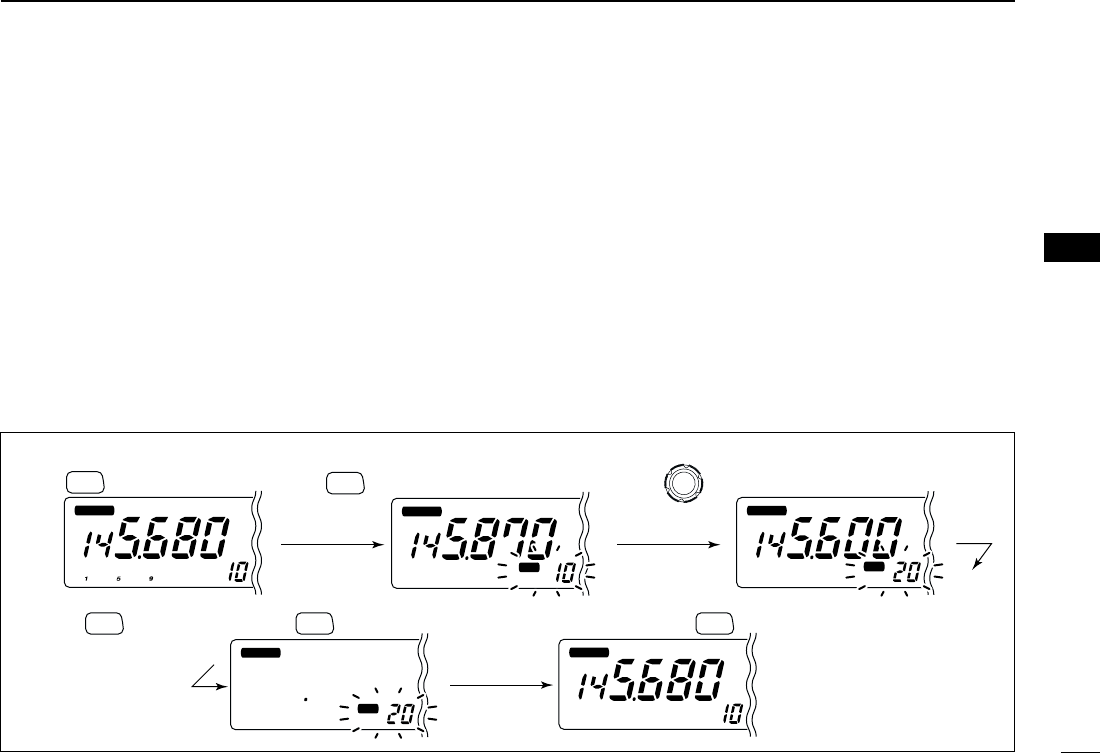
5
MEMORY OPERATION
34
New2001
5
■Memory clearing
Contents of programmed memories can be cleared (blanked),
if desired.
qPush [V/MHz•SCAN] to select VFO mode in the desired
band (left or right).
wPush the same band’s [M/CALL•MW] for 1 sec.
•“M” indicator and the memory channel number blink.
eRotate the same band’s [DIAL] to select the memory chan-
nel to be cleared.
•Memory channels not yet programmed are blank.
rPush the same band’s [M/CALL•MW] momentarily, then
push the [M/CALL•MW] again for 1 sec.
☞This operation must be performed within 1.5 sec.
•3 beeps sound, then the frequency is cleared.
•“M” indicator and the channel number blink continuously.
•When clearing the call channel, the current VFO conditions are
re-programmed into the call channel automatically.
tPush the same band’s [MAIN•BAND] or [V/MHz•SCAN], to
return to VFO mode.
☞NOTE: Be careful!— the contents of cleared memories
CANNOT be recalled.
[EXAMPLE]: Clearing memory channel 20.
MAIN
T X
M
MAIN
T X
M
MAIN
T X
M
MAIN
T X
M
MAIN
T X
M
Push to select VFO. Rotate for selecting memory channel.Push for 1 sec.
Push any switch, except .Push momentarily, then push again for 1 sec.
Beep
Beep
Beep
“
“
“
“
“
MW
M/CALL
MW
M/CALL
MW
M/CALL
MW
M/CALL
SCAN
V/MHz
IC-2720H.qxd 02.9.9 8:12 Page 34 (1,1)
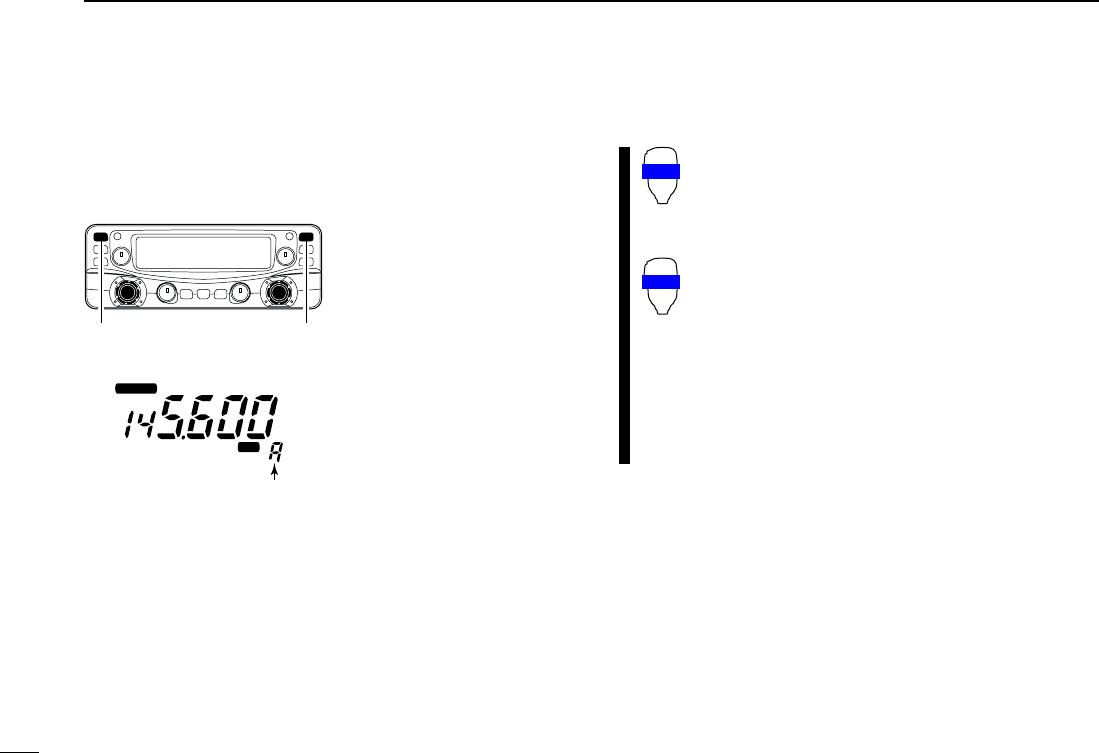
35
New2001
5MEMORY OPERATION
■Memory bank selection
The IC-2720H has a total of 10 banks (A to J). Regular mem-
ory channels, 000 to 199, are assigned into the desired bank
for easy memory management.
qPush the desired band’s
[M/CALL•MW] several
times to select memory
mode, if desired.
wPush the same band’s
[MAIN•BAND] for 1 sec.
to select memory bank
condition.
•Bank initial blinks
eRotate the same band’s
[DIAL] to select the de-
sired bank, A to J.
•Banks that have no pro-
grammed contents are
skipped.
rPush the [MAIN•BAND] to set the bank.
•Initial stops blinking.
tRotate the [DIAL] to select the contents in the bank.
•No channel numbers are displayed for memory bank operation.
yTo return to regular memory
condition, push the
[MAIN•BAND] for 1 sec. then push the [MAIN•BAND] mo-
mentarily again.
zPush [MR/CALL] to select memory mode, if de-
sired.
xPush [FUNC] then [
MONI
1(BANK)] to select
memory bank condition.
•Bank initial blinks
cPush [Y]/[Z] to select the desired bank, A to J.
•Only programmed memory bank can be selected.
vPush [
CLR
A(MW)] to set the bank.
•Initial stops blinking.
bPush [Y]/[Z] to select the desired contents in
the bank.
•No channel numbers are displayed for memory
bank operation.
n
To return to regular memory condition, push
[FUNC], [
MONI
1(BANK)] then push [
CLR
A(MW)].
BANK
[Y]/[Z]
MAIN
T X
M
Push [MAIN•BAND] for 1 sec.
to select memory bank.
Bank initial appears
IC-2720H.qxd 02.9.9 8:12 Page 35 (1,1)
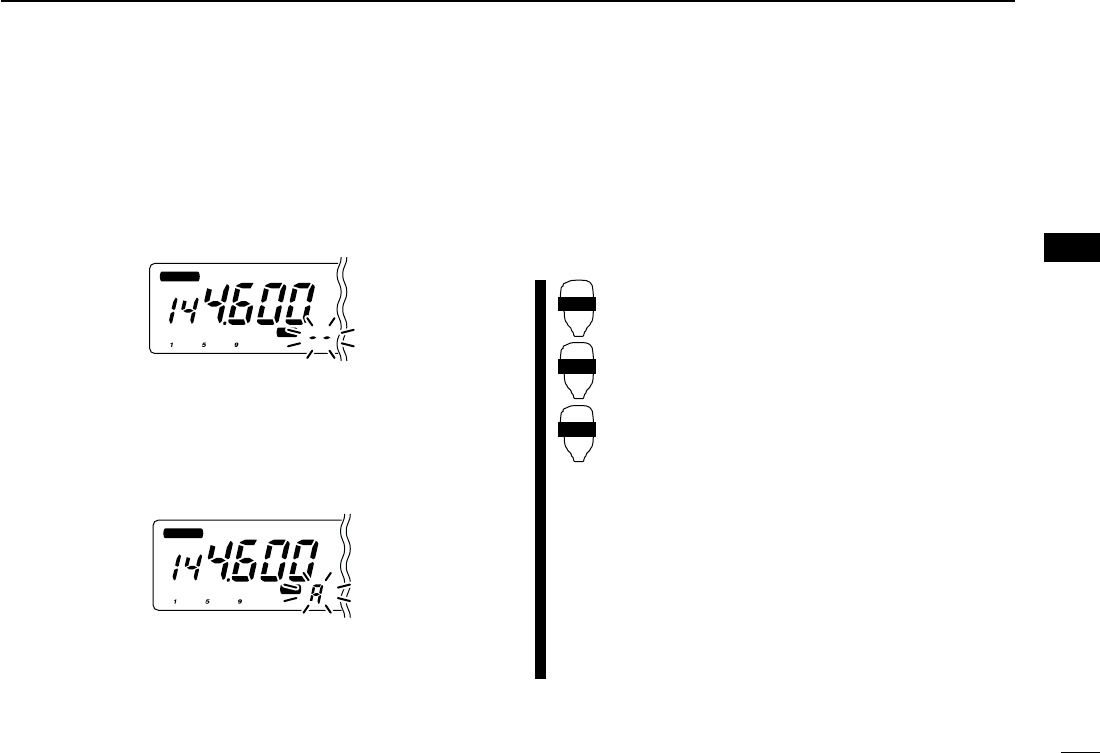
36
5
MEMORY OPERATION
New2001
5
■Memory bank setting
qPush the desired band’s [M/CALL•MW] several times to
select memory mode, then select the desired memory
channel via the same band’s [DIAL].
wPush the same band’s [MAIN•BAND] for 1 sec.
•“– –” indication blinks as follows.
ePush the [MAIN•BAND] again to set the channel to bank
setting stand-by condition.
•“– –” indication blinking stops.
rPush the [M/CALL•MW] for 1 sec. then rotate the [DIAL] to
select the desired bank to be set.
•Bank initial blinks as follows.
tPush the [M/CALL•MW] again to set the channel into the
bank.
•“M” and bank initial blinking stops.
yPush the [MAIN•BAND] for 1 sec. then push the
[MAIN•BAND] momentarily again to return to regular mem-
ory condition.
uRepeat steps qto yto set another memory channel into
the same or another bank.
zPush [MR/CALL] then select the desired mem-
ory channel via [Y]/[Z] or keypad.
•Push [BAND] to select the desired band (left or
right) as the main band, in advance.
xPush [FUNC] then [
MONI
1(BANK)].
•“– –” indication blinks.
cPush [
CLR
A(MW)] to set the channel to bank
setting stand-by condition.
•“– –” indication stops blinking.
vPush [FUNC] then [
CLR
A(MW)] then push
[Y]/[Z] to select the desired bank to be set.
•Bank initial blinks.
bPush [
CLR
A(MW)] to set the channel into the
bank.
•“M” and bank initial stops blinking.
n
Push [FUNC], [
MONI
1(BANK)] then [
CLR
A(MW)]
to return to regular memory channel condition.
mRepeat steps zto nto set an another memory
channel into the same or another bank.
BANK
[Y]/[Z]
MW
MAIN
T X
M
MAIN
T X
M
IC-2720H.qxd 02.9.9 8:12 Page 36 (1,1)
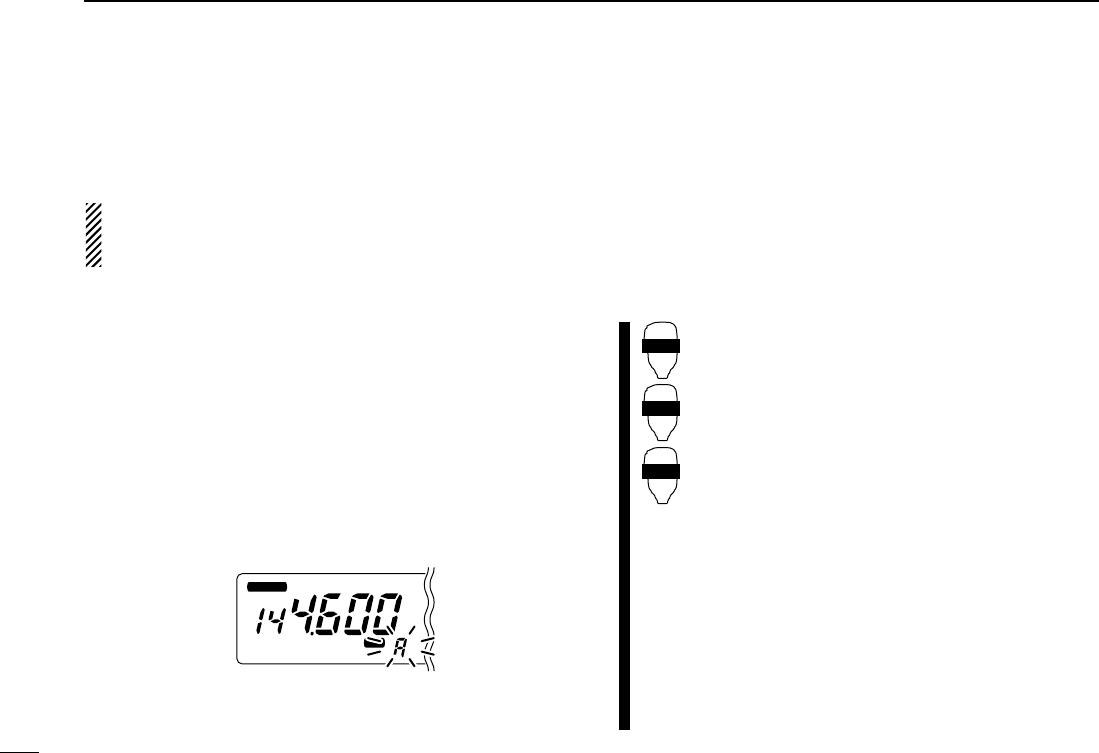
37
5MEMORY OPERATION
New2001
■Transferring bank contents
Contents of programmed memory banks can be cleared or
transferred to another bank.
INFORMATION: Even if the memory bank contents are
cleared, the memory channel contents still remain pro-
grammed.
qSelect the desired bank contents to be transferred or
erased in the desired band (left or right).
➥Push the desired band’s [M/CALL•MW] several times to
select memory mode.
➥Push the same band’s [MAIN•BAND] for 1 sec. then ro-
tate the same band’s [DIAL] to select the desired mem-
ory bank.
•Bank initial blinks.
➥Push the [MAIN•BAND] to select the bank then rotate
the [DIAL] to select the desired contents.
•Bank initial stops blinking.
wPush the [M/CALL•MW] for 1 sec.
•Bank initial blinks.
eRotate the [DIAL] to select the desired bank initial to trans-
fer or erase.
•Select “– –” indication when erasing the contents from the bank.
rPush the [M/CALL•MW] again.
•Bank initial or “– –” indication stops blinking.
tPush the [MAIN•BAND] for 1 sec. then push the
[MAIN•BAND] momentarily again to return to regular mem-
ory condition.
yRepeat steps qto tfor transferring or erasing an an-
other banks contents.
zSelect the desired bank contents in the main
band.
➥Push [MR/CALL] to select memory mode.
➥Push [FUNC], [
MONI
1(BANK)] then select
the desired memory bank via [Y]/[Z].
➥Push [
CLR
A(MW)] to select the bank then
select the desired contents via [Y]/[Z].
xPush [FUNC] then [
CLR
A(MW)].
•Bank initial blinks.
cPush [Y]/[Z] to select the desired bank initial to
transfer or erase.
•Select “– –” indication when erasing the contents
from the bank.
vPush [
CLR
A(MW)].
•Bank initial or “– –” indication stops blinking.
b
Push [FUNC], [
MONI
1(BANK)] then [
CLR
A(MW)]
to return to regular memory condition.
nRepeat steps zto bfor transferring or eras-
ing an another banks contents.
BANK
[Y]/[Z]
MW
MAIN
T X
M
IC-2720H.qxd 02.9.9 8:12 Page 37 (1,1)
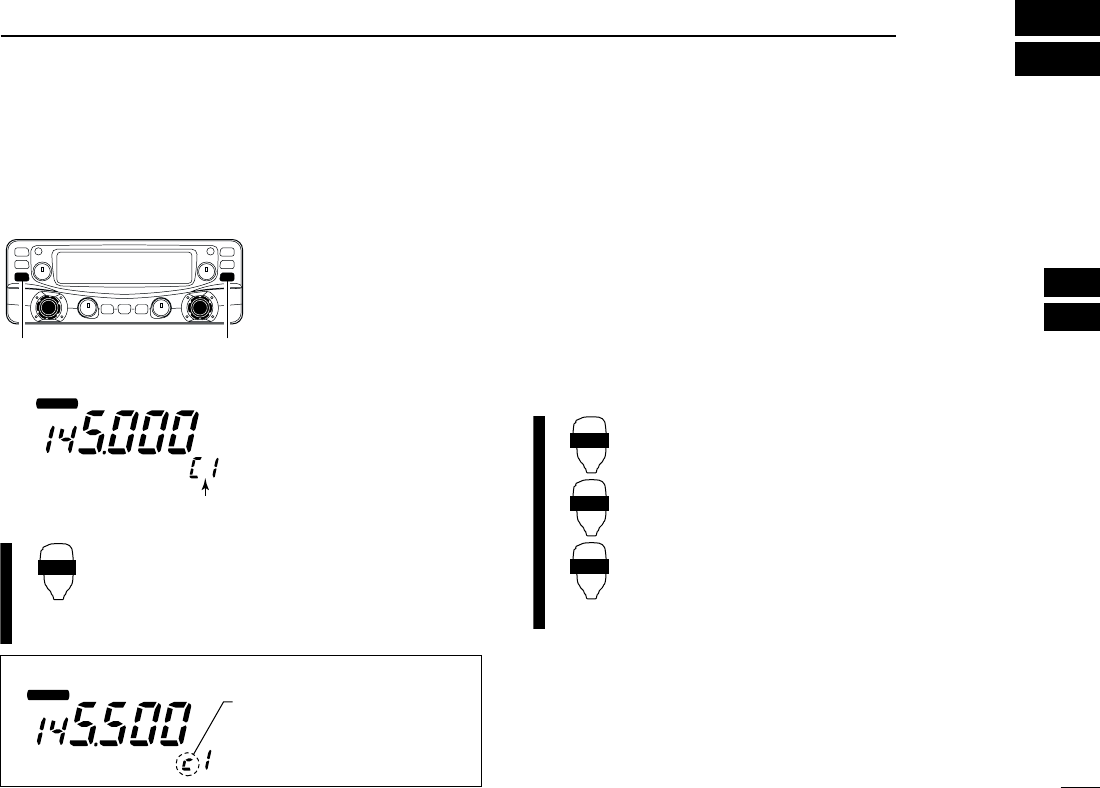
38
6
CALL CHANNEL OPERATION
5
6
■Call channel selection
Call channel is pre-programmed memory channel that can be
accessed by simply pushing call channel button.
➥Push [M/CALL•MW] sev-
eral times to select the
call channel mode then
rotate the same band’s
[DIAL] to select the de-
sired call channel.
•“C1” or “C2” appears in-
stead of memory channel
number indication.
•
Push the [M/CALL•MW] sev-
eral times to select memory
mode, or push the same
band’s [V/MHz•SCAN] to se-
lect VFO mode.
➥Push [MR/CALL] for 1 sec. to select the call
channel mode then push [Y]/[Z] to select the
desired call channel in the main band.
•Push [MR/CALL] to select memory mode, or push
[VFO/LOCK] to select VFO mode.
■Call channel transferring
qPush the desired band’s [M/CALL•MW] several times then
rotate the same band’s [DIAL] to select the desired call
channel.
•“C1” or “C2” appears.
wPush the [M/CALL•MW] for 1 sec., then rotate the [DIAL] to
select the memory channel to transfer the contents to.
•“M” indicator and memory channel number blink.
•To transfer to the VFO, select “– –” with the [DIAL] then push the
[M/CALL•MW] for 1 sec.
ePush the [M/CALL•MW] for 1 sec. to transfer the contents.
zPush [MR/CALL] for 1 sec. then push [Y]/[Z]
to select the desired call channel in the main
band.
xPush [FUNC], [
CLR
A(MW)] momentarily, then
push [Y]/[Z] to select the memory channel to
transfer the contents to.
•To transfer to the VFO, push [Y]/[Z] to select
“– –” then push [FUNC], [
CLR
A(MW)] for 1 sec.
cPush [FUNC], then [
CLR
A(MW)] for 1 sec. to
transfer the contents.
MR/CALL
MW
[Y]/[Z]
MR/CALL
MAIN
T X
M
Push [M/CALL•MW] several times
to select call channel.
“C1” or “C2” appears
✔INFORMATION
MAIN
T X
M
When the VFO mode is
selected from the call channel,
a small “c” appears instead of
memory channel number.
IC-2720H.qxd 02.9.9 8:12 Page 38 (1,1)
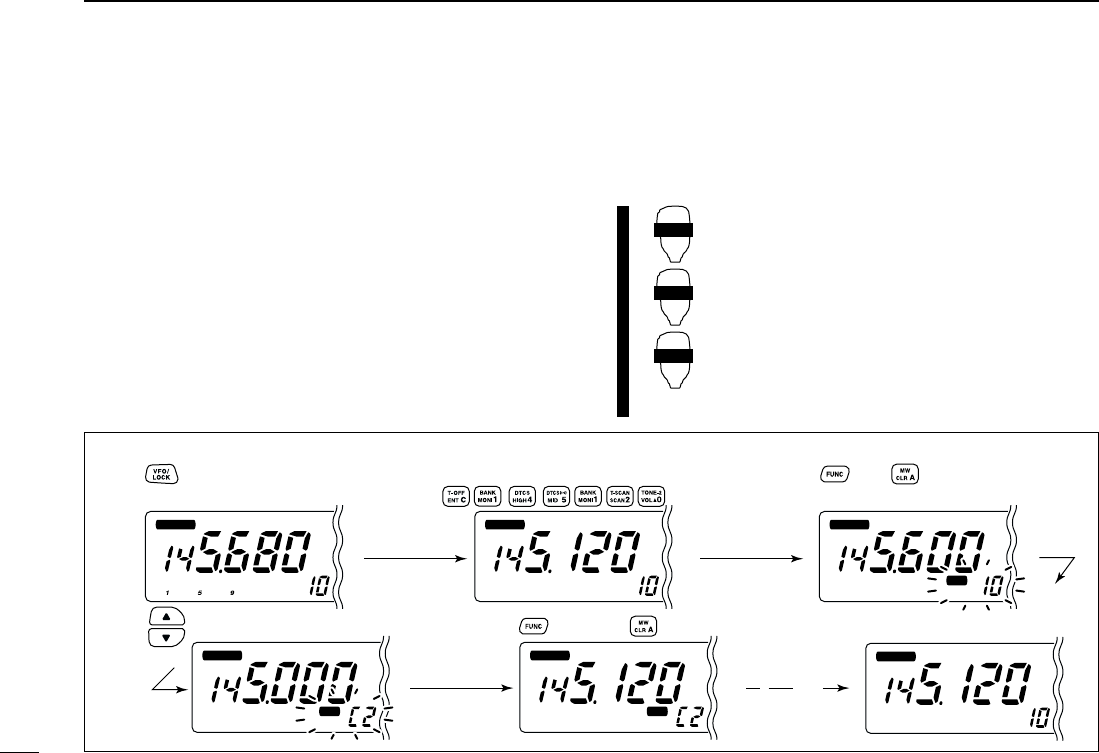
39
6CALL CHANNEL OPERATION
New2001
■Programming a call channel
Operating frequency, duplex information, subaudible tone in-
formation (tone encoder or tone squelch ON/OFF and its fre-
quency) and alphanumeric channel names can also be
programmed into the call channel.
qSet the desired frequency in VFO mode.
➥Push the desired band’s [V/MHz•SCAN] to select VFO
mode.
➥Set the frequency using the same band’s [DIAL].
➥Set other data as desired.
wPush the same band’s [M/CALL•MW] for 1 sec.
eRotate the [DIAL] to select the desired call channel.
•“M” indicator and “C1” or “C2” blink.
rPush the [M/CALL•MW] for 1 sec. to program.
•3 beeps sound and the unit returns to VFO mode automatically.
zSet the desired frequency in VFO mode.
➥Push [VFO/LOCK] to select VFO mode.
➥Set the frequency.
➥Set other data as desired.
x
Push [FUNC], then [
CLR
A(MW)] momentarily.
cSelect the call channel via [Y] or [Z] .
vPush [FUNC] then [
CLR
A(MW)] for 1 sec. to
program.
•3 beeps sound and the unit returns to VFO mode
automatically.
MR/CALL
MW
[Y]/[Z]
[EXAMPLE]: Programming 145.120 MHz into the call channel 2 via the microphone.
MAIN
T X
M
MAIN
T X
M
MAIN
T X
M
MAIN
T X
M
MAIN
T X
M
MAIN
T X
M
Set the frequency.
Push to select VFO mode. Push , then .
Push , then push for 1 sec.
➠
Push until large “C” appears.
Beep
Beep
Beep
“
“
“
“
“
IC-2720H.qxd 02.9.9 8:12 Page 39 (1,1)
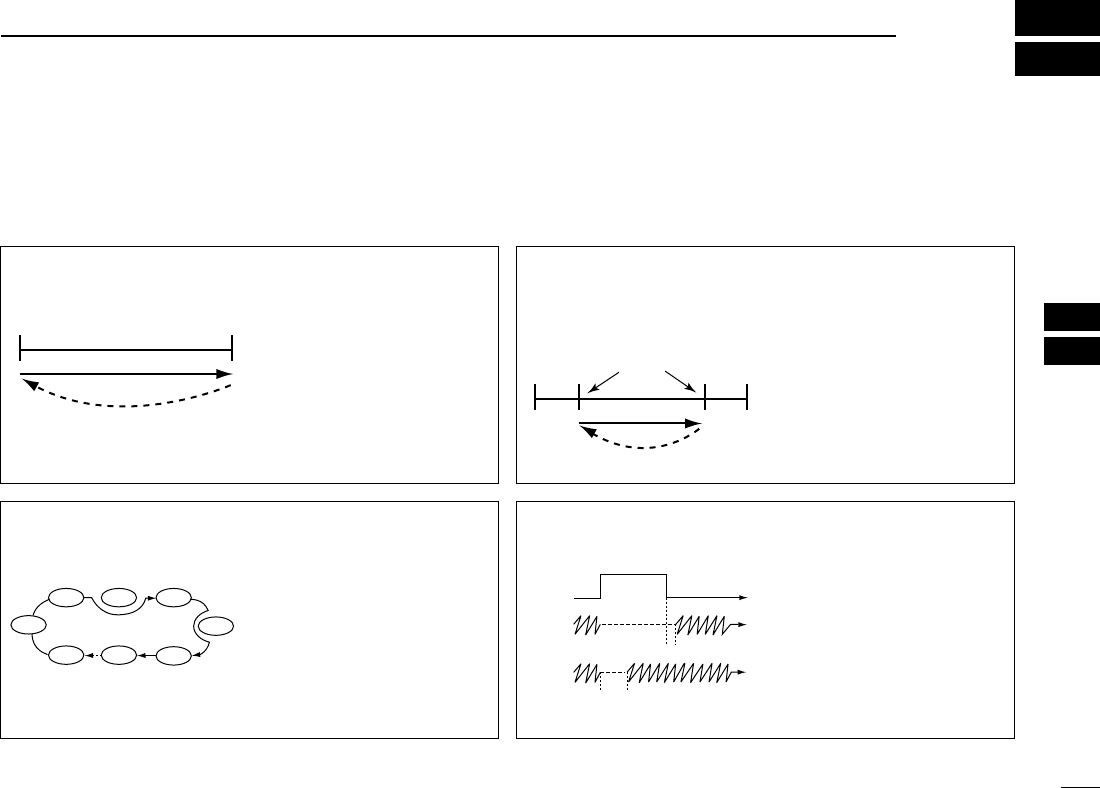
40
7
SCAN OPERATION
6
7
■Scan types
Scanning searches for signals automatically and makes it
easier to locate new stations for contact or listening purposes.
There are 3 scan types and 4 resume conditions to suit your
operating needs.
BAND SCAN (p. 41) Repeatedly scans all frequen-
cies over the entire band.
Used as the simplest scan
without any preliminary set-
tings necessary.
Band
edge
Band
edge
Scan
Jump
PROGRAMMED SCAN
(p. 41)
Repeatedly scans between
two user-programmed fre-
quencies. Used for checking
for frequencies within a speci-
fied range such as repeater
output frequencies, etc.
5 pairs of scan edges are
available and scans 1A–1b
(P1), 2A–2b (P2), 3A–3b (P3),
4A–4b (P4), 5A–5b (P5).
Band
edge
Band
edge
Scan edges
Scan
Jump
1A
2A
3A
4A
5A
1b
2b
3b
4b
5b
Start End
MEMORY SCAN (p. 41) Repeatedly scans memory
channels except those set as
skip channels. Used for often-
called channels and for by-
passing normally busy
channels such as repeater
frequencies.
SKIP
SKIP
M 0 M 4
M 1 M 2 M 3
M 5
M 199
M 6
SCAN RESUME
CONDITION (p. 45)
4 resume conditions are avail-
able: 3 timer scans and pause
scan. When receiving a sig-
nal, pause scan pauses until
the signal disappears; timer
scans pause for 5, 10 or
15 sec.
Pause
scan
Receiving
a signal
Timer
scan
Pausing
2 sec.
☞NOTE: A tone scan function is available to search for subaudible tones (e.g. when you want to find a subaudible tone fre-
quency necessary to open a repeater). See p. 55 for details.
IC-2720H.qxd 02.9.9 8:12 Page 40 (1,1)
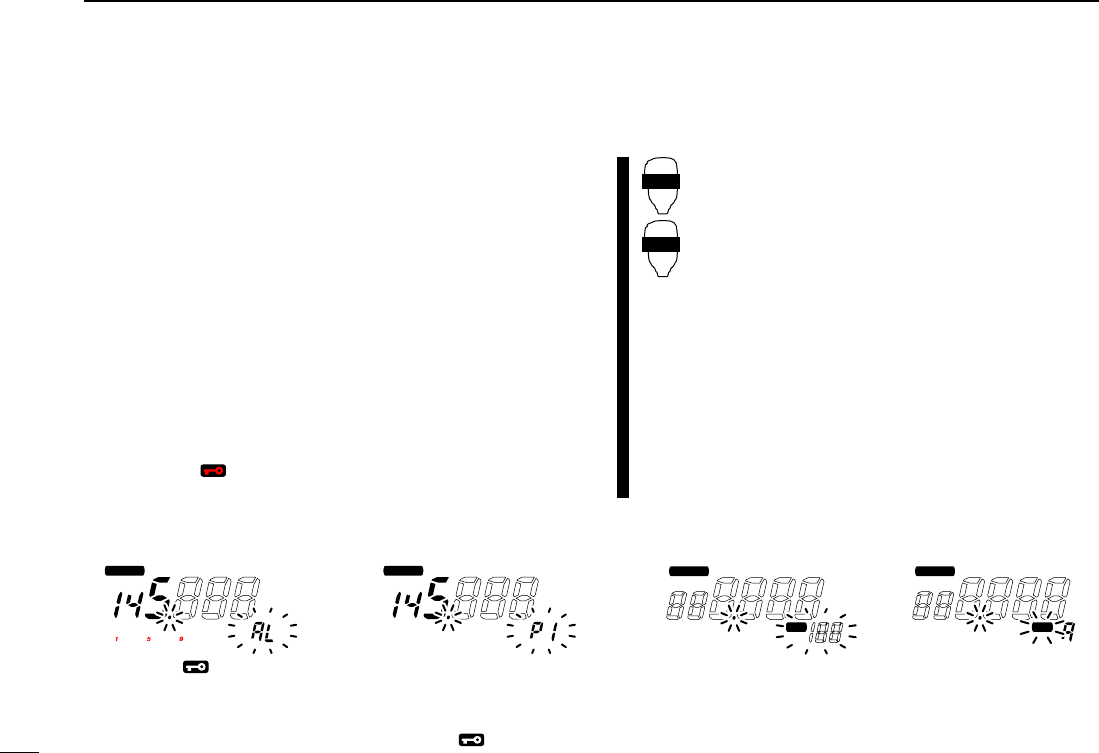
41
7SCAN OPERATION
New2001
■Scan start/stop
DPreparation
Scan resume condition (p. 41); program the scan edges
(pgs. 42, 43); program 2 or more memory channels (pgs. 30,
31); set skip settings, if desired (p. 44).
DOperation
qSelect VFO mode for full/programmed scan with
[V/MHz•SCAN]; or memory mode for memory scan with
[M/CALL•MW] in the desired band.
•Select the desired bank with the same band’s [MAIN•BAND] for
bank scan.
wSet the squelch to the point where noise is just muted.
ePush the [V/MHz•SCAN] for 1 sec. to start the scan.
•To change the scanning direction, rotate the same band’s [DIAL].
•The memory channel readout blinks the scan type as follows:
rPush
[SET•]
to switch full and programmed scan (P1,
P2, P3, P4 and P5), if VFO is selected in step q.
tTo stop the scan, push the [V/MHz•SCAN].
zPush [VFO/LOCK] to select VFO mode for
full/programmed scan; push [MR/CALL] to select
memory mode for memory scan, in the main
band.
•Push [FUNC] then [
MONI
1(BANK)] to select a bank
for bank scan.
xPush [
SQL
YD(MUTE)] or [
SQL
Z#(16KEY-L)] to
set the squelch to the point where noise is just
muted.
cPush [
SCAN
2(T-SCAN)] to start the scan.
•Push [Y] or [Z] for 1 sec. also starts the scan.
vPush [
SET
B(D-OFF)] to switch full and pro-
grammed scan (P1, P2, P3, P4 and P5), if VFO
is selected in step z.
bTo stop the scan push [
SCAN
2(T-SCAN)] or
[
CLR
A(MW)].
SCAN
2
SET
B
MAIN
T X
M
MAIN
T X
M
MAIN
T X
M
MAIN
T X
M
• During full scan • During programmed scan • During memory scan • During bank scan
Indicates scan edge channels.
• P1 stands for 1A/1b
• P1 to P5 are available when they
are programmed, and switches
with [SET• ].
Indicates bank initial.Push [SET• ] to select “AL”
(full) or programmed scan (P1,
P2, P3, P4 and P5) in
sequence.
IC-2720H.qxd 02.9.9 8:12 Page 41 (1,1)
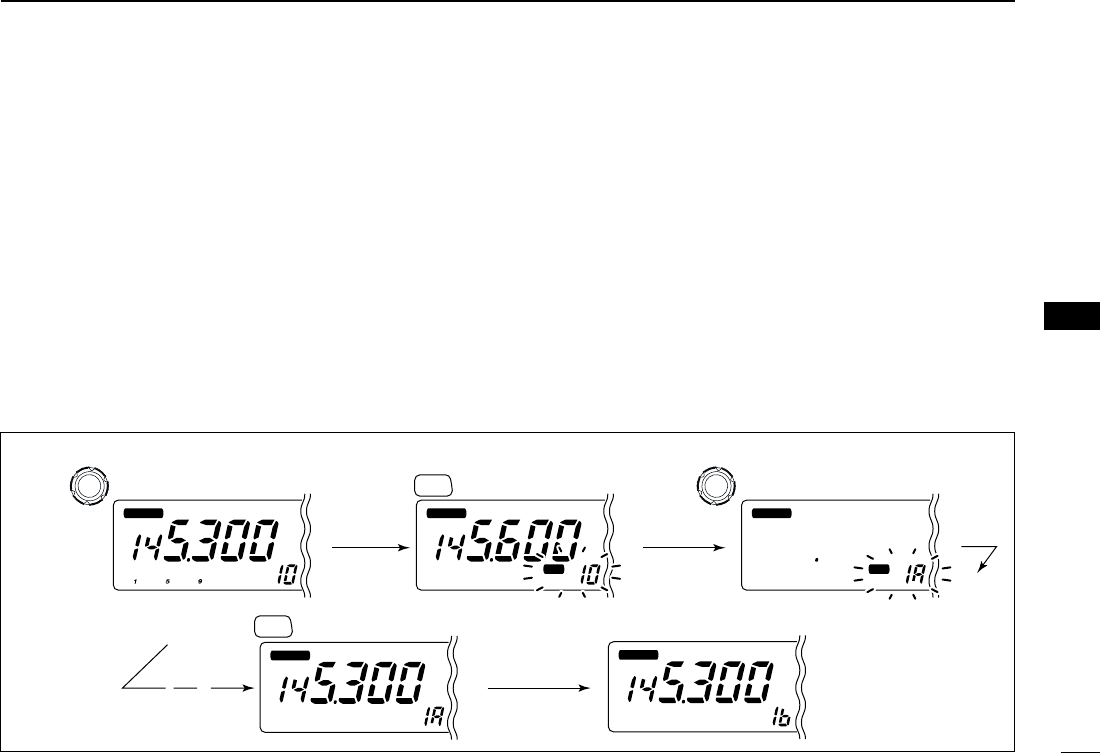
42
7
SCAN OPERATION
New2001
7
■Scan edges programming
Scan edges can be programmed in the same manner as
memory channels. Scan edges are programmed into scan
edges, 1A/1b to 5A/5b, in memory channels.
qSet the edge frequency of the desired frequency range in
VFO mode:
➥Set the frequency using the desired band’s [DIAL].
➥Set other data (e.g. repeater settings, etc.) if desired.
wPush the same band’s [M/CALL•MW] for 1 sec.
•“M” indicator and channel number blink.
eRotate the [DIAL] to select one of scan edge channel, 1A,
2A, 3A, 4A or 5A.
rPush the [M/CALL•MW] for 1 sec. to program.
•3 beeps sound and VFO is automatically selected.
•Scan edge 1b, 2b, 3b, 4b or 5b is automatically selected when
continuing to push the [M/CALL•MW] after programming.
tTo program a frequency for the other pair of scan edges,
1b, 2b, 3b, 4b or 5b, repeat steps qand r.
•If the same frequency is programmed into a pair of scan edges,
programmed scan will not function.
[EXAMPLE]: Programming 145.300 MHz into scan edges 1A.
MAIN
T X
M
MAIN
T X
M
MAIN
T X
M
MAIN
T X
M
MAIN
T X
M
Push for 1 sec.Rotate for setting frequency, etc. Rotate
Push for 1 sec. and continue to push
➠
Beep
Beep
Beep
“
Beep
“
“
“
“
“
MW
M/CALL
MW
M/CALL
IC-2720H.qxd 02.9.9 8:12 Page 42 (1,1)
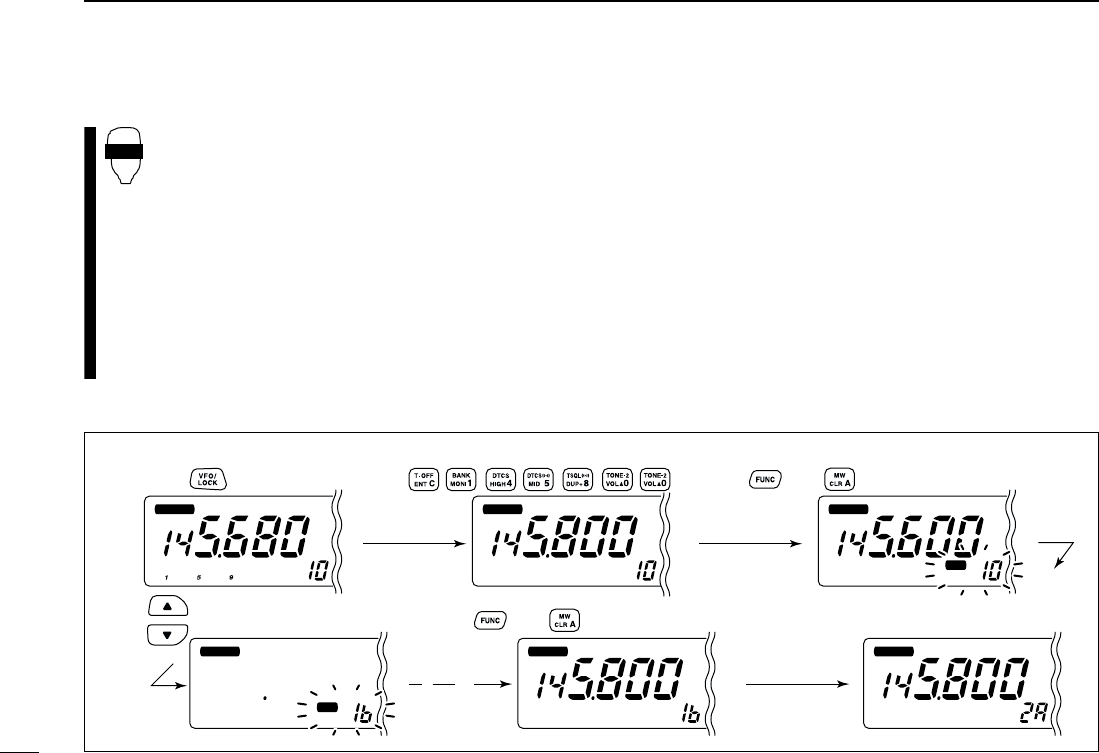
43
7SCAN OPERATION
New2001
DProgramming scan edges via microphone
zSet the desired frequency in VFO mode.
➥Push [VFO/LOCK] to select VFO mode.
➥Set the frequency via the keypad or [Y]/[Z].
xPush [FUNC] then [
CLR
A(MW)] momentarily.
cPush [Y] or [Z] to select scan edge channels,
1A, 2A, 3A, 4A or 5A.
vPush [FUNC], then push [
CLR
A(MW)] for 1 sec.
to program.
•3 beeps sound and VFO is automatically selected.
•Memory channel number advances to the next scan
edge channel, 1b, 2b, 3b, 4b or 5b when continuing to
push [
CLR
A(MW)] after programming.
bTo program a frequency for the other scan edge channels,
repeat steps zto v.
MW
[EXAMPLE]: Programming 145.800 MHz into scan edge 1b.
MAIN
T X
M
MAIN
T X
M
MAIN
T X
M
MAIN
T X
M
MAIN
T X
M
MAIN
T X
M
Push Push Push then momentarily
Push Push then for 1 sec. and continue to push
➠
Beep
“
Beep
Beep
Beep
“
“
“
“
“
IC-2720H.qxd 02.9.9 8:12 Page 43 (1,1)
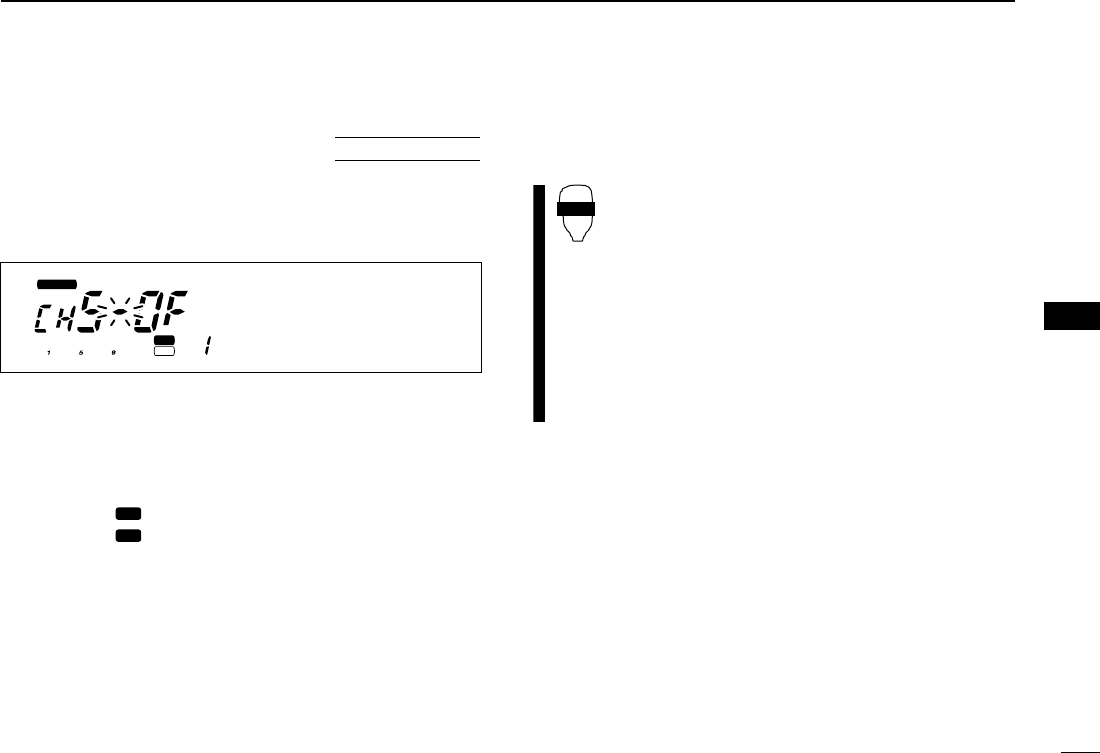
44
7
SCAN OPERATION
New2001
7
■Skip channel setting
The memory skip function speeds up scanning by checking
only those memory channels not set as skip channels. Set
skip channels as follows.
qSelect a memory channel in the desired band:
➥Push the desired band’s [M/CALL•MW] to select mem-
ory mode.
➥Rotate the same band’s [DIAL] to select the desired
channel to be a skip channel.
wPush
[SET•]
to enter set mode.
ePush
[SET•]
or [LOW•PRIO] several times until “CHS”
appears as shown above.
rRotate the [DIAL] to turn the skip function ON or OFF for
the selected channel.
•“~” appears : The channel is skipped during scan.
(CHS-On)
•“~” disappears : The channel is scanned during scan.
(CHS-OF)
tPush [TONE•DTMF] to exit set mode.
zSelect a memory channel.
➥Select memory mode by pushing [MR/CALL].
➥Push [Y] or [Z] to select the desired channel
to be a skip channel.
•Direct memory channel selection is also available.
xPush [
SET
B(D-OFF)] to enter set mode.
cPush [
SET
B(D-OFF)] or [
ENT
C(T-OFF)] several
times until “CHS” appears as shown at left.
vPush [Y] or [Z] to set or cancel the skip setting.
•See item rat left for skip indicator details.
bPush [
CLR
A(MW)] to exit set mode.
SET
B
MAIN
T X
M
SKIP
The display shows that memo-
ry channel 1 is set as a skip
channel.
USING
SET MODE
IC-2720H.qxd 02.9.9 8:12 Page 44 (1,1)
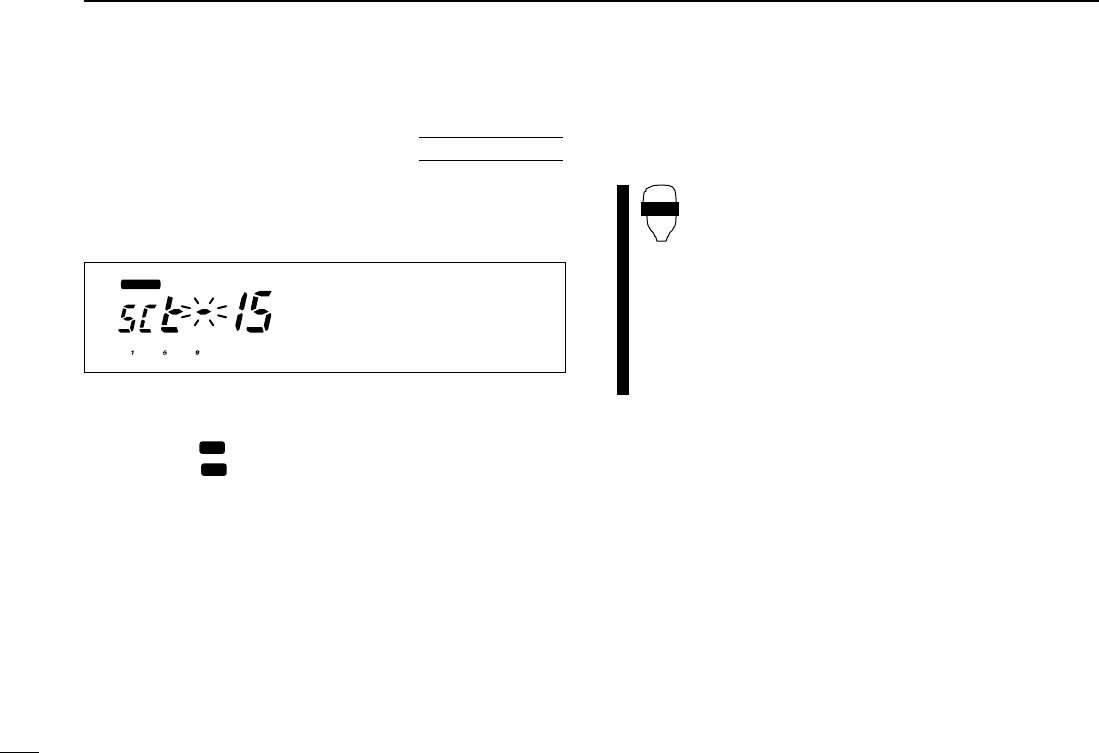
45
7SCAN OPERATION
New2001
■Scan resume condition
The scan resume condition can be selected as timer or pause
scan. The selected resume condition is also used for priority
watch. (p. 47)
qPush
[MAIN•
BAND
]
to select the desired band (left or right)
as the main band.
wPush
[SET•]
to enter set mode.
ePush
[SET•]
or [LOW•PRIO] several times until “SCt”
or “SCP” appears as shown above.
•When “d” is displayed in place of the 100 MHz digit, cancel the
DTMF memory encoder in advance. (p. 50)
rRotate the main band’s [DIAL] to set the desired timer:
•“SCt-15”: Scan pauses 15 sec. while receiving a signal.
•“SCt-10”: Scan pauses 10 sec. while receiving a signal.
•“SCt-5”: Scan pauses 5 sec. while receiving a signal.
•“SCP-2”: Scan pauses until the signal disappears and then
resumes 2 sec. later.
tPush [TONE•DTMF] to exit set mode.
zPush [BAND] to select the desired band (left or
right) as the main band.
xPush [
SET
B(D-OFF)] to enter set mode.
cPush [
SET
B(D-OFF)] or [
ENT
C(T-OFF)] several
times until “SCt” or “SCP” appears as shown at
left.
vPush [Y] or [Z] to select the scan resume condi-
tion.
•See item rat left for scan resume condition details.
bPush [
CLR
A(MW)] to exit set mode.
SET
B
MAIN
T X
M
The display shows that the
scan will resume 15 sec. after
it stops.
USING
SET MODE
IC-2720H.qxd 02.9.9 8:12 Page 45 (1,1)
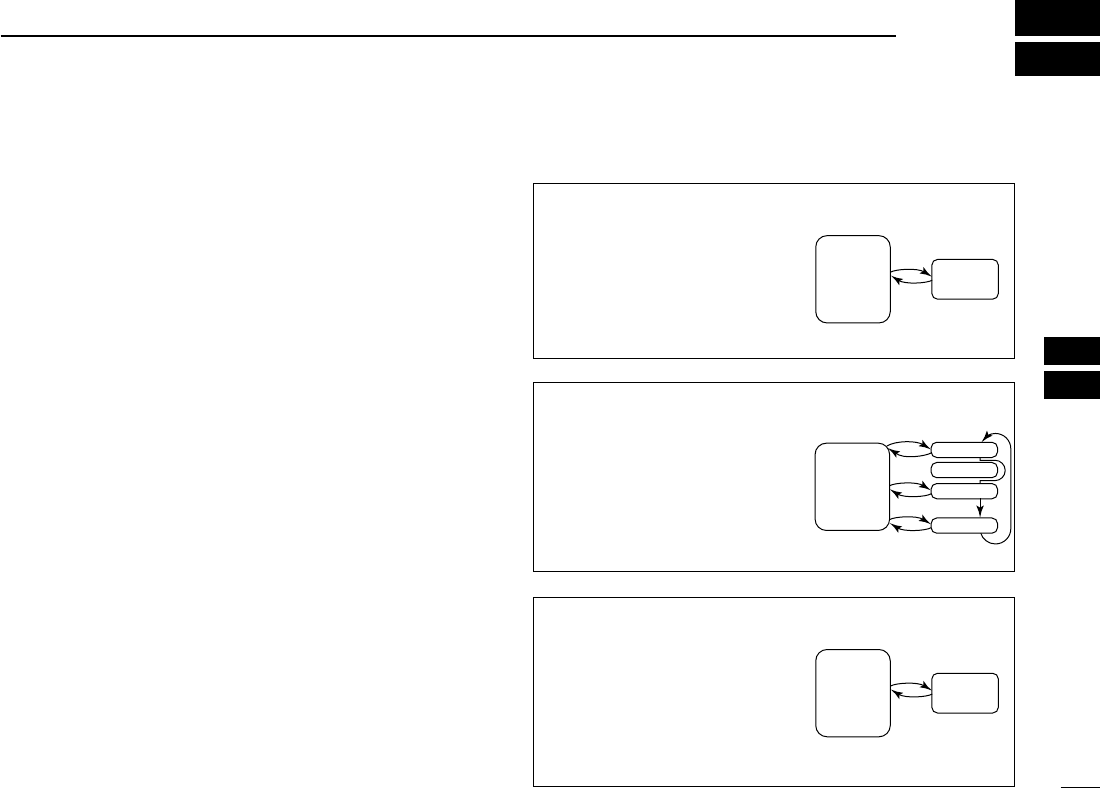
46
8
PRIORITY WATCH
7
8
■Priority watch types
Priority watch checks for signals on a VFO frequency every
5 sec. while operating in memory mode. The transceiver has
3 priority watch types to suit your needs. You can also trans-
mit on the VFO frequency while the priority watch operates.
The watch resumes according to the selected scan resume
condition. See previous page for details.
☞NOTES:
➧If the pocket beep function is activated, the transceiver
automatically selects the tone squelch function when pri-
ority watch starts.
MEMORY CHANNEL WATCH
While operating on a VFO fre-
quency, priority watch checks for
a signal on the selected memory
channel every 5 sec.
MEMORY SCAN WATCH
While operating on a VFO fre-
quency, priority watch checks for
signals on each memory chan-
nel in sequence.
•The memory skip function is useful
to speed up the scan.
CALL CHANNEL WATCH
While operating on a VFO fre-
quency, priority watch checks for
signals on the call channel every
5 sec.
5 sec.
VFO
frequency
50 msec.
Memory
channel
5 sec. 50 msec.
VFO
frequency
SKIP
Mch 1
Mch 2
Mch 3
Mch 199
5 sec.
VFO
frequency
50 msec.
Call
channel
IC-2720H.qxd 02.9.9 8:12 Page 46 (1,1)

47
8PRIORITY WATCH
New2001
■Priority watch operation
qSelect VFO mode; then, set an operating frequency in the
desired band (left or right).
wSet the watching channel(s).
For memory channel watch:
Select the desired memory channel.
For memory scan watch:
Select memory mode; then, push the same band’s
[V/MHz•SCAN] for 1 sec. to start memory scan.
For call channel watch:
Select the desired call channel by pushing the same
band’s [M/CALL•MW] once or twice, then rotate the [DIAL].
ePush [LOW•PRIO] for 1 sec. to start the watch.
•The transceiver checks the memory or call channel every 5 sec.
•The watch resumes according to the selected scan resume con-
dition. (p. 45)
•While the watch is pausing, pushing the [M/CALL(PRIO)] re-
sumes the watch manually.
rPush [LOW•PRIO] for 1 sec. to stop the watch.
zSelect VFO mode; then, set the desired fre-
quency.
xSet the watching channel(s).
For memory channel watch:
Push [MR/CALL] then [Y] or [Z] to select the de-
sired memory channel.
For memory scan watch:
Push [MR/CALL], then push [
SCAN
2] to start the
memory scan.
For call channel watch:
Push [MR/CALL] for 1 sec. then push [Y] or [Z]
to select the call channel.
cPush [
PRIO
3(PTT-M)] to start the watch.
•The transceiver checks the memory or call channel
every 5 sec.
•The watch resumes according to the selected scan re-
sume condition. (p. 45)
•To resume the watch manually when paused, push
[
PRIO
3(PTT-M)] or [
CLR
A(MW)].
vTo stop the watch, push [
CLR
A(MW)] once (or
twice while watch is paused).
PRIO
3
IC-2720H.qxd 02.9.9 8:12 Page 47 (1,1)
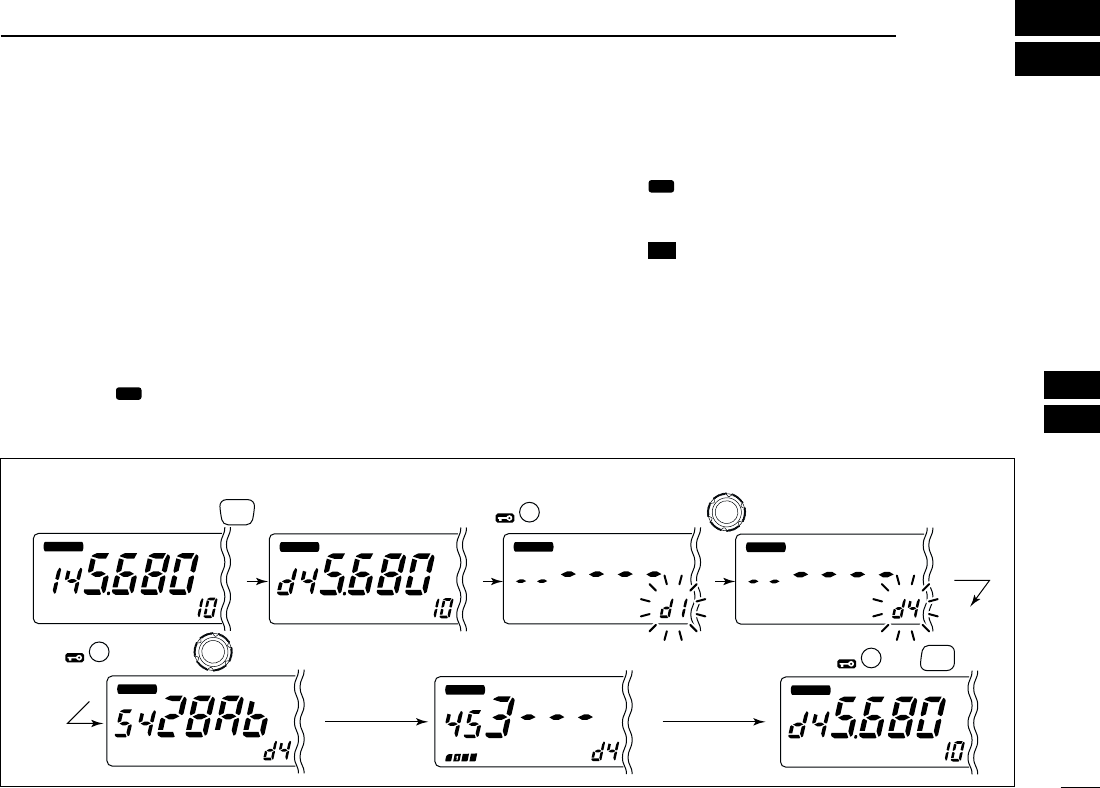
48
9
DTMF MEMORY ENCODER
8
9
■Programming a DTMF code
DTMF tones are used for autopatching, controlling other
equipment, etc. The transceiver has 14 DTMF memory chan-
nels (d0–dd) for storage of often-used DTMF codes of up to
24 digits.
qPush [TONE•DTMF] for 1 sec. to turn the DTMF encoder
ON.
•Select the main band in advance, by pushing the desired band’s
[MAIN•BAND], if necessary.
•“d” appears in place of the main band’s 100 MHz digit.
wPush
[SET•]
to enter the DTMF memory programming
condition.
•The DTMF memory channel indication blinks.
eRotate the main band’s [DIAL] to select the desired DTMF
memory channel.
rPush
[SET•].
•The first digit blinks.
tRotate the [DIAL] to select the desired code.
yPush
[SET•] to select the next digit.
•Pushing [LOW•PRIO] move the cursor backward.
uRepeat the steps tand yto set the desired DTMF tone
sequence.
•The S/RF indicator shows the digit group. The indication in-
creases every 6 digits.
iPush
[TONE•DTMF] to exit DTMF memory programming
condition.
•Return to the previous indication as in step q.
[EXAMPLE]: Programming “5428AB453” into DTMF memory channel “d4.”
MAIN
T X
M
MAIN
T X
M
MAIN
T X
M
MAIN
T X
M
MAIN
T X
M
MAIN
T X
M
MAIN
T X
M
Push
Push then rotate Repeat the previous step until
the desired code is entered. Push any switch except and
RotatePush for 1 sec.
TONE
DTMF
LOW
PRIO
SET
SET SET
IC-2720H.qxd 02.9.9 8:12 Page 48 (1,1)
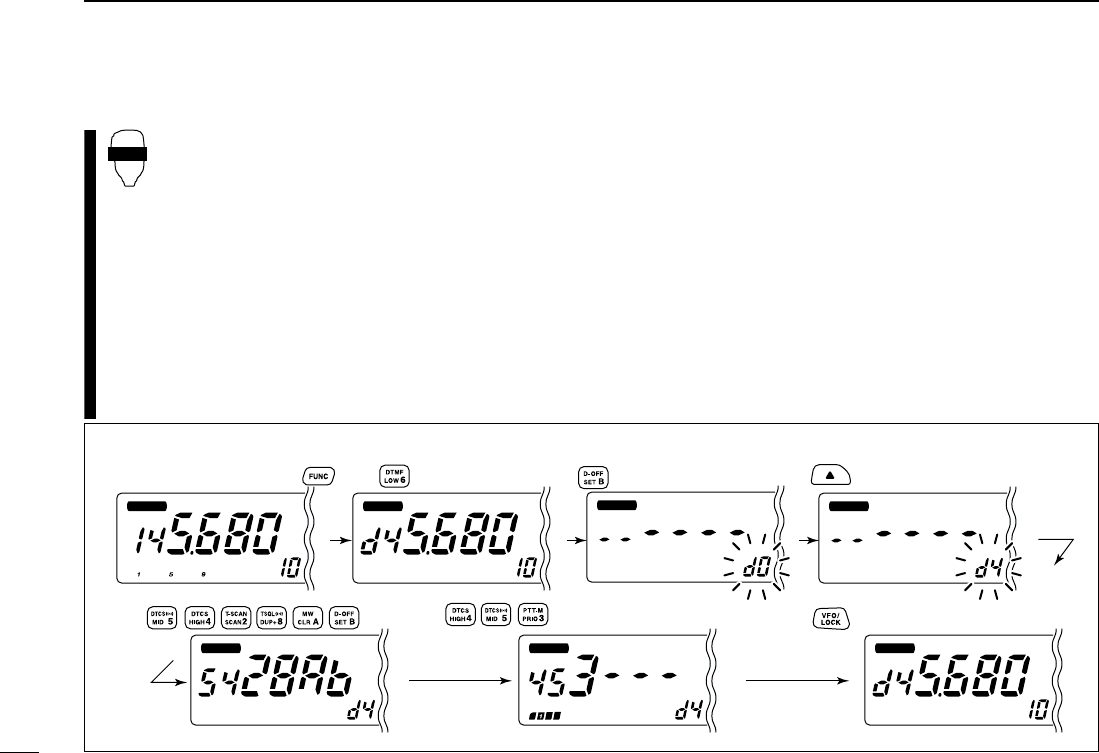
49
9DTMF MEMORY ENCODER
New2001
D
Programming a DTMF code— via microphone
zPush [FUNC] then [
LOW
6(DTMF)] to turn the
DTMF encoder ON.
•
“d” appears in place of the main band’s 100 MHz digit.
xPush [
SET
B(D-OFF)] to enter the DTMF memory
programming condition.
cPush [Y] or [Z] to select the desired DTMF
memory channel.
vPush the desired digit keys.
•When the first digit is input, previous memory contents
are cleared automatically.
•“E” stands for “MM” and “F” stands for “# .”
•Push [Y]/[Z] and repeat this step if you make a mistake.
•The S/RF indicator shows the digit group. The indication
increases every 6 digits.
bPush [VFO/LOCK] to exit the programming condition.
•The [
CLR
A(MW)] key cannot be used to exit. If pushed, code “A”
is input. Reprogram in such a case.
DTMF
[EXAMPLE]: Programming “5428AB453” into DTMF memory channel “d4.”
MAIN
T X
M
MAIN
T X
M
MAIN
T X
M
MAIN
T X
M
MAIN
T X
M
MAIN
T X
M
MAIN
T X
M
Push
Push Push
Push
Push then .
IC-2720H.qxd 02.9.9 8:12 Page 49 (1,1)
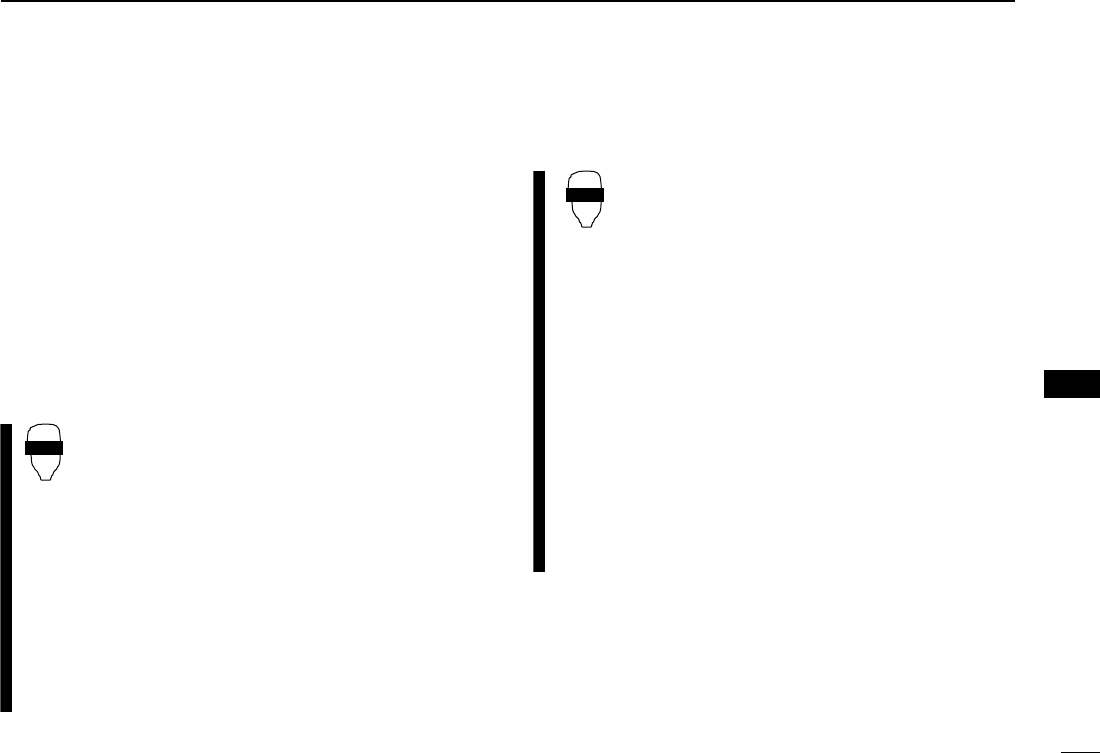
50
9
DTMF MEMORY ENCODER
New2001
9
■Transmitting a DTMF code
DAutomatic transmission (DTMF memory)
qPush [TONE•DTMF] for 1 sec. to turn the DTMF memory
encoder ON.
• “d” appears in place of the main band’s 100 MHz digit.
w
Push [SET•] to enter DTMF memory programming condition.
eRotate main band’s [DIAL] to select the desired DTMF
memory channel.
r
Push [PTT] to transmit the selected DTMF memory content.
tPush [TONE•DTMF] for 1 sec. to cancel the DTMF en-
coder.
•When the DTMF encoder is turned ON continuously, each push
of the PTT transmits the previously selected DTMF code.
zPush [FUNC] then [
LOW
6(DTMF)] to turn the
DTMF memory encoder ON.
•
“d” appears in place of the main band’s 100 MHz digit.
xPush [
SET
B(D-OFF)] to enter the DTMF memory
programming condition.
cPush [Y] or [Z] to select the desired channel.
vPush [PTT] to transmit the selected memory.
•Exit the programming condition automatically.
•Each push of [PTT] transmits the DTMF code.
bPush [FUNC] then [
SET
B(D-OFF)] to cancel the
DTMF memory encoder.
•When the DTMF encoder is turned ON continuously,
each push of the PTT transmits the previously se-
lected DTMF code.
DTransmitting a DTMF memory directly
zPush [FUNC] then [
LOW
6(DTMF)] to turn the
DTMF memory encoder ON.
•
“d” appears in place of the main band’s 100 MHz digit.
x
Push [DTMF-S] to turn the DTMF memory di-
rect selection ON.
•The function indicator (microphone) lights green.
cPush the desired DTMF channel.
•“0” to “9” and “A” to “D” are available for DTMF
memory channels.
•The selected DTMF code is automatically transmit-
ted without pushing PTT.
NOTE: When no DTMF code programmed
channel number is pushed, it transmits the rela-
tive DTMF code as the manual transmission de-
scribed in the next page.
vPush [DTMF-S] again to deactivate the DTMF
memory direct selection.
bPush [FUNC] then [
SET
B(D-OFF)] to cancel
the DTMF memory encoder.
DTMF-S
DTMF
IC-2720H.qxd 02.9.9 8:12 Page 50 (1,1)
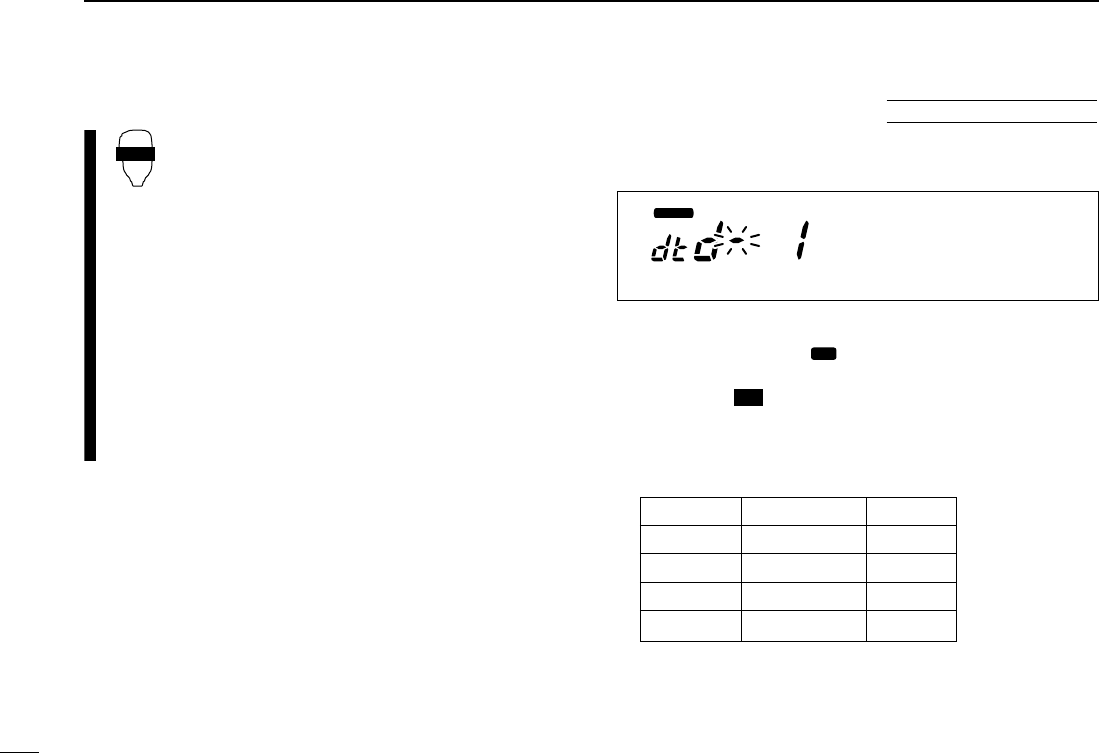
51
9DTMF MEMORY ENCODER
New2001
DManual transmission
zDeactivate the DTMF memory encoder by
pushing [FUNC] then [
SET
B(D-OFF)].
x
Push [DTMF-S] to turn the DTMF direct selec-
tion ON.
•The function indicator (microphone) lights green.
cPush one of “0” to “9” and “A” to “F” keys mo-
mentarily, then push the desired DTMF keys,
0–9 and A to F.
•A: [
CLR
A(MW)] B: [
SET
B(D-OFF)],
C: [
ENT
C(T-OFF)] D: [
SQL
YD(MUTE)],
E: [MM(TONE-1)] F: [
SQL
Z#(16KEY-L)]
•Automatically transmits without pushing PTT.
•The first code, one of “A” to “F,” is not transmitted.
DTMF code transmission starts from the 2nd code.
vPush [DTMF-S] again to deactivate the DTMF
direct selection.
■DTMF speed
The rate at which DTMF memories send individual DTMF
characters can be set to accommodate operating needs.
qPush [PWR] for 1 sec. to turn power OFF.
wWhile pushing
[SET•],
push [PWR] for 1 sec. to turn
power ON and enter initial set mode.
ePush
[SET•]
or [LOW•PRIO] several times until “dtd”
appears as shown above.
rRotate the left band’s [DIAL] to select the desired speed
as shown in the table below.
tPush [PWR] to exit initial set mode.
cps=characters/sec
MAIN
T X
M
The display shows the fastest
DTMF speed is selected.
USING
INITIAL SET MODE
DTMF-S
DISPLAY INTERVAL SPEED
dtd-- 1 100 msec. 5.0 cps
dtd-- 2 200 msec. 2.5 cps
dtd-- 3 300 msec. 1.6 cps
dtd-- 5 500 msec. 1.0 cps
IC-2720H.qxd 02.9.9 8:12 Page 51 (1,1)
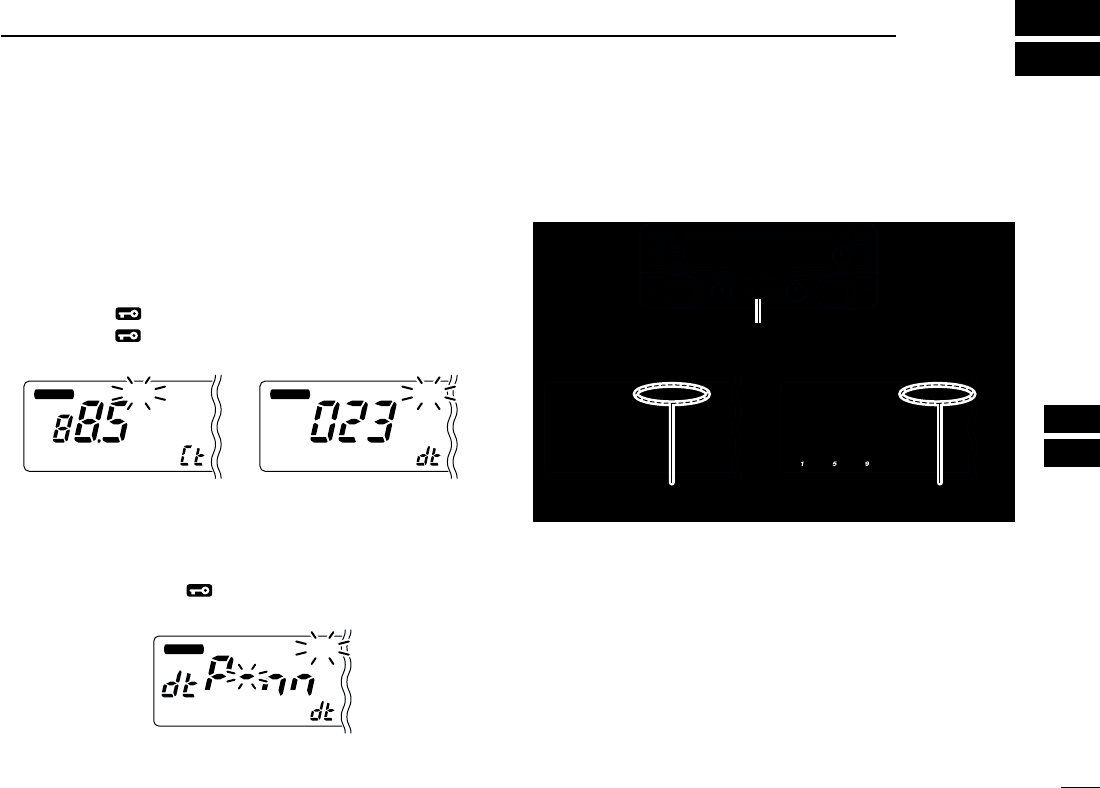
52
10
POCKET BEEP AND TONE SQUELCH
9
10
■Pocket beep operation
This function uses subaudible tones for calling and can be
used as a “common pager” to inform you that someone has
called while you were away from the transceiver.
DWaiting for a call from a specific station
qSet the operating frequency.
wPush
[SET•]
to enter set mode in the main band.
ePush
[SET•]
or [LOW•PRIO] several times until “Ct” for
tone squelch or “dt” for DTCS squelch appears.
rRotate the main band’s [DIAL] to select the desired tone
squelch frequency.
tWhen operating the pocket beep function with DTCS
squelch, push
[SET•] once then r
otate [DIAL] to select
the DTCS polarity.
yPush [TONE•DTMF] to exit set mode.
uPush [TONE•DTMF] several times until “T SQLS” or
“SDTCS” are displayed to turn ON the pocket beep with
tone squelch or DTCS squelch, respectively.
iWhen a signal with the matched tone is received, the
transceiver emits beep tones and blinks “S”.
•Beep tones sound for 30 sec. and “S” blinks. To stop the
beeps and blinking manually, push any key. When the beep
tones are not stopped manually, “S” continues blinking until
[PTT] is pushed (see step o).
oPush [PTT] to answer.
•“S” disappears and cancels the pocket beep function auto-
matically.
!0 Push [TONE•DTMF] several times until “T SQL” or “DTCS”
disappears to cancel the tone squelch or DTCS squelch
function.
MAIN
T X
T SQL
M
MAIN
T X
DTCS
M
Push [TONE•DTMF] several times to select the pocket beep
function with tone squelch or DTCS squelch.
Appears when the pocket beep
with tone squelch is activated.
Appears when the pocket beep
with DTCS squelch is activated.
MAIN
T X
DTCS
M
DTCS polarity setting
MAIN
T X
T SQL
M
MAIN
T X
DTCS
M
Tone squelch frequency setting DTCS code setting
IC-2720H.qxd 02.9.9 8:12 Page 52 (1,1)
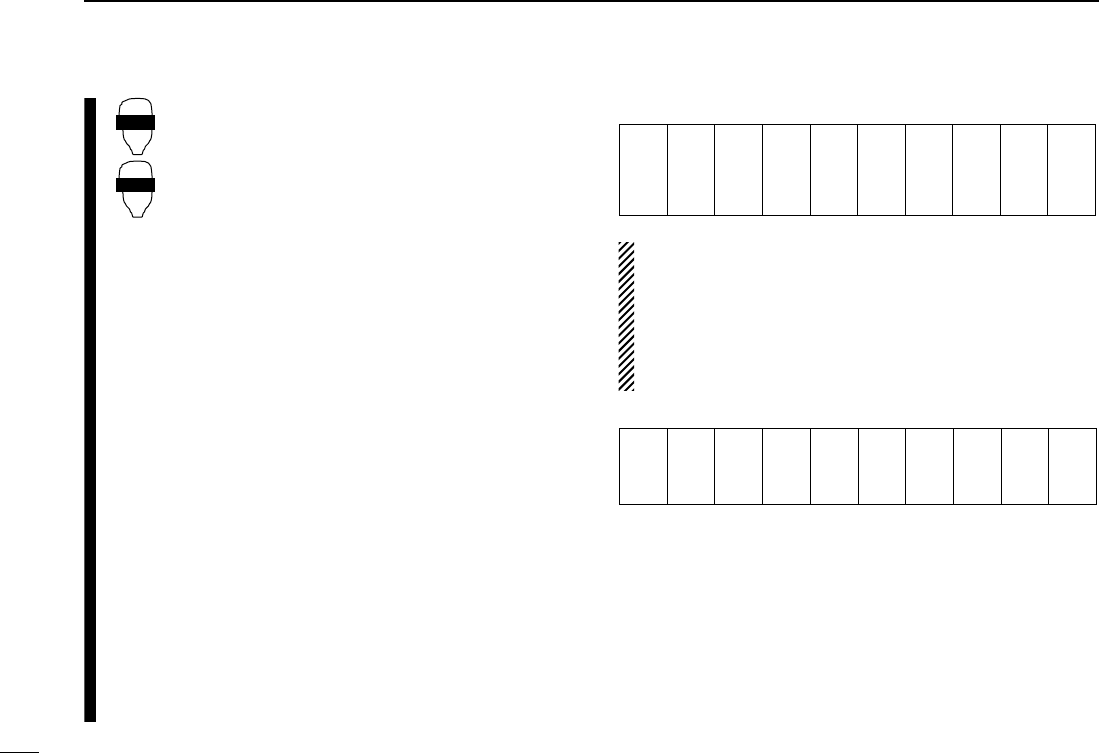
53
10 POCKET BEEP AND TONE SQUELCH
New2001
zSet the operating frequency.
xProgram the CTCSS tone frequency or DTCS
code in set mode.
➥Push [
SET
B(D-OFF)] to enter set mode.
➥Push [
SET
B(D-OFF)] or [
ENT
C(T-OFF)]
several times until “Ct” for tone squelch or
“dt” for DTCS squelch appears.
•“T SQL” blinks when tone squelch (“Ct”), or
“DTCS” blinks when DTCS squelch (“dt”) is se-
lected.
➥Push [Y]/[Z] to select the desired tone fre-
quency or DTCS code.
➥Push [
SET
B(D-OFF)] to select “dtP” then
push [Y]/[Z] to select the DTCS polarity.
➥Push [
CLR
A(MW)] to exit set mode.
cPush [FUNC] then push [
DUP
+ 8(TSQLS)]
or [
MID
5(DTCSS)] to turn ON the pocket
beep with tone squelch or DTCS squelch, re-
spectively.
vWhen a signal with the matched tone is re-
ceived, the transceiver emits beep tones for
30 sec. and blinks “S.”
bPush [PTT] to answer or push [
CLR
A(MW)] to
stop the beeps and blinking.
•“S” disappears and cancels the pocket beep
function automatically.
nTo cancel the tone squelch or DTCS squelch
function, push [FUNC] then [
ENT
C(T-OFF)].
•“T SQL” or “DTCS” disappears
DAvailable tone frequency list
NOTE: The transceiver has 50 tone frequencies and con-
sequently their spacing is narrow compared to units having
38 tones. Therefore, some tone frequencies may receive
interference from adjacent tone frequencies.
To prevent interference from adjacent tone frequencies,
using the frequencies as in the following table, is recom-
mended.
DCalling a waiting station using pocket beep
A subaudible tone matched with the station’s CTCSS tone fre-
quency or 3-digit DTCS code with polarity is necessary. Use
the tone squelch on the next page or a subaudible tone en-
coder (pgs. 25, 26).
67.0
69.3
71.9
74.4
88.5
91.5
94.8
97.4
114.8
118.8
123.0
127.3
151.4
156.7
162.2
167.9
203.5
210.7
218.1
225.7
77.0
79.7
82.5
85.4
100.0
103.5
107.2
110.9
131.8
136.5
141.3
146.2
173.8
179.9
186.2
192.8
233.6
241.8
250.3
• Recommended tone frequencies
67.0
69.3
71.9
74.4
77.0
79.7
82.5
85.4
88.5
91.5
94.8
97.4
100.0
103.5
107.2
110.9
114.8
118.8
123.0
127.3
131.8
136.5
141.3
146.2
151.4
156.7
159.8
162.2
165.5
167.9
171.3
173.8
177.3
179.9
183.5
186.2
189.9
192.8
196.6
199.5
203.5
206.5
210.7
218.1
225.7
229.1
233.6
241.8
250.3
254.1
TSQLS
DTCSS
IC-2720H.qxd 02.9.9 8:12 Page 53 (1,1)
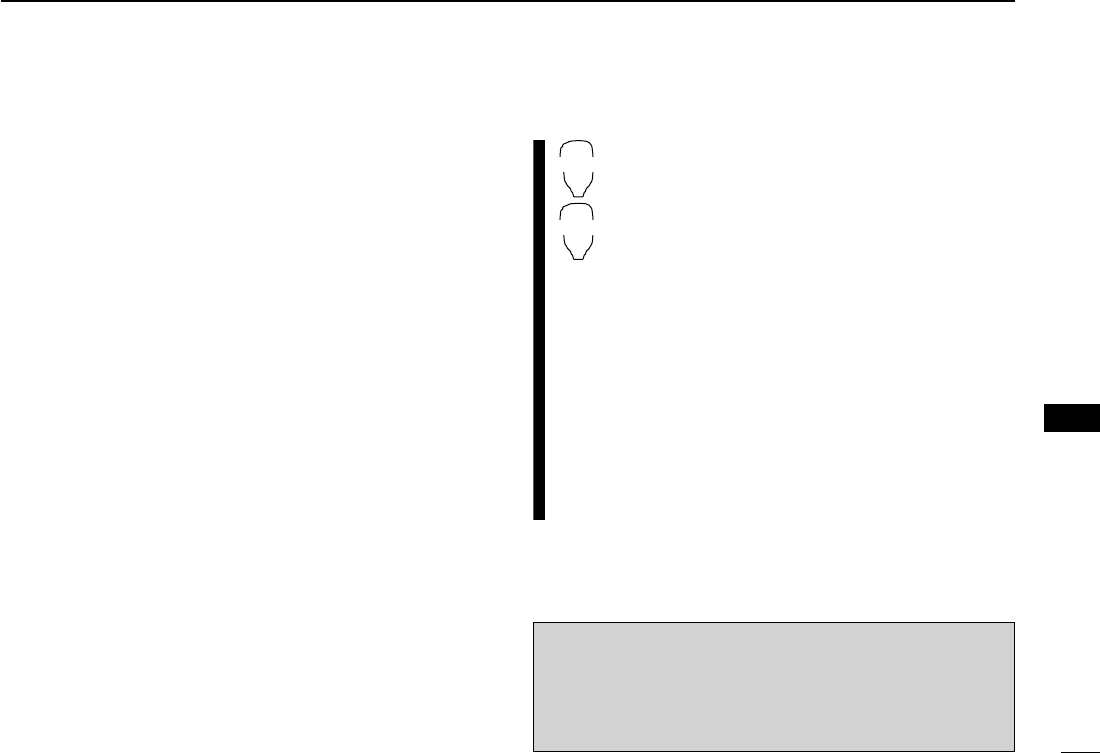
54
10
POCKET BEEP AND TONE SQUELCH
New2001
10
■Tone/DTCS squelch operation
The tone or DTCS squelch opens only when receiving a sig-
nal with the same pre-programmed subaudible tone or DTCS
code, respectively.
qSet the operating frequency in the main band.
wProgram the CTCSS tone frequency or DTCS code in set
mode.
•See p. 52 for programming details.
ePush [TONE•DTMF] several times until “T SQL” or “DTCS”
appears in the function display.
rWhen a signal with the matched tone is received, the
squelch opens and the signal can be heard.
•When the received signal includes an unmatched tone, the
squelch does not open. However, the S/RF indicator shows the
received signal strength.
•To open the squelch manually, push [DUP•MONI].
tOperate the transceiver in the normal way (push [PTT] to
transmit; release [PTT] to receive).
yTo cancel the tone squelch, push [TONE•DTMF] several
times until “T SQL” or “DTCS” disappears.
zSet the operating frequency.
xProgram the CTCSS tone frequency or DTCS
code in set mode.
•See p. 53 for programming details.
c
Push [FUNC] then [
SIMP
9(TSQL)] or [
HIGH
4(DTCS)]
to turn the tone squelch or DTCS squelch ON.
vWhen a signal with the matched tone is re-
ceived, the squelch opens and the signal can be
heard.
•When the received signal includes an unmatched
tone, the squelch does not open. However, the S/RF
indicator shows the received signal strength.
•To open the squelch manually, push [
MONI
1(BANK)].
bOperate the transceiver in the normal way (push
[PTT] to transmit; release [PTT] to receive.
nTo cancel the tone squelch, push [FUNC] then
[
ENT
C(T-OFF)].
•“T SQL” or “DTCS” disappears
TSQL
DTCS
NOTE: The DTCS squelch operation on sub band will not
be performed during DTCS transmission, due to the same
encoder/decoder circuit is used for both main and sub
bands. And the tone squelch operation on sub band may
not be performed correctly during DTCS transmission.
IC-2720H.qxd 02.9.9 8:12 Page 54 (1,1)
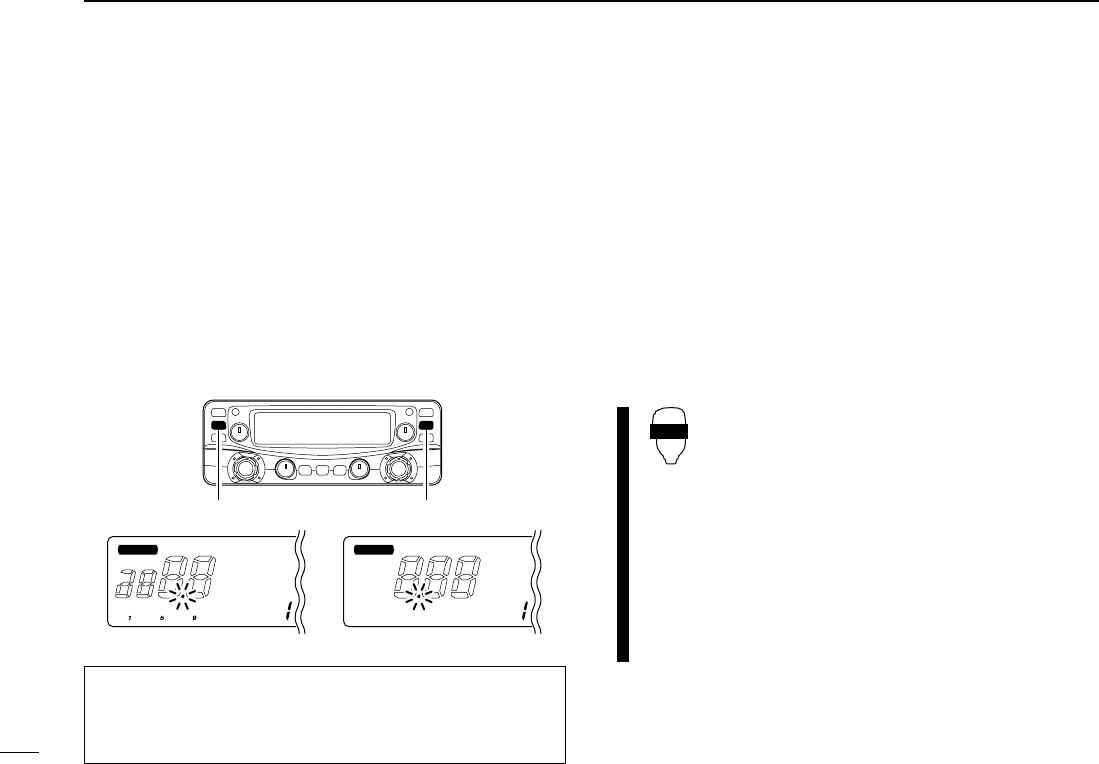
55
10 POCKET BEEP AND TONE SQUELCH
New2001
■Tone scan
By monitoring a signal that is being operated with pocket
beep, tone or DTCS squelch function, you can determine the
tone frequency or DTCS code necessary to open a squelch.
qSet the desired operating frequency or memory channel to
be checked for a tone frequency or code in the main band.
wPush [TONE•DTMF] several times to select the tone type,
tone squelch or DTCS, to be scanned.
•Either “T SQL” or “DTCS” appears
ePush the main band’s [V/MHz•SCAN] for 1 sec. to start the
tone scan.
•To change the scanning direction, rotate [DIAL].
rWhen the CTCSS tone frequency or 3-digit DTCS code is
matched, the squelch opens and the tone frequency is
temporarily programmed into the selected condition such
as memory or call channel.
•The tone scan pauses when a CTCSS tone frequency or 3-digit
DTCS code is detected.
•The decoded CTCSS tone frequency or 3-digit DTCS code is
used for the tone encoder or tone encoder/decoder depending
on the selected tone condition or type in step w.
-“T SQL” : CTCSS tone encoder/decoder
-“DTCS” : DTCS tone encoder/decoder
tPush [V/MHz•SCAN] to stop the scan.
zSet the frequency or memory channel to be
checked for a tone frequency.
xSelects the tone type to be scanned.
•Push [FUNC] then push; [
SIMP
9(TSQL)] for tone
squelch; [
HIGH
4(DTCS)] for DTCS squelch.
cPush [FUNC] then [
SCAN
2(T-SCAN)] to start
the tone scan.
vWhen the tone frequency is matched, the
squelch opens and the tone frequency is pro-
grammed into the selected mode such as
memory or call channel.
bPush [
CLR
A(MW)] to stop the scan.
T-SCAN
MAIN
T X
T SQL
M
MAIN
T X
DTCS
M
During CTCSS frequency scan During DTCS code scan
Push [V/MHz•SCAN] for 1 sec. to start tone scan.
☞NOTE: The decoded tone frequency is programmed tem-
porarily when a memory or call channel is selected. How-
ever, this will be cleared when the memory/call channel is
re-selected.
IC-2720H.qxd 02.9.9 8:12 Page 55 (1,1)
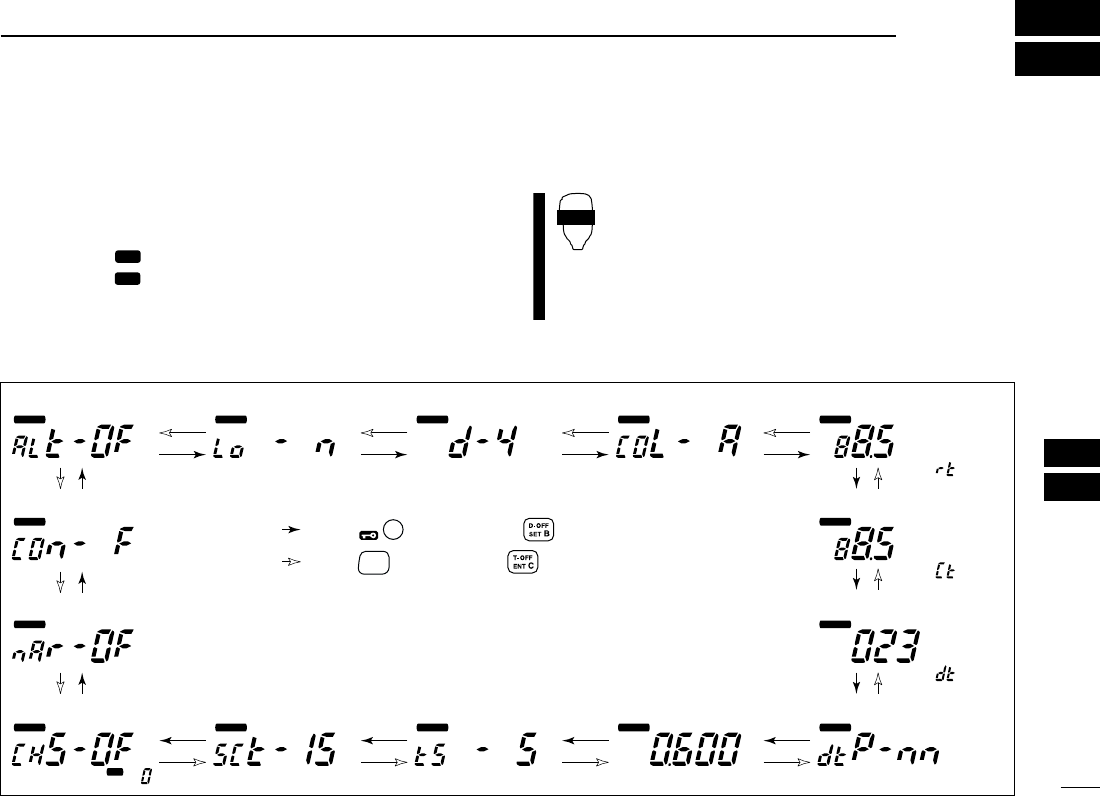
56
11
OTHER FUNCTIONS
10
11
MAIN
T X
M
MAIN
T X
M
MAIN
T X
T
M
MAIN
T X
M
MAIN
T X
M
MAIN
T X
M
MAIN
T X
T SQL
M
MAIN
T X
M
MAIN
T X
M
MAIN
T X
M
MAIN
T X
DUP
M
MAIN
T X
DTCS
M
MAIN
T X
DTCS
M
MAIN
T X
M
• Mode selection**
• Display dimmer • Display color • Repeater tone frequency
• Narrow setting
‡
• Channel skip setting
†
• 1st Lo frequency
• Tone squelch frequency
• Weather alert*
• Scan resume timer • Tuning step • Offset frequency • DTCS polarity
• DTCS code
*Available for USA version only.
†Appears when accessing set mode from memory mode only.
‡Available for the USA version and appears when accessing set mode from left band only.
**Does not appear when accessing set mode from 900 MHz band.
: Push (front panel); or (microphone)
SET
: Push (front panel); or (microphone)
LOW
PRIO
■Set mode
•Set mode operation
qPush the desired band’s
[MAIN•BAND]
to select the main
band.
wPush
[SET•]
to enter the set mode.
ePush
[SET•]
or [LOW•PRIO] to select the desired item.
rRotate the main band’s [DIAL] to select the condition or
value.
tPush
[TONE•DTMF]
to exit set mode.
•Set mode items
zPush [BAND] to select the main band.
xPush [
SET
B(D-OFF)] to enter set mode.
cPush [
SET
B(D-OFF)] or [
ENT
C(T-OFF)] to select
the desired item.
vPush [Y] or [Z] to select the condition or value.
bPush [
CLR
A(MW)] to exit set mode.
SET
B
IC-2720H.qxd 02.9.9 8:12 Page 56 (1,1)
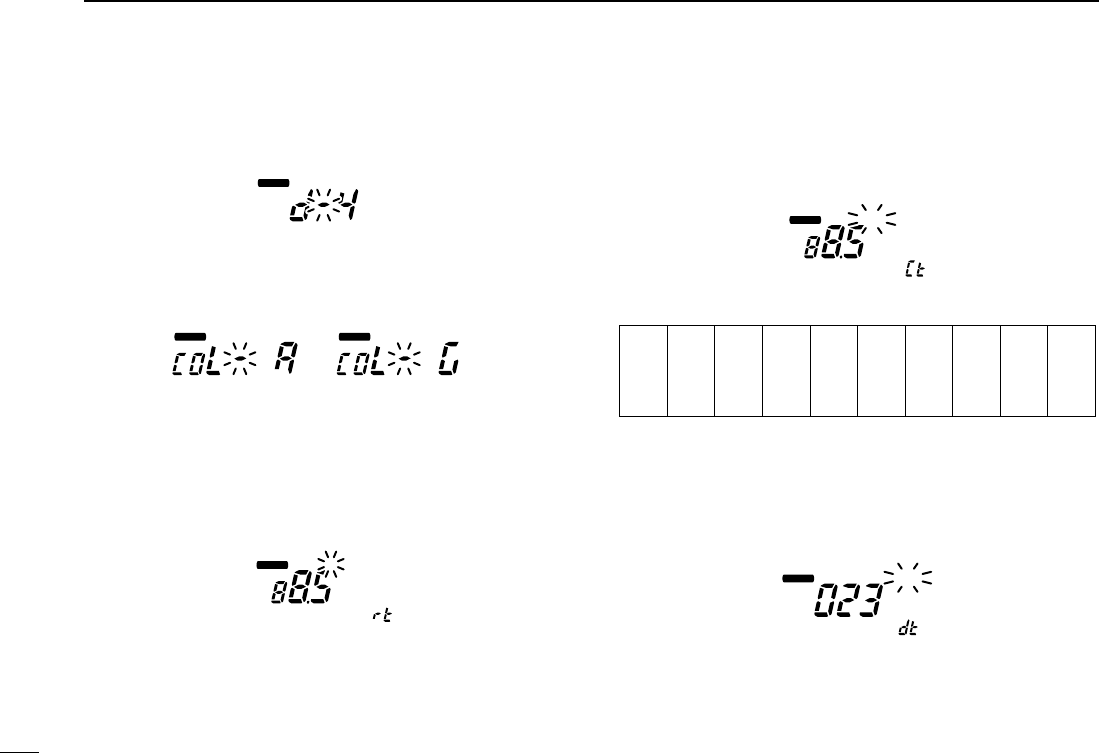
57
11 OTHER FUNCTIONS
New2001
DDDisplay dimmer
Adjust to suit lighting conditions.
The levels 1 (dark) to 4 (bright: default) are available.
DDDisplay color
The display color can be set to amber (default) or green.
DDRepeater tone
Sets subaudible tone frequency (encoder only) for repeater
operation. Total of 50 tone frequencies (67.0–254.1 Hz) are
available. (default: 88.5 Hz)
DDTone squelch tone
Sets subaudible tone frequency (both encoder and decoder)
for tone squelch operation. Total of 50 tone frequencies
(67.0–254.1 Hz) are available. (default: 88.5 Hz)
•Available subaudible tone frequencies
DDDTCS code
Sets DTCS code (both encoder and decoder) for DTCS
squelch operation. Total of 104 codes are available.
(default: 023)
MAIN
T X
DTCS
M
67.0
69.3
71.9
74.4
77.0
79.7
82.5
85.4
88.5
91.5
94.8
97.4
100.0
103.5
107.2
110.9
114.8
118.8
123.0
127.3
131.8
136.5
141.3
146.2
151.4
156.7
159.8
162.2
165.5
167.9
171.3
173.8
177.3
179.9
183.5
186.2
189.9
192.8
196.6
199.5
203.5
206.5
210.7
218.1
225.7
229.1
233.6
241.8
250.3
254.1
MAIN
T X
T SQL
M
MAIN
T X
T
M
MAIN
T X
M
MAIN
T X
M
• Amber setting • Green setting
MAIN
T X
M
IC-2720H.qxd 02.9.9 8:12 Page 57 (1,1)
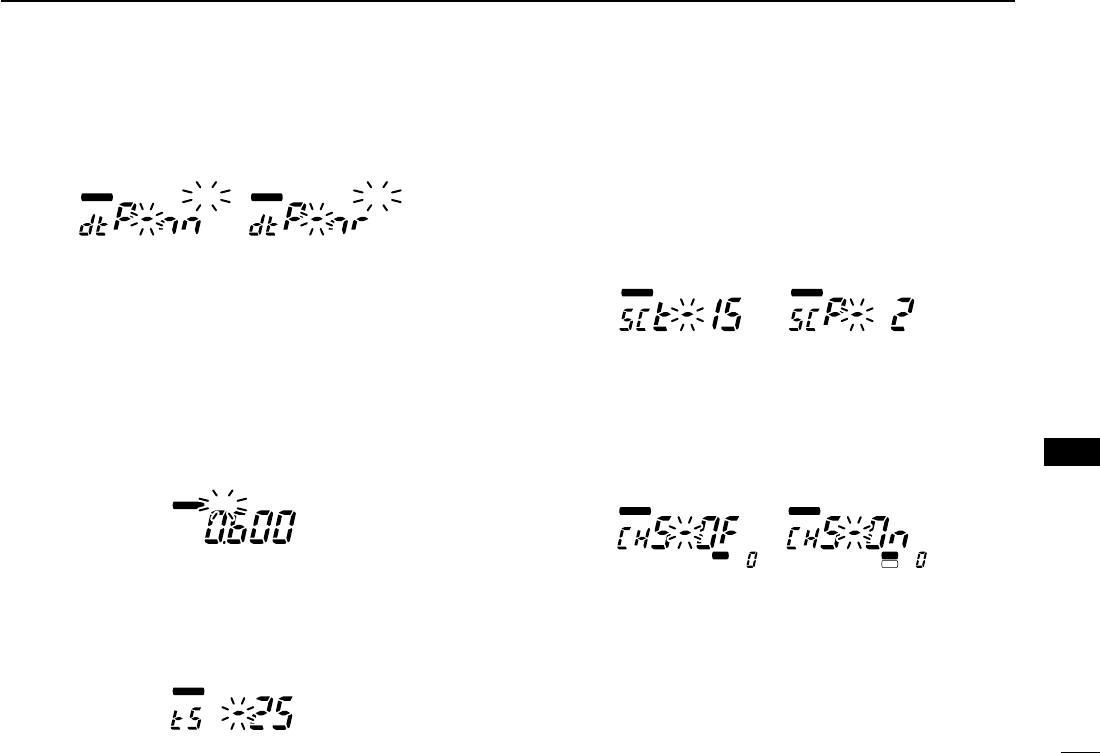
58
11
OTHER FUNCTIONS
New2001
11
DDDTCS polarity
Sets DTCS polarities for transmission and reception from
“nn,” “nr,” “rn” and “rr.”(default: nn)
DDOffset frequency
Sets the duplex offset frequency within 0 to 20 MHz range.
During duplex (repeater) operation, transmit frequency (or re-
ceive when reverse function is set to ON) shifts the set fre-
quency. (default value may differ depending on operating frequency
band and versions)
DDTuning step
Selects tuning step from 5, 10, 12.5, 15, 20, 25, 30 and
50 kHz for [DIAL] or [Y]/[Z] operation. (default value may differ
depending on operating frequency band and versions)
DDScan resume timer
Selects scan resume timer from SCT-15 (default), SCT-10,
SCT-5 and SCP-2.
•SCT-15/10/5 : Scan pauses for 15/10/5 sec., then re-
sumes.
•SCP-2 : Pause on a signal until signal disap-
pears, then resumes 2 sec. after the sig-
nal disappears.
DDChannel skip setting
Sets channel skip setting from ON and OFF for memory skip
scan operation.
This item appears when set mode is accessed from memory
mode only.
MAIN
T X
M
MAIN
T X
M
SKIP
• “~” appears
when set to “On.”
• Default setting
MAIN
T X
M
MAIN
T X
M
MAIN
T X
M
MAIN
T X
DUP
MAIN
T X
DTCS
M
MAIN
T X
DTCS
M
• Transmit : normal
Receive : normal
(default)
• Transmit : normal
Receive : reverse
IC-2720H.qxd 02.9.9 8:12 Page 58 (1,1)
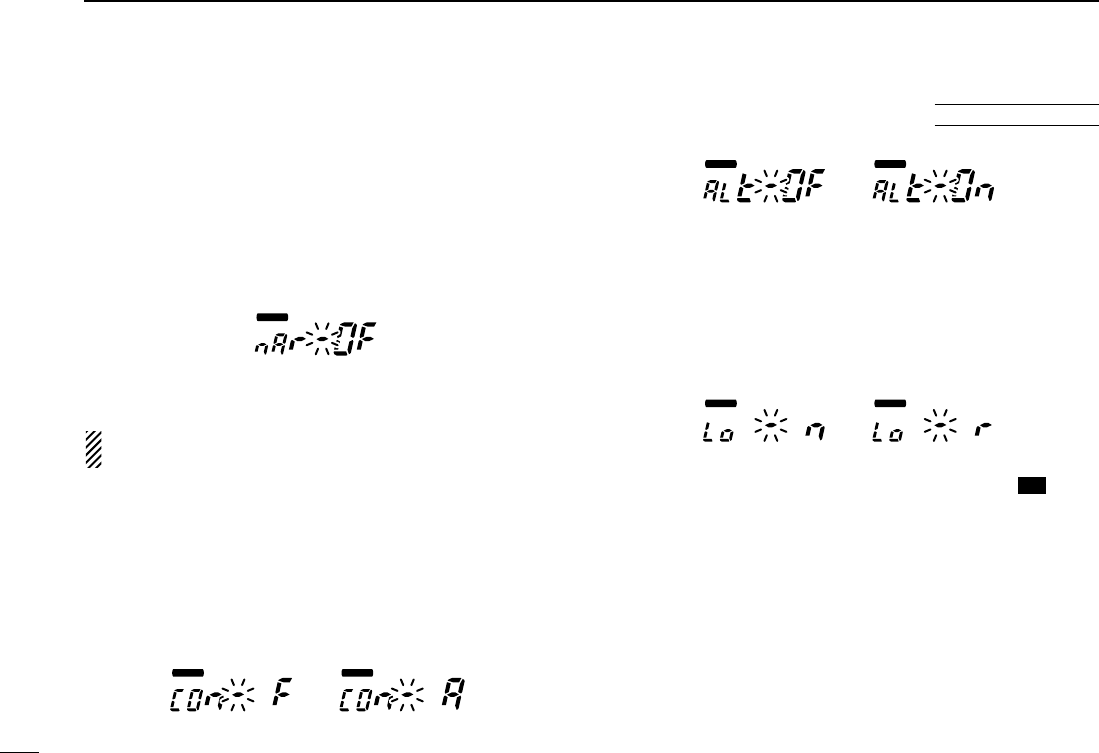
59
11 OTHER FUNCTIONS
New2001
DDWide/Narrow setting (Left band only)
Sets both the transmission and reception passband width
from wide and narrow.
When narrow is set, the transmission deviation and reception
passband width become half of the wide setting (approx.).
This setting can be set for each memory, call and VFO inde-
pendently.
This item appears when set mode is accessed from left band
only.
DDOperating mode setting
NOTE: This item appears only when accessing set mode
from other than 900 MHz band.
Selects the operating mode for the desired frequency band
from FM and AM.
The selected mode is used for the previously selected oper-
ating frequency band— for example, when entering set mode
from 127 MHz band and AM is selected, AM is automatically
selected even FM is selected in other frequency bands.
This setting can be set for each memory, call and VFO inde-
pendently.
DDWeather alert function
Turns weather alert function ON and OFF.
DD1st Lo frequency selection
Selects the 1st Lo (Local Oscillator) frequency from normal
(n) and reverse (r).
By changing local oscillator frequency, the transceiver may
reject interference or image frequencies, such as from other
stations spurious or the transceiver’s internal oscillator.
This item can also be switched by
pushing
[SET•] while
transmitting (pushing and holding [PTT]) for sub band (non-
main band) setting.
It is helpful in case the transceiver receiving heterodyne spu-
rious emissions, or receiving on an image frequency from
own transmitter.
The local oscillator frequency can be switched when selecting
a frequency within 118.000 to 160.000 MHz range in left
band, or 400.000 to 450.000 MHz range in right band only.
MAIN
T X
M
MAIN
T X
M
MAIN
T X
M
MAIN
T X
M
U.S.A. version only
MAIN
T X
M
MAIN
T X
AM
M
MAIN
T X
M
IC-2720H.qxd 02.9.9 8:12 Page 59 (1,1)
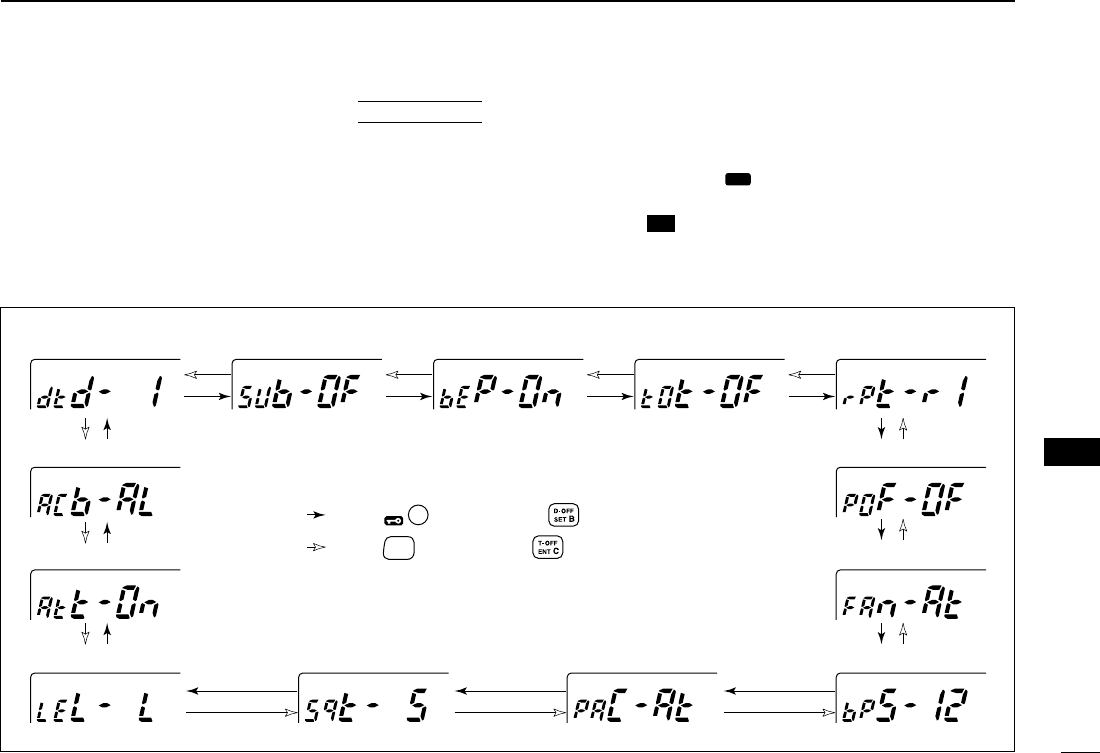
60
11
OTHER FUNCTIONS
New2001
11
■Initial set mode
The initial set mode is accessed at power ON and al-
lows you to set seldom-changed settings. In this way,
you can “customize” transceiver operations to suit your
preference and operating style.
•Initial set mode items
DDEntering initial set mode
qWhile pushing
[SET•]
push [PWR] for 1 sec. to enter
initial set mode.
wPush
[SET•]
or [LOW•PRIO] to select the desired item.
eRotate left band’s [DIAL] to select the condition or value.
rPush [PWR] momentarily to exit initial set mode.
AT
POWER ON
MAIN
T X
MAIN
T X
MAIN
T X
DUP
MAIN
T X
MAIN
T X
MAIN
T X
MAIN
T X
MAIN
T X
MAIN
T X
MAIN
T X
MAIN
T X
MAIN
T X
MAIN
T X
• Active band
• Key-touch beep • Time-out timer • Auto repeater*
• Squelch attenuator
• Microphone sensitivity
• Sub band mute
• Auto power off
• DTMF speed
• Squelch delay • Packet operation band • Data speed
• Cooling fan
*Available in the USA version only.
: Push (front panel); or (microphone)
SET
: Push (front panel); or (microphone)
LOW
PRIO
IC-2720H.qxd 02.9.9 8:12 Page 60 (1,1)
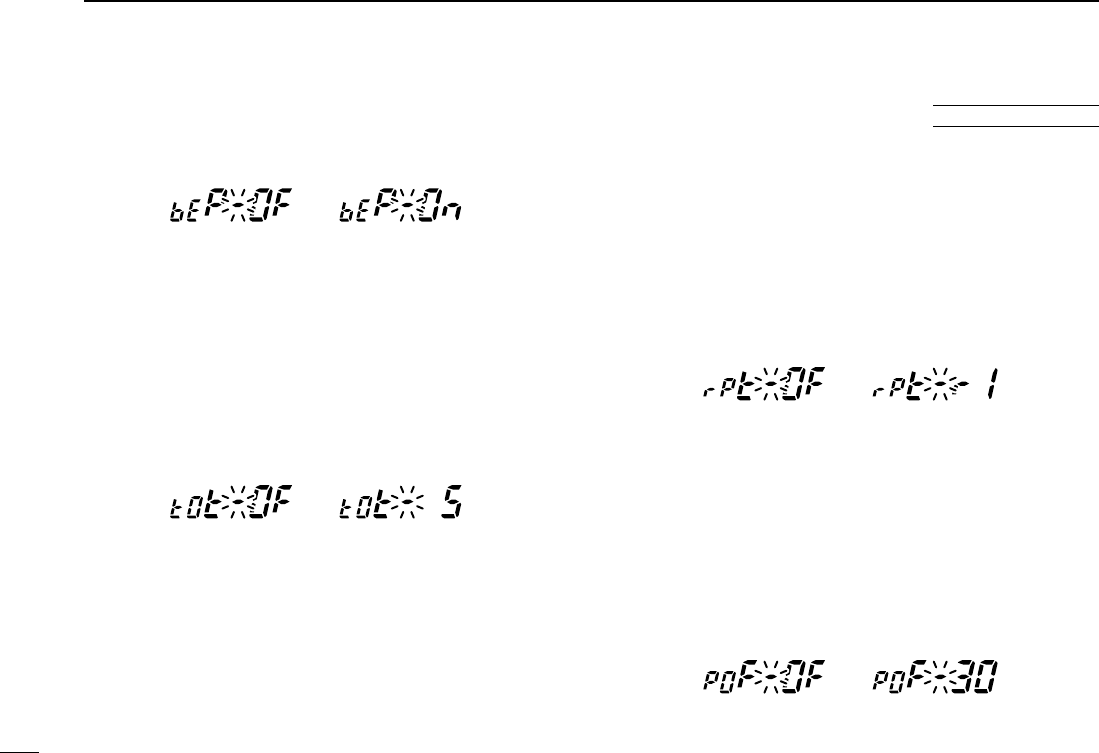
61
11 OTHER FUNCTIONS
New2001
DDKey-touch beep
The key-touch beep can be turned OFF for silent operation.
(default: ON)
DDTime-out timer
To prevent accidental prolonged transmission, etc., the trans-
ceiver has a time-out timer. This function cuts a transmission
OFF after 1–30 min. of continuous transmission. This timer
can be cancelled.
•TOT-OF : The time-out timer is turned OFF.
(default)
•TOT-3/5/15/30 : The transmission is cut OFF after the
set period elapses.
DDAuto repeater
The auto repeater function automatically turns ON or OFF the
duplex operation with a specified shift direction and tone en-
coder, when the operating frequency falls within or outside of
145.200–145.495, 146.610–146.995, 147.000–147.395,
442.000–444.995, and 447.000–449.995 MHz range. The off-
set and repeater tone frequencies are not changed by the
auto repeater function, reset these frequencies, if necessary.
•OF : The auto repeater function is turned OFF.
•r1 : Activates for duplex only. (default)
•r2 : Activates for duplex and tone.
DDAuto power OFF
The transceiver can be set to automatically turn OFF after a
specified period with a beep when no key operations are per-
formed.
30 min., 1 hour, 2 hours and OFF (default) can be specified.
The specified period is retained even when the transceiver is
turned OFF by the auto power OFF function. To cancel the
function, select “OF” in this set mode.
MAIN
T X
M
MAIN
T X
M
MAIN
T X
M
MAIN
T X
DUP
M
U.S.A. version only
MAIN
T X
M
MAIN
T X
M
MAIN
T X
M
MAIN
T X
M
IC-2720H.qxd 02.9.9 8:12 Page 61 (1,1)
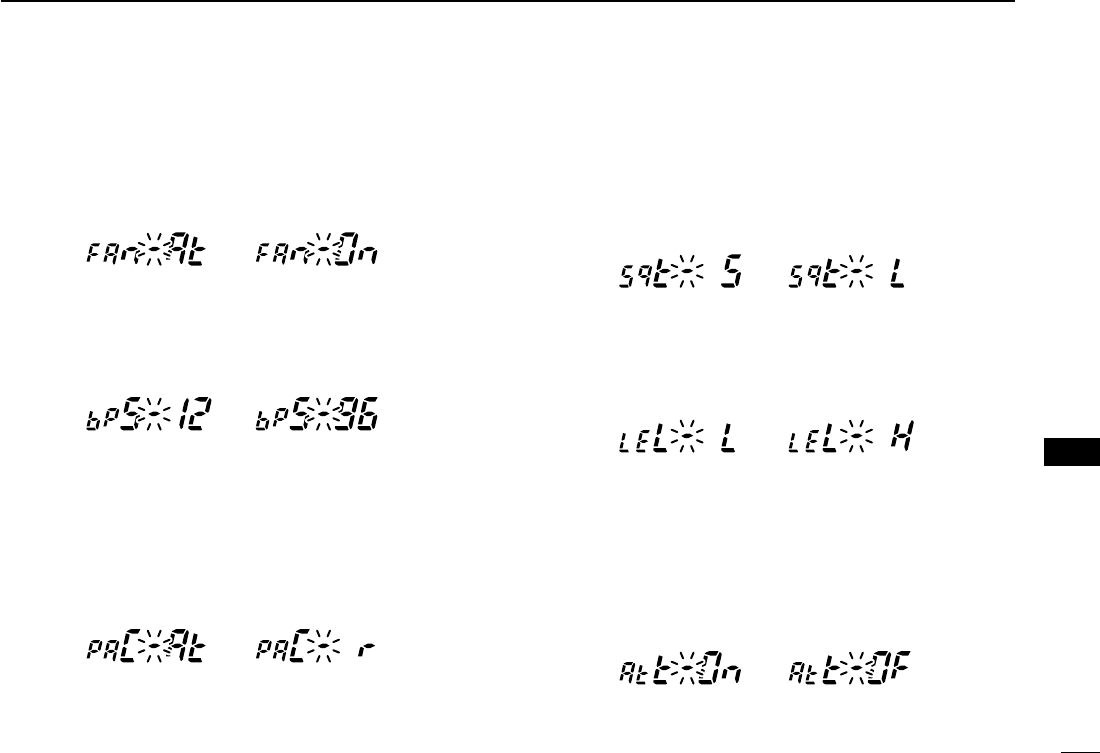
62
11
OTHER FUNCTIONS
New2001
11
DDCooling fan control
Selects the cooling fan control condition from Auto and ON.
•Auto (At) : The fan rotates during transmit and for 2 min.
after transmission.
•ON (On) : The fan continuously rotates.
DDData transmission speed
Selects the data transmission speed for packet operation
from 1200 bps (default) and 9600 bps.
DDPacket operation band
Selects the packet operation band from auto, right and left.
•Auto (At) : The main band is used for packet op-
eration.
•Left (L)/Right (r) : The selected left or right band can
only be operated for packet.
DDSquelch delay
Selects squelch delay from short and long to prevent re-
peated opening and closing of the squelch during reception
of the same signal.
•S : Short squelch delay. (default)
•L : Long squelch delay
DDMicrophone sensitivity
Selects the microphone sensitivity from high (H) and low (L)
to suits your preference.
DDSquelch attenuator
Turns the squelch attenuator function ON and OFF.
•ON : The squelch attenuator activates when [SQL]
control is set between 12 o’clock and fully
clockwise position. (default)
•OF : The squelch attenuator does not function.
MAIN
T X
M
MAIN
T X
M
MAIN
T X
M
MAIN
T X
M
MAIN
T X
M
MAIN
T X
M
MAIN
T X
M
MAIN
T X
M
MAIN
T X
M
MAIN
T X
M
MAIN
T X
M
MAIN
T X
M
IC-2720H.qxd 02.9.9 8:12 Page 62 (1,1)
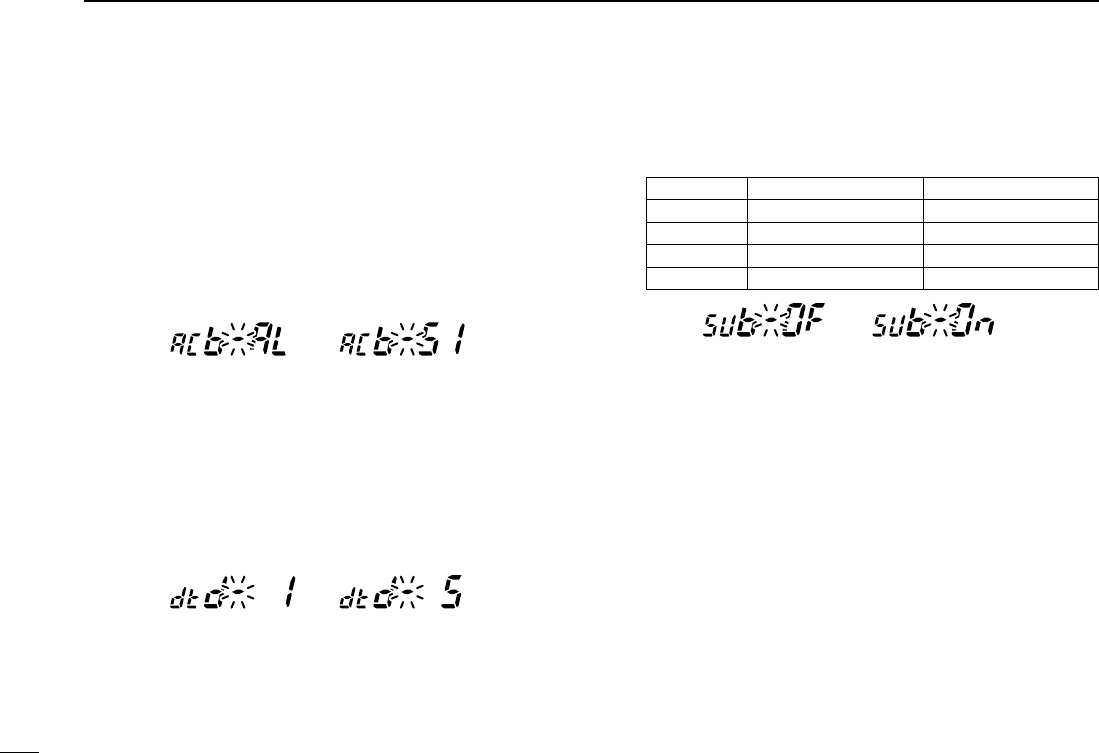
63
11 OTHER FUNCTIONS
New2001
DDActive band
Selects the frequency selecting condition via [DIAL] or [Y]/[Z]
on the microphone from all (AL) and single (SI).
•All (AL) : The operating frequency can be selected
continuously. (default)
•Single (SI) :
The operating frequency can be selected
within the current band. Pushing
[MAIN•BAND] for 1 sec. then tuning dial rota-
tion is necessary for frequency band selection.
DDDTMF speed
The rate at which DTMF memories send individual DTMF
characters can be set to accommodate operating needs.
•1 : 100 msec. interval; 5.0 cps speed (default)
•2 : 200 msec. interval; 2.5 cps speed
•3 : 300 msec. interval; 1.6 cps speed
•5 : 500 msec. interval; 1.0 cps speed
DDSub band mute
Turns the sub band function with sub band busy beep capa-
bility ON and OFF.
MAIN
T X
M
MAIN
T X
M
MAIN
T X
M
MAIN
T X
M
MAIN
T X
M
MAIN
T X
M
DISPLAY SUB BAND MUTE BUSY BEEP
SUb-OF OFF OFF
SUb-OF SOFF ON
SUb-On ON OFF
SUb-On SON ON
IC-2720H.qxd 02.9.9 8:12 Page 63 (1,1)
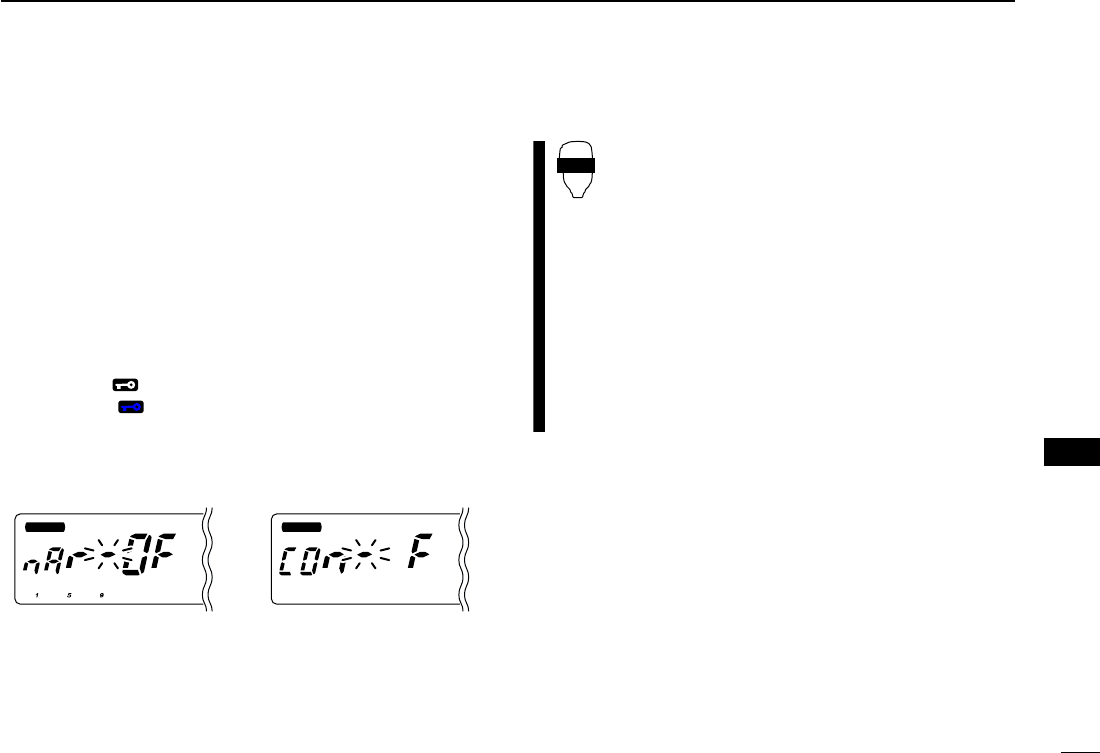
64
11
OTHER FUNCTIONS
New2001
11
■AM/FM narrow mode [
The IC-2720H has AM mode reception for both the left and
right bands, and FM narrow mode is available for the left
band. Typically, AM mode is used for the air band
(118–135.995 MHz).
The FM narrow mode selection is available for the USA ver-
sion’s left band only.
qSelect the desired frequency band in VFO mode, or the de-
sired memory channel on the left or right band as desired.
•If you want to select FM narrow mode, select the desired fre-
quency band or memory channel on the left band.
wPush
[SET•] to enter set mode.
ePush [SET•] or [LOW•PRIO] to select “nAr” item or
“COn” item.
•Select “nAr” for Wide/Narrow setting.
•Select “COn” for operating mode setting.
rRotate the same band’s [DIAL] to select FM narrow or AM
as desired.
•“AM” appears when AM mode is selected.
tPush [TONE•DTMF] to exit set mode.
zPush [BAND] to select the desired band (left or
right) as the main band.
•If you want to select FM narrow mode, select the de-
sired frequency band or memory channel on the left
band.
xSet the desired frequency or memory channel.
cPush [
SET
B(D-OFF)] to enter set mode.
vPush [
SET
B(D-OFF)] or [
ENT
C(T-OFF)]
to select
“nAr” item or “COn” item.
•Select “nAr” for Wide/Narrow setting.
•Select “COn” for operating mode setting.
bPush [Y]/[Z]
to select FM narrow or AM as de-
sired.
nPush [
CLR
A(MW)] to exit set mode.
SET
B
MAIN
T X
M
MAIN
T X
M
• Wide/Narrow setting • Operating mode setting
IC-2720H.qxd 02.9.9 8:12 Page 64 (1,1)
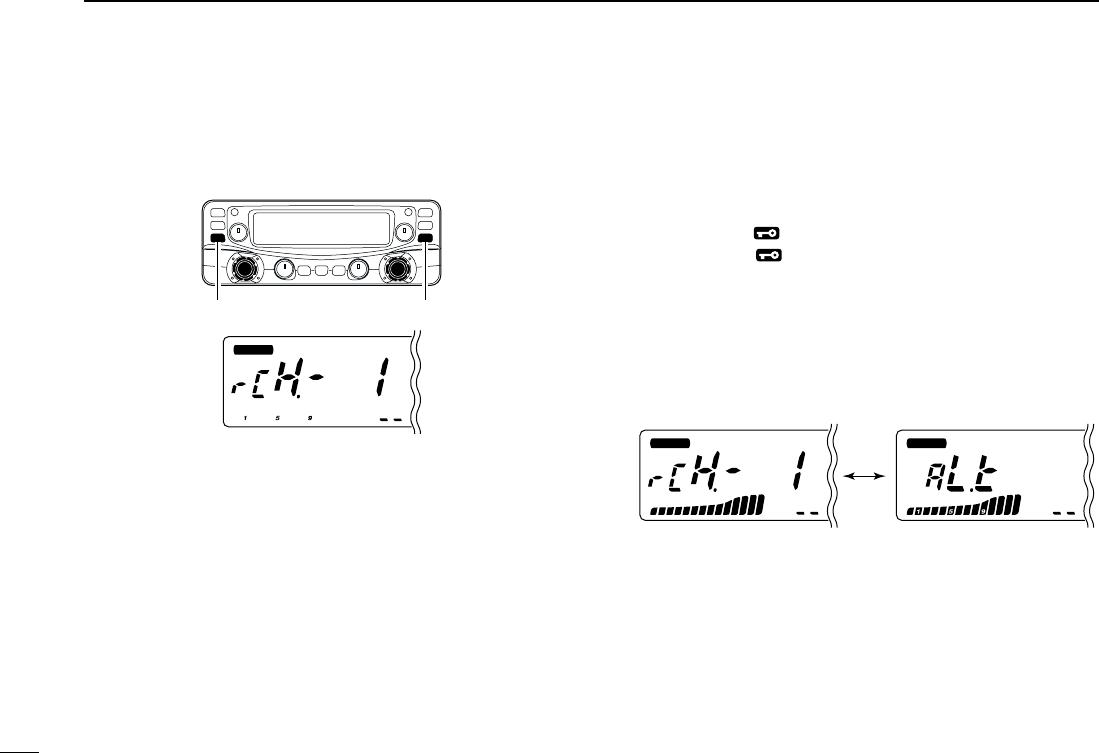
65
11 OTHER FUNCTIONS
New2001
■Weather channel operation
(USA version only)
DDWeather channel selection
qPush the desired band’s [M/CALL•MW] several times to
select weather channel group.
wRotate the same band’s [DIAL] to select the desired
weather channel.
ePush the [M/CALL•MW] to select memory mode, or push
the [V/MHz•SCAN] to select VFO mode.
DDWeather alert function
NOAA broadcast stations transmit weather alert tones before
important weather announcements. When the weather alert
function is turned ON, the selected weather channel is moni-
tored each 5 sec. for the announcement. When the alert sig-
nal is detected, the “AL.t” and the WX channel are displayed
alternately and sounds a beep tone until the transceiver is op-
erated. The previously selected (used) weather channel is
checked periodically during standby or while scanning.
qSelect the desired weather channel.
wTurn the weather alert function ON in set mode.
➥Push
[SET•]
to enter set mode.
➥Push
[SET•]
or [LOW•PRIO] to select the weather
alert item, then rotate the [DIAL] to set ON.
➥Push [TONE•DTMF] to exit set mode.
eSets the desired stand-by condition.
•Selects VFO, memory or call channel.
•Scan or priority watch operation can also be selected.
rWhen the alert is detected, a beep sounds and the follow-
ing indication will be displayed.
tTurn the weather alert function OFF in set mode.
☞NOTE: While receiving a signal (on a frequency other than
the weather alert ON frequency), the receiving signal or
audio will be interrupted momentarily every 5 sec. (approx.)
in case the alert function is turned ON. This symptom is
caused by the WX alert function. To cancel these symp-
toms, set the weather alert item OFF in set mode.
BUSY
MAIN
T X
M
BUSY
MAIN
T X
M
Shows above indications alternately.
MAIN
T X
M
Push [M/CALL•MW] several times to select the WX channel group.
IC-2720H.qxd 02.9.9 8:12 Page 65 (1,1)
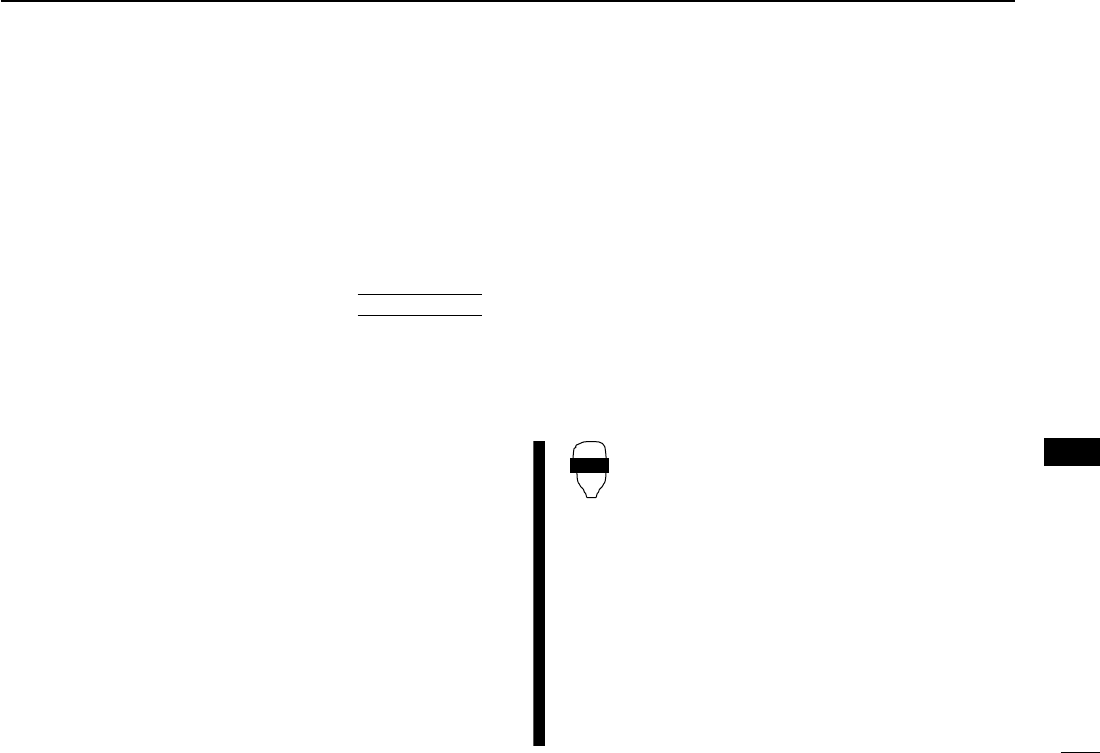
66
11
OTHER FUNCTIONS
New2001
11
■Microphone keys
The supplied HM-133’s (optional for some versions) [F-1] and
[F-2] keys memorize the transceiver conditions.
The [UP]/[DN] keys of the standard or an optional microphone
(other than the HM-133) can be assigned functions like the
function keys on the transceiver’s front panel.
DD[UP]/[DN] keys on a microphones
(other than HM-133)
The following functions are assigned to the [UP]/[DN] keys on
the other microphones (HM-118N/TAN, etc.) when first apply-
ing power.
•Default setting
[UP] : channel up; push and hold to start scan, push again
to stop scan.
[DN] : channel down; push and hold to start scan, push
again to stop scan.
➥Assigning a function
qTurn the power OFF.
wWhile pushing the desired switch on the transceiver and
one of either [UP]/[DN] keys on the microphone, turn the
power ON.
•The function is programmed into the key.
➥Clearing an assignment
qTurn the power OFF.
wWhile pushing the desired [UP] or [DN] key on the micro-
phone, turn the power ON.
DD[F-1]/[F-2] keys on HM-133
The following conditions in the main band or both left and
right bands can be memorized into [F-1] and [F-2] keys, in-
dependently.
•Operating frequency
•Repeater setting (offset direction and frequency, tone ON/OFF
and frequency)
•Tone/DTCS squelch (ON/OFF, frequency/code and polarity)
•Transmit output power selection
•Tuning step
•Operating mode selection (FM/AM)
•Set mode settings*
•Initial set mode settings*
*Only when storing both bands conditions
➥Programming the both bands condition
After setting the desired contents of each
condition in the both bands, push [FUNC]
then push [F-1]/[F-2] for 1 sec.
•3 beeps sound.
➥Recalling the both bands condition
Push [FUNC] then [F-1]/[F-2] momentarily.
➥Programming the main band condition
Set the desired contents of each condition in
the main band, then push [F-1]/[F-2] for 1 sec.
•3 beeps sound.
➥Recalling the main band condition
Push [F-1]/[F-2] momentarily.
[F-1]/[F-2]
AT
POWER ON
IC-2720H.qxd 02.9.9 8:12 Page 66 (1,1)
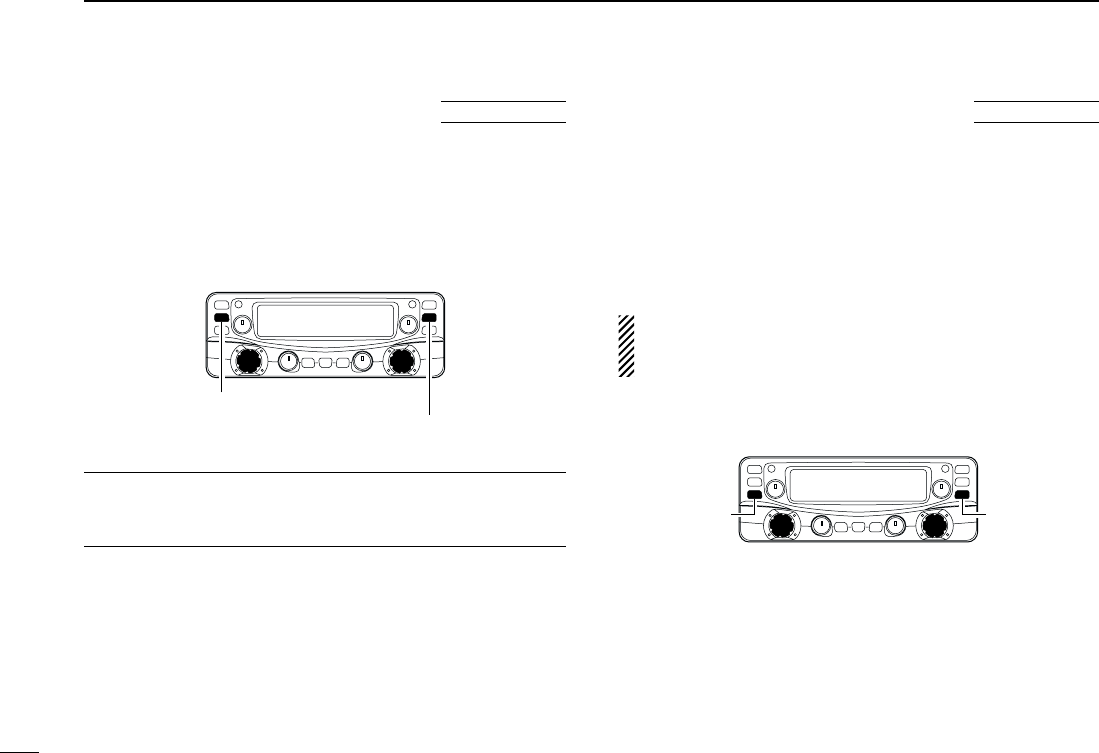
67
11 OTHER FUNCTIONS
New2001
■Partial reset
If you want to initialize the operating conditions (VFO fre-
quency, VFO settings, set mode contents) without clearing
the memory contents, a partial resetting function is available
for the transceiver left and right bands independently.
➥While pushing desired band’s [V/MHz•SCAN], turn the
power ON to partially reset the desired band (left or right).
✔
Hint!
When pushing both [V/MHz•SCAN] and turning the power
ON, partially reset both bands at the same time.
■ALL reset
The function display may occasionally display erroneous in-
formation (e.g. when first applying power). This may be
caused externally by static electricity or by other factors.
If this problem occurs, turn power OFF. After waiting a few
seconds, turn power ON again. If the problem persists, per-
form the following procedure.
•Partial resetting is also available. See left for details.
IMPORTANT!:
Resetting the transceiver CLEARS all memory information
and initializes all values in the transceiver.
➥While pushing both band’s [M/CALL•MW], turn the power
ON to reset the CPU.
[M/CALL•MW]
While pushing both [M/CALL•MW], turn power ON.
[M/CALL•MW]
AT
POWER ON
Left band partial reset.
Right band partial reset.
AT
POWER ON
IC-2720H.qxd 02.9.9 8:12 Page 67 (1,1)
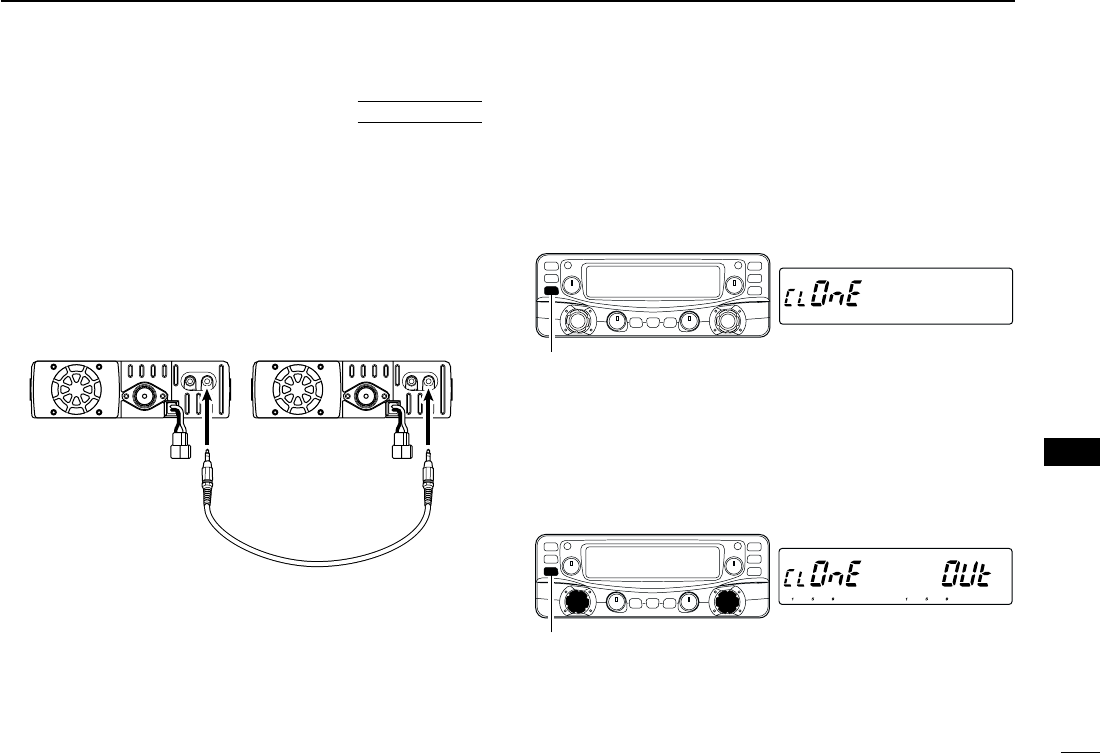
68
11
OTHER FUNCTIONS
New2001
11
■Data cloning
Cloning allows you to quickly and easily transfer the pro-
grammed contents from one transceiver to another; or , data
from a personal computer to a transceiver using the optional
CS-2720
CLONING SOFTWARE
.
DCloning between transceivers
qConnect the OPC-474 cloning cable to the [SP-2] jack of
the master and sub-transceivers.
•The master transceiver is used to send data to the sub-trans-
ceiver.
wWhile pushing left band’s [M/CALL•MW], turn power ON to
enter cloning mode (master transceiver only— power on
only for sub-transceiver).
•“CLOnE” appears and the transceivers enter the clone standby
condition.
ePush the same [M/CALL•MW] on the master transceiver.
•“CLOnE OUt” appears in the master transceiver’s display and
the S/RF indicators show that data is being transferred to the
sub-transceiver.
•“CLOnE In” appears automatically in the sub-transceiver’s dis-
play and the S/RF indicators show that data is being received
from the master transceiver.
rWhen cloning is finished, turn power OFF, then ON to exit
cloning mode.
MAIN
T X
MAIN
T X
MM
Pushing left band’s [M/CALL•MW] start cloning.
MAIN
T X
MAIN
T X
MM
While pushing left band’s [M/CALL•MW], turn power ON.
To [SP-2] To [SP-2]
AT
POWER ON
IC-2720H.qxd 02.9.9 8:12 Page 68 (1,1)
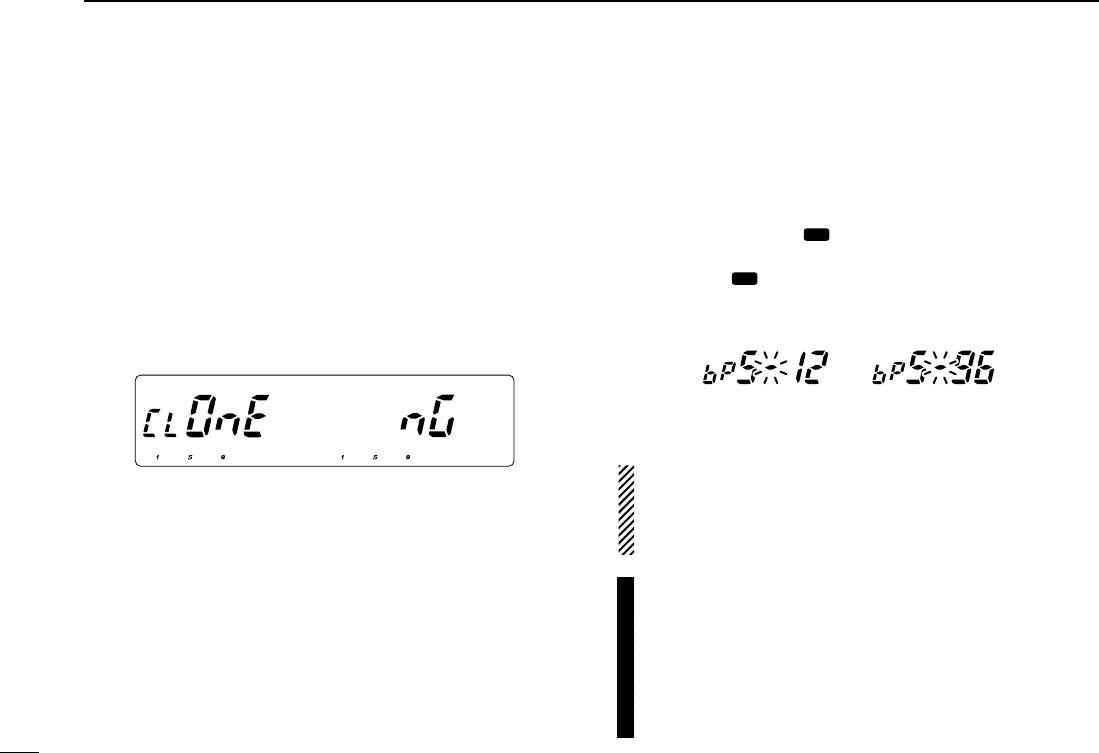
69
11 OTHER FUNCTIONS
New2001
DCloning using a personal computer
Data can be cloned to and from a personal computer (Mi-
crosoft®Windows®98/2000/Me/XP) using the optional CS-
2720
CLONING SOFTWARE
and the optional cloning cable
OPC-478U (USB type) or OPC-478 (RS-232C type). Consult
the CS-2720
CLONING SOFTWARE
HELP file for details.
DCloning error
☞NOTE: DO NOT push any key on the sub-transceiver dur-
ing cloning. This will cause a cloning error.
When the display as below appears, a cloning error has oc-
curred.
In such a case, both transceivers automatically return to the
clone standby condition and cloning must be repeated.
■Packet operation
DData speed
For packet operation, the transceiver can be set to one of two
data speeds: 1200 bps (default) or 9600 bps.
qWhile pushing
[SET•]
turn power ON to enter initial set
mode.
wPush
[SET•]
or [LOW•PRIO] to select the ‘bPS’item.
eRotate the left band [DIAL] to select the desired data
speed.
rPush [PWR] to exit initial set mode.
For 1200 bps operation—
•Disconnect the microphone plug from the microphone
connector during data transmission, otherwise the data
signal and voice signal are simultaneously transmitted.
For 9600 bps operation—
•When the transceiver is set for 9600 bps data transmis-
sion in set mode, the microphone signal is automatically
cut. Therefore, it is not necessary to disconnect the mi-
crophone plug from the connector in this case.
•
When pushing [PTT] during data transmission, data trans-
mission is interrupted and voice signals have priority.
MAIN
T X
M
MAIN
T X
M
MAIN
T X
MAIN
T X
MM
Microsoft and Windows are registered trademarks of Microsoft Corporation in
the U.S.A. and other countries.
IC-2720H.qxd 02.9.9 8:12 Page 69 (1,1)
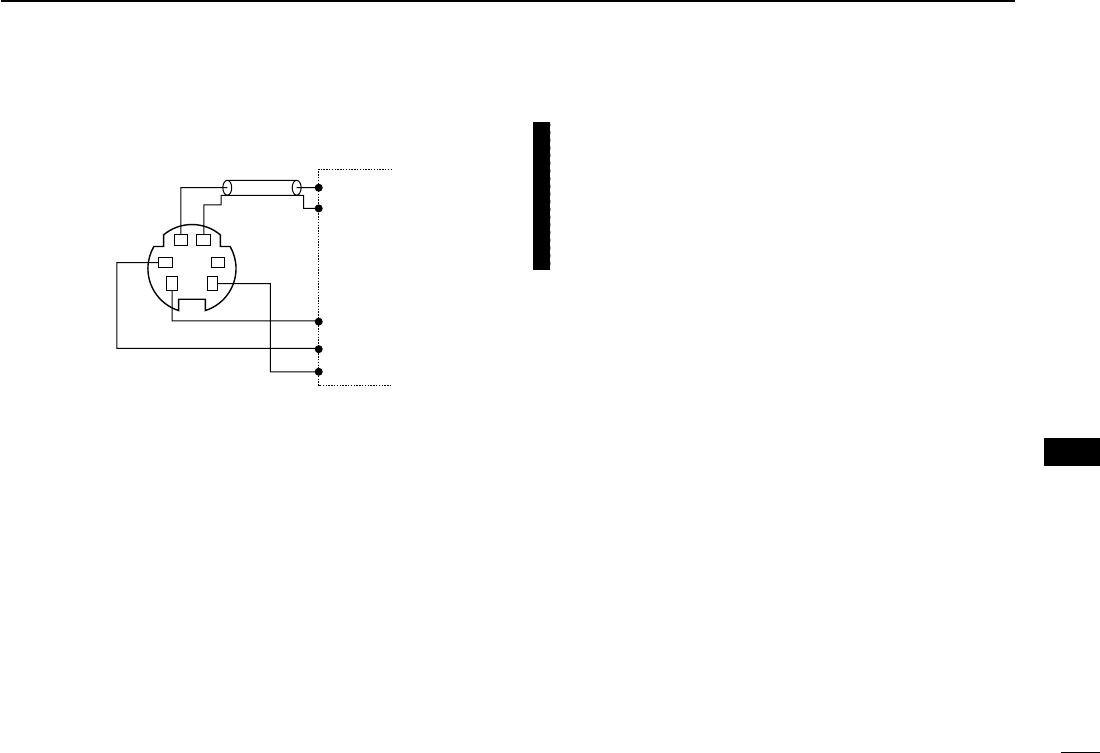
70
11
OTHER FUNCTIONS
New2001
11
D1200 bps packet operation
qConnect the transceiver and a TNC as illustrated below.
wSet the TNC for transmit.
eSet transmit delay on the TNC to 30–50.
rAdjust the TNC frequency deviation if necessary.
•When using a deviation meter:
Adjust the output of the TNC so that frequency deviation
is in the range ± 3 to ±4 kHz.
•When NOT using a deviation meter:
A receiver or transceiver is needed to monitor the trans-
mission—compare the received audio output level when
receiving a TNC modulated signal with high level voice
signals using the microphone. Then adjust the TNC mod-
ulated signal to a lower level than the voice modulated
signal.
•Read the instructions supplied with your TNC carefully
before attempting packet operation with the transceiver.
•Pin tAF OUT is for 1200 bps operation only. This pin
cannot be used for 9600 bps operation.
•Over modulation may degrade signal quality. If you find
that many transmissions are failing, re-adjust the modu-
lation level.
SQL
PTT
RX AUDIO
GND
TX AUDIO
TNC side
q DATA IN
w GND
e PTT P
t AF OUT
y P SQL
IC-2720H.qxd 02.9.9 8:12 Page 70 (1,1)
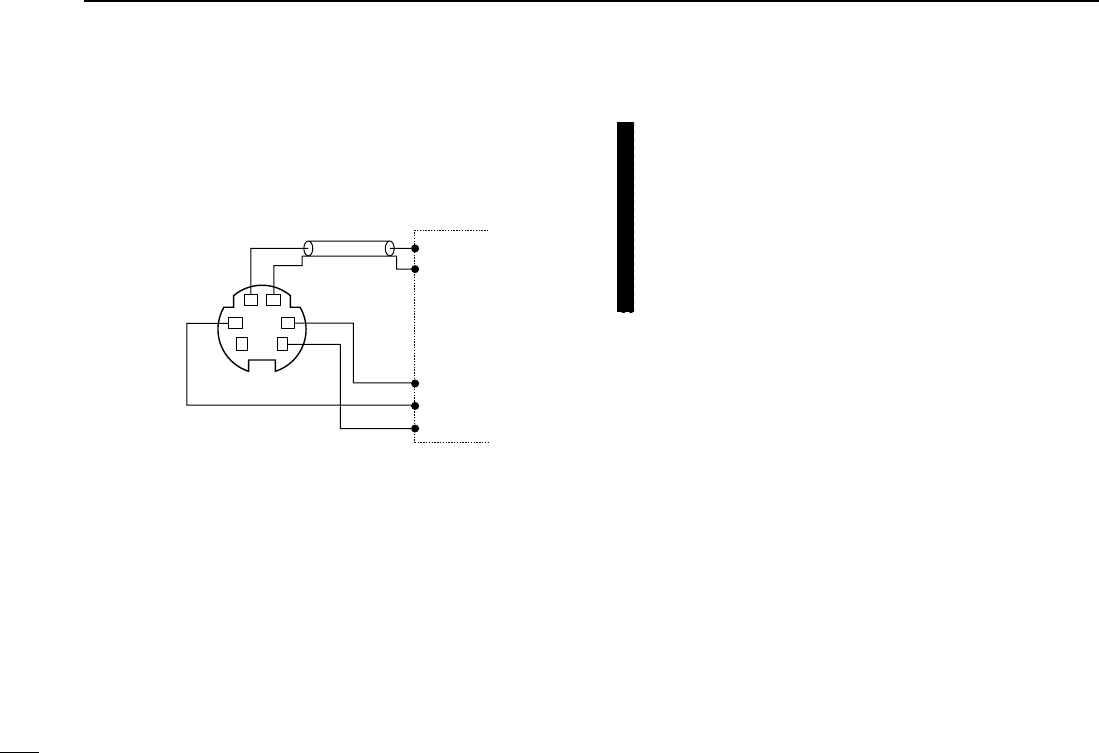
71
11 OTHER FUNCTIONS
New2001
D9600 bps high speed packet operation
The transceiver supports 2 modes of 9600 bps packet opera-
tion: G3RUH and GMSK.
qConnect the transceiver and a TNC as illustrated below.
wG3RUH mode can handle 16 kinds of modulated wave
forms in order to maintain a communication link.
eSet transmit delay on the TNC to 30–50.
rAdjust the TNC frequency deviation if necessary (see page
at right).
•When using the PTT P terminal for packet operation, no
voice signals are transmitted from the microphone.
•When pushing [PTT] during data transmission, data
transmission is interrupted and the voice signal takes pri-
ority.
•Read the instructions supplied with your TNC carefully
before attempting packet operation with the transceiver.
•Pin rDATA OUT is for 9600 bps operation only. This pin
cannot be used for 1200 bps operation.
TNC side
SQL
PTT
RX AUDIO
GND
TX AUDIO
q DATA IN
w GND
e PTT P r DATA OUT
y P SQL
IC-2720H.qxd 02.9.9 8:12 Page 71 (1,1)
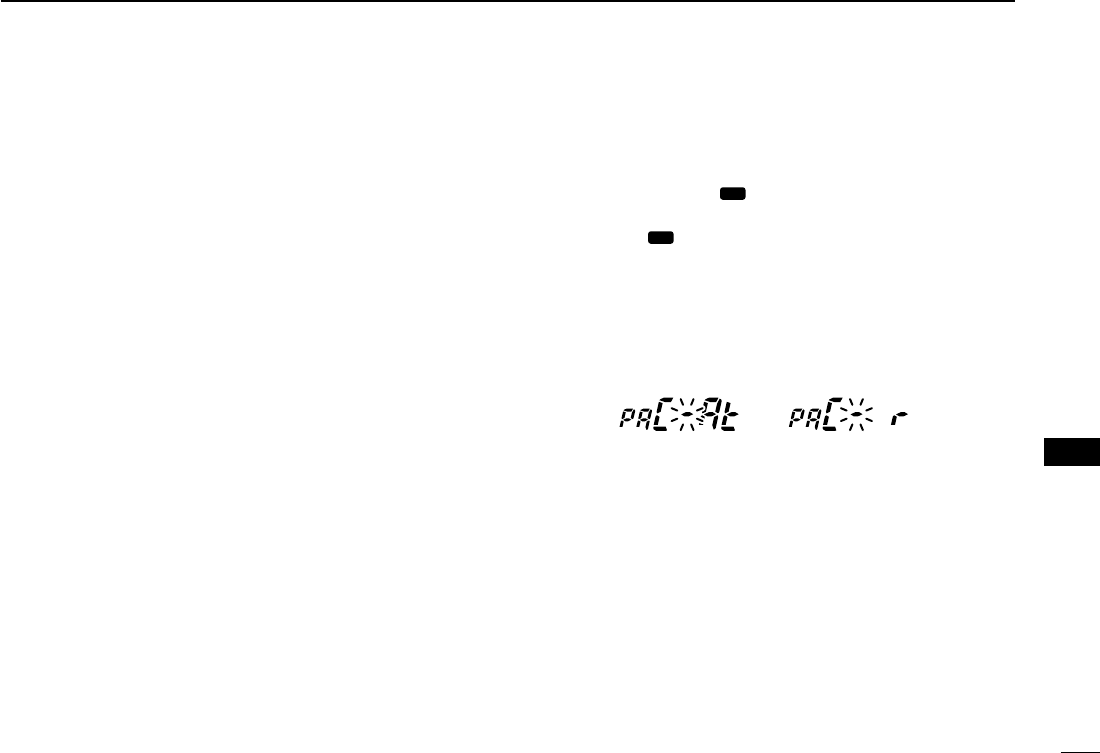
72
11
OTHER FUNCTIONS
New2001
11
DAdjusting the transmit signal output from
the TNC
When setting data transmission speed to 9600 bps, the data
signal coming from the TNC is applied exclusively to the in-
ternal limiter circuitry to automatically maintain band width.
NEVER apply data levels from the TNC of over 0.6 V p-p, oth-
erwise the transceiver will not be able to maintain the band
width and may possibly interfere with other stations.
1. When using a level meter or synchroscope, adjust the
TX audio output level (DATA IN level) from the TNC as
follows.
0.4 V p-p (0.2 V rms) : recommended level
0.2 V p-p–0.5 V p-p (0.1–0.25 V rms) : acceptable level
2. When NOT using a measuring device.
qConnect the transceiver to a TNC.
wEnter a test mode (“CAL”, etc.) on the TNC, then trans-
mit some test data.
eWhen the transceiver fails to transmit the test data or
transmits sporadically (TX indicator doesn’t appear or
flashes):
- Decrease the TNC output level until the transmit indi-
cator lights continuously.
When transmission is not successful even though the
TX indicator lights continuously:
- Increase the TNC output level.
DPacket operation band selection
Both bands, or either the left or right band only, can be spec-
ified for packet operation to suit your preference.
qWhile pushing
[SET•]
turn power ON to enter initial set
mode.
wPush
[SET•]
or [LOW•PRIO] to select the ‘PAC’item.
eRotate the left band [DIAL] to select the desired band from
auto (At; default), left (L) and right (r).
•Auto (At) : The main band is used for packet oper-
ation.
•Left (L)/Right (r) : The selected left or right band can only
be used for packet operation.
rPush [PWR] to exit initial set mode.
MAIN
T X
M
MAIN
T X
M
IC-2720H.qxd 02.9.9 8:12 Page 72 (1,1)
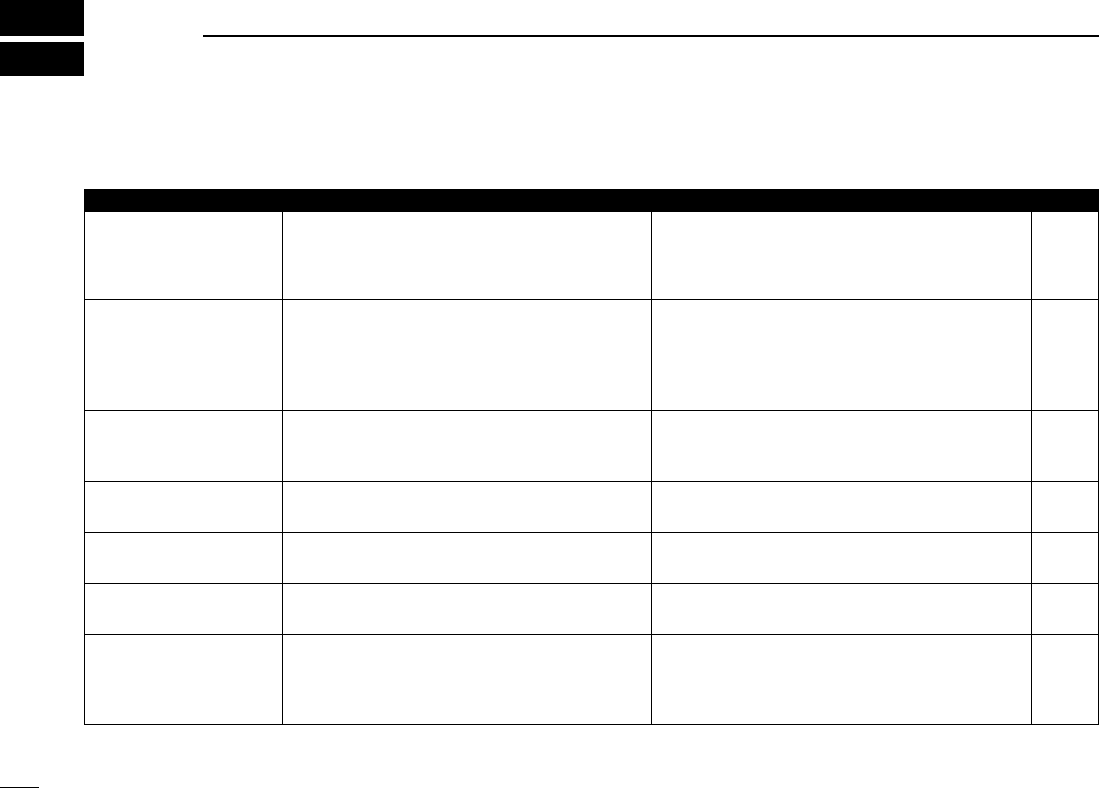
73
MAINTENANCE
New2001
12
PROBLEM POSSIBLE CAUSE SOLUTION REF.
■Troubleshooting If your transceiver seems to be malfunctioning, please check
the following points before sending it to a service center.
Does not turn on.
No sound comes from the
speaker.
Sensitivity is low and only
strong signals are audible.
No contact possible with
another station.
Repeater cannot be ac-
cessed.
Frequency cannot be set.
Frequency cannot be set
via the microphone.
•Power connector has a poor contact.
•Polarity of the power connection is reversed.
•Blown fuse.
•Volume is too low.
•The audio mute function is activated.
•Squelch is set too high.
•A selective call or squelch function is activated
such as pocket beep or tone squelch.
•Antenna feedline or the antenna connector has a
poor contact or is short circuited.
•Squelch attenuator function is activated.
•The other station is using tone squelch.
•The transceiver is set to duplex.
•Wrong offset frequency is programmed.
•Wrong subaudible tone frequency is programmed.
•The frequency lock function is activated.
•Priority watch is paused on the watching frequency.
•The frequency lock function is activated.
•The microphone keypad lock function is activated.
•Priority watch is paused on the watching fre-
quency.
•Check the connector pins.
•Re-connect the power cable observing the proper
polarity. Replace the fuse if damaged.
•Check the cause, then replace the fuse.
•Rotate [VOL] clockwise.
•Push any switch or key to deactivate it.
•Set the squelch level to the threshold.
•Turn the appropriate function OFF.
•Check, and if necessary, replace the feedline or sol-
der the antenna connector again.
•Set [SQL] between 10–12 o’clock position.
•Turn the tone squelch function ON.
•Set to simplex.
•Correct the offset frequency.
•Correct the subaudible tone frequency.
•Turn the function OFF.
•Push [LOW•PRIO] for 1 sec. to cancel the watch.
•Turn the function OFF
•Push [FUNC] then [
SQL
Z#(16KEY-L)] to deactivate
the microphone keypad lock function.
•Push [LOW•PRIO] for 1 sec. to cancel the watch.
—
pgs. VI,
74
p. 74
p. 16
p. 21
p. 16
pgs. 52,
53, 54
p. VII
p. 17
p. 54
p. 23
p. 27
p. 25
p. 15
p. 47
p. 15
p. 15
p. 47
IC-2720H.qxd 02.9.9 8:12 Page 73 (1,1)
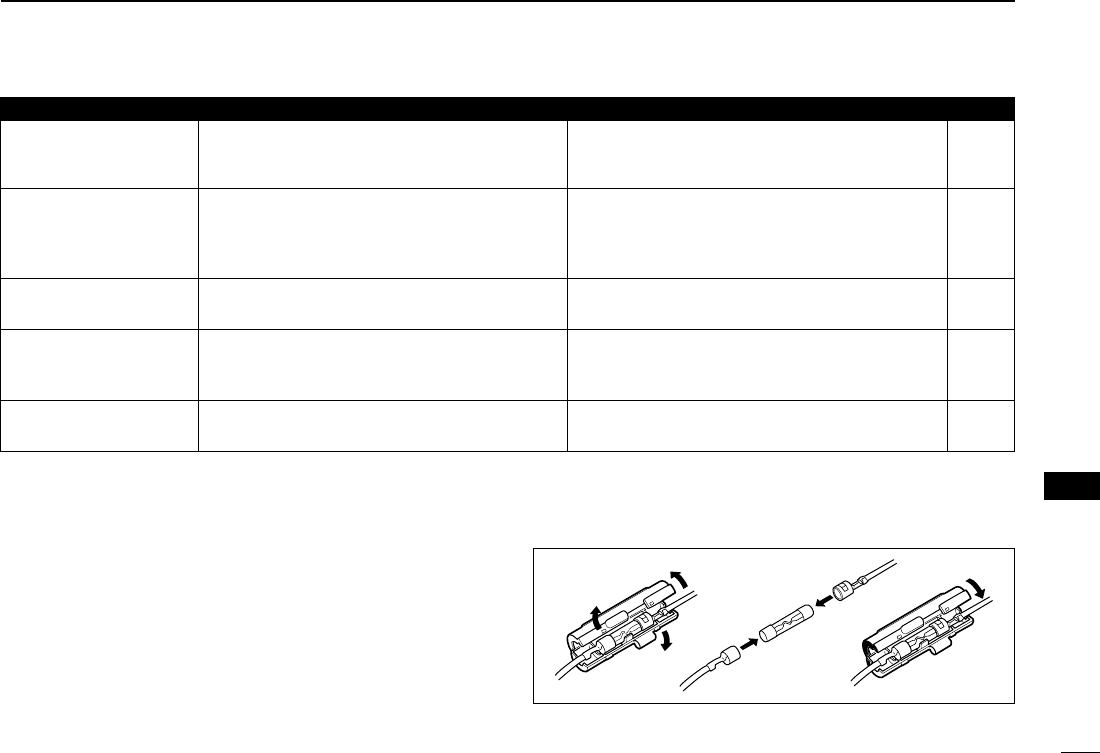
74
12
MAINTENANCE
New2001
12
PROBLEM POSSIBLE CAUSE SOLUTION REF.
Some memory channels
cannot be selected via the
tuning dial.
Scan does not operate.
Transmission is automati-
cally cut off.
Transmission continues
even when the PTT is re-
leased.
The function display shows
erroneous information.
•The memory channel number has not yet been
programmed.
•The squelch is open.
•Only 1 memory channel is programmed or other
channels are set as skip channels.
•Priority watch is activated.
•Time-out timer is activated.
•One-touch PTT function is activated.
•The CPU is malfunctioning.
•Select the channel via the microphone keypad to
check whether the channel has been programmed
or not.
•Set the squelch to the threshold point.
•Program other memory channels or cancel the
memory skip function in the desired channels.
•Cancel the watch.
•Set the timer to OFF.
•Turn the function OFF.
•Reset the CPU.
—
p. 16
pgs. 30,
31, 44
p. 47
p. 61
p. 21
p. 67
■Fuse replacement
If the fuse blows or the transceiver stops functioning, find the
source of the problem if possible, and replace the damaged
fuse with a new, rated one (FGB 20 A) as shown at right.
20 A
fuse
IC-2720H.qxd 02.9.9 8:12 Page 74 (1,1)
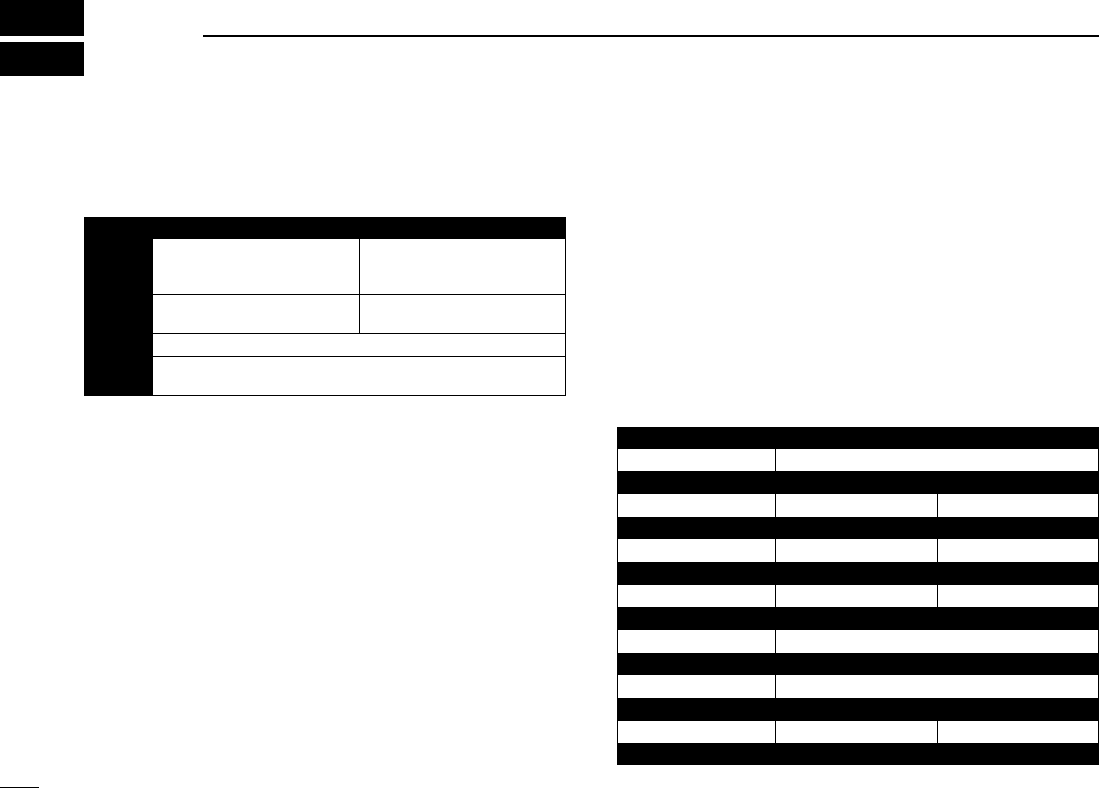
75
SPECIFICATIONS AND OPTIONS
New2001
13
■Specifications
DDGENERAL
•Frequency coverage : (unit: MHz)
*1Guaranteed: 144–148 MHz range only.; *2Guaranteed: 440–450 MHz range for the USA,
430–440 MHz for the General version; *3Not guaranteed; *4824.010 to 848.990 and
869.010 to 893.990 MHz ranges are inhibited for USA version and not guaranteed.
•Type of emission : FM, AM (Receive only)
•Number of memory channels : 212 (incl. 10 scan edges and 2 calls)
•Frequency resolution : 5, 10, 12.5, 15, 20, 25, 30, 50 kHz
•Operating temperature range : –10°C to +60°C; +14˚F to +140˚F
•Frequency stability : ±10 ppm (–10°C to +60°C)
•Power supply requirement : 13.8 V DC ±15%
•Current drain (at 13.8 V DC: approx.):
Transmit at 50 W 12 A
Receive standby 1.2 A
(simultaneous receive) max. audio 1.8 A
•Antenna connector : SO-239 (50 Ω)
•Dimensions (proj. not included) :
Main Unit 140(W) ×40(H) ×187(D) mm
51⁄2(W)×19⁄16(H)×73⁄8(D) in
Remote controller 140(W) ×50(H) ×24.5(D) mm
51⁄2(W)×131⁄32(H)×31⁄32(D) in
•Weight (approx.) :
Main unit (incl. separation cable) 1.25 kg; 2 lb 12 oz
Remote controller 150 g; 5.3 oz
DDTRANSMITTER
•Modulation system : Variable reactance frequency modulation
•Output power : VHF 50/15/5 W* (approx.)
UHF 35/15/5 W* (approx.)
*25/15/5 W only for the Taiwan version.
•Max. frequency deviation : ±5.0 kHz (wide)
±2.5 kHz (narrow: Left band only)
•Spurious emissions : Less than –60 dB
•Microphone connector : 8-pin modular (600 Ω)
DDRECEIVER
•Receive system : Double-conversion superheterodyne
•Intermediate frequencies :
Left band 1st: 38.85 MHz, 2nd: 450 kHz
Right band 1st: 46.05 MHz, 2nd: 455 kHz
•Sensitivity (FM: at 12 dB SINAD/AM: at 10 dB S/N):
Frequency range Left band (µV) Right band (µV)
118–159.995 MHz 0.18/0.45
160–173.995 MHz 0.32/—0.2/—
174–179.995 MHz 0.32/—N/A
180–219.995 MHz 3.5/—N/A
220–259.995 MHz 0.32/0.79 N/A
260–349.995 MHz 3.2/5.6 N/A
350–374.995 MHz 0.32/1.0 N/A
375–399.995 MHz 0.22/0.63
400–429.995 MHz 0.22/—
430–450 MHz 0.18/—
450.005–499.995 MHz 0.22/—
500–549.995 MHz 0.32/—0.22/—
810–879.990 MHz N/A 0.45/—
880–999.990 MHz N/A 1.0/—
Version Left Band Right Band
USA, Rx: 118–549.995*1
Rx: 118–173.995*1, 375–549.995,*3
General Tx: 144–148, 430–450*2810–999.99*4
Tx: 144–148, 430–450*2
Asia Rx: 136–173.995,*1430–440 Rx: 136–173.995,*1430–440
Tx: 144–148, 430–440 Tx: 144–148, 430–440
Australia Tx/Rx: 144–148, 430–440
Taiwan, Tx/Rx: 144–146, 430–440
Korea
IC-2720H.qxd 02.9.9 8:12 Page 75 (1,1)

76
13
SPECIFICATIONS AND OPTIONS
New2001
13
•Squelch sensitivity†(threshold) : Less than 0.13 µV
•Selectivity†(typical) :
Wide More than 12 kHz/6 dB
Less than 30 kHz/60 dB
Narrow (USA only) More than 6 kHz/6 dB
Less than 20 kHz/60 dB
•Spurious and image rejection†: More than 60 dB
•
AF output power
†
(at 13.8 V DC)
: More than 2.4 W at 10% distortion with an
8Ωload
•Ext. speaker connectors : 3-conductor 3.5 (d) mm (1⁄8″)/8 Ω
†Guaranteed 144–148 MHz and 430–440 or 440–450 MHz ranges only.
■Options
HM-133
REMOTE
-
CONTROL MICROPHONE
Wired remote control microphone with key backlight. Same as that
supplied with the transceiver.
HM-118TAN/TN
DTMF MICROPHONE
HM-118N
HAND MICROPHONE
HS-62
FLEXIBLE MOBILE MICROPHONE
+ HS-15SB
SWITCH BOX
+ OPC-589
ADAPTER CABLE
For all-round mobile operation.
OPC-1154/OPC-1155
SEPARATION CABLES
A ferrite core is supplied with the OPC-1155 for the USA version.
Same as that supplied with the transceiver. 3.5 m (11.5 ft)
OPC-1156
CONTROLLER EXTENSION CABLE
Extends the supplied separation cable 3.5 m (11.5 ft)
MB-84
REMOTE CONTROLLER BRACKET
Same as that supplied with the transceiver.
MB-85
COMBINATION BRACKET
Used for single-body installation. 20 cm (77⁄8in) remote control cable
is supplied.
MB-65
MOUNTING BASE
Mounts the remote controller on to variety of place in vehicle. MB-84
is required for mounting.
MB-17A
MOBILE MOUNTING BRACKET
One-touch bracket. Transceiver main unit easily attached or re-
moved.
OPC-440/OPC-647
MIC EXTENSION CABLES
OPC-440: 5.0 m (16.4 ft); OPC-647: 2.5 m (8.2 ft)
OPC-441
SPEAKER EXTENSION CABLE
5.0 m (16.4 ft)
SP-7/SP-10
EXTERNAL SPEAKERS
SP-7: For base station use. Cable length: 1.0 m; 3.3 ft
SP-10: For all-round mobile operation. Cable length: 1.5 m; 4.9 ft
OPC-347/1132
DC POWER CABLES
OPC-347: 7.0 m (23 ft)
OPC-1132: 3.0 m (9.8 ft) Same as that supplied with the transceiver.
CS-2720
CLONING SOFTWARE
+OPC-478U
CLONING CABLE
Provides quick and easy programming items, such as memory chan-
nels, set mode contents for local repeater frequencies, via PC’s USB
terminal. RS-232C type cloning cable, OPC-478, also available.
OPC-474
CLONING CABLE
Used for data cloning between transceivers.
All stated specifications are subject to change without notice or obligation.
IC-2720H.qxd 02.9.9 8:12 Page 76 (1,1)
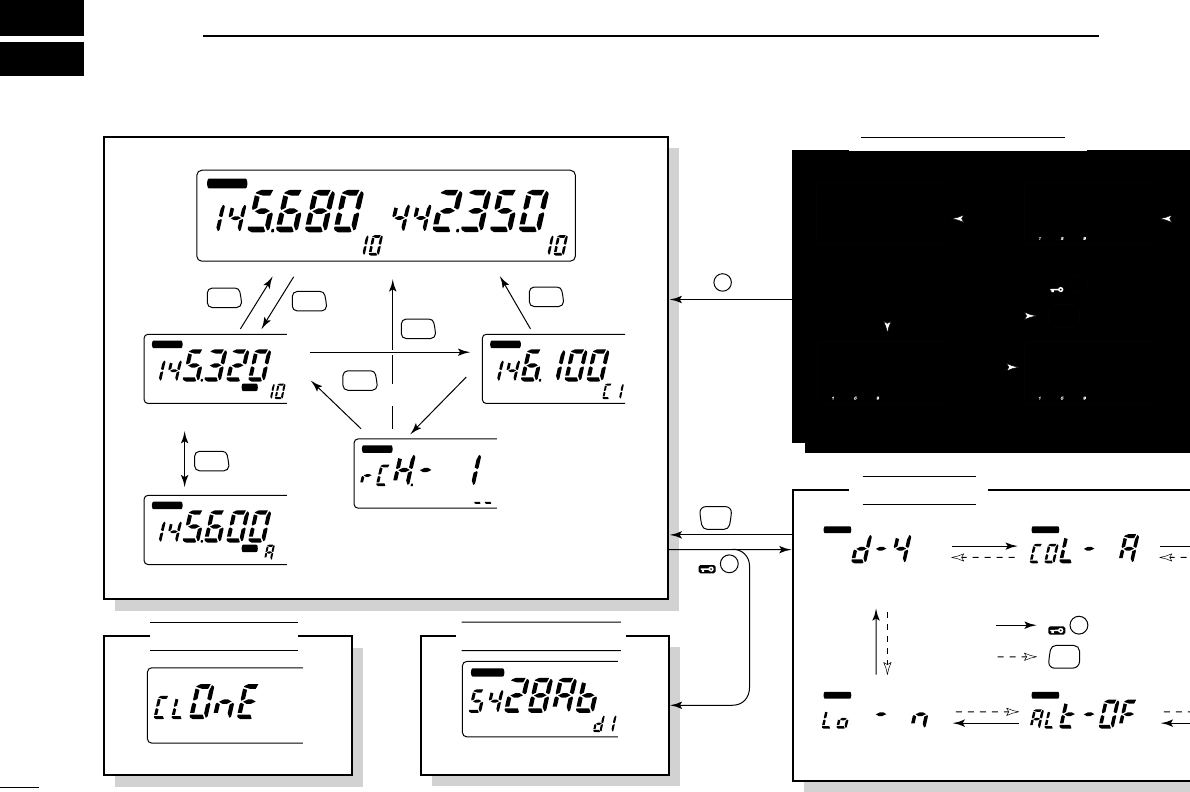
77
MODE ARRANGEMENT
New2001
14
MAIN
T X
M
MAIN
T X
M
MAIN
T X
M
MAIN
T X
M
MAIN
T X
M
MAIN
T X
DUP
M
MAIN
T X
MAIN
T X
M
MAIN
T X
M
MAIN
T X
M
MAIN
T X
M
MAIN
T X
M
MAIN
T X
M
MAIN
T X
M
MAIN
T X
M
MAIN
T X
M
MAIN
T X
T
M
MAIN
T X
M
MAIN
T X
M
MAIN
T X
M
M
MAIN
BAND
SCAN
V/MHz
SCAN
V/MHz
SCAN
V/MHz
MW
M/CALL
MW
M/CALL
TONE
DTMF
SET
SET
:
LOW
PRIO
:
SET
:
LOW
PRIO
:
PWR
Key-touch beep (p. 61) Time-out timer (p. 61) Auto repeater (p. 61)
(USA version only)
A
Active band (p. 63)DTMF speed (p. 63)Sub band mute (p. 63)
SET MODE
DTMF MEMORY
CLONE MODE
CALL CHANNEL (p. 38)
WEATHER CHANNEL (p. 65)
(USA version only)
BANK CHANNEL (p. 35)
MEMORY MODE (p. 29)
VFO mode (p. 12) INITIAL SET MODE
Display dimmer (p. 57) Display color (p. 57) Repeater tone frequency
(p. 57)
T
(
NMode selection (p. 59)*4
Weather alert*2 (p. 59)1st Lo frequency (p. 59)
When the DTMF
memory encoder is
activated.
See p. 48 for details.
See p. 68 for details.
for 1 sec.
IC-2720H.qxd 02.9.9 8:12 Page 77 (1,1)
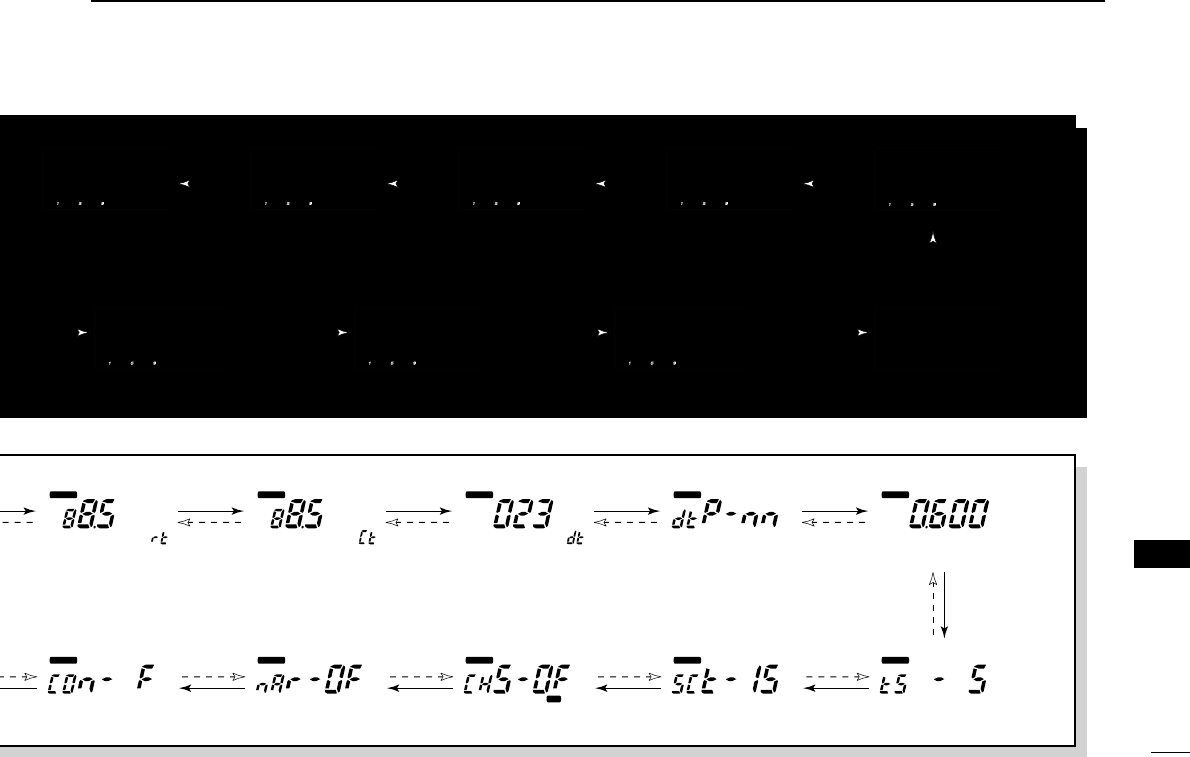
78
14
MODE ARRANGEMENT
New2001
14
MAIN
T X
M
MAIN
T X
M
MAIN
T X
M
MAIN
T X
M
MAIN
T X
M
MAIN
T X
M
MAIN
T X
DUP
M
MAIN
T X
M
MAIN
T X
M
MAIN
T X
M
MAIN
T X
M
MAIN
T X
M
MAIN
T X
M
MAIN
T X
M
MAIN
T X
M
MAIN
T X
M
MAIN
T X
M
MAIN
T X
M
MAIN
T X
T
M
MAIN
T X
T SQL
M
MAIN
T X
DTCS
M
MAIN
T X
DTCS
M
MAIN
T X
DUP
M
SET
:
LOW
PRIO
:
SET
:
LOW
PRIO
:
Time-out timer (p. 61) Auto repeater (p. 61)
(USA version only)
Auto power off (p. 61) Cooling fan (p. 62) Data speed (p. 62) Packet operation band (p. 62)
Squelch delay (p. 62)Microphone sensitivity (p. 62)Squelch attenuator (p. 62)Active band (p. 63)DTMF speed (p. 63)
MODE
Display color (p. 57) Repeater tone frequency
(p. 57)
Tone squelch frequency
(p. 57)
DTCS code (p. 57) DTCS polarity (p. 58) Offset frequency (p. 58)
Tuning step (p. 58)Scan resume timer (p. 58)Channel skip setting*1 (p. 58)Narrow setting*2*3 (p. 59)Mode selection (p. 59)*4
Weather alert*2 (p. 59)
*1Appears when accessing from memory mode only.
*2Available for USA versions only.
*3Appears when accessing set mode from left band only.
*4Does not appear when accessing set mode from 900 MHz band.
IC-2720H.qxd 02.9.9 8:12 Page 78 (1,1)

1-1-32 Kamiminami, Hirano-ku, Osaka 547-0003 Japan
A-6124D-1EX
Printed in Japan
©2002 Icom Inc.
New2001
IC-2720H.qxd 02.9.9 8:12 Page 79 (1,1)